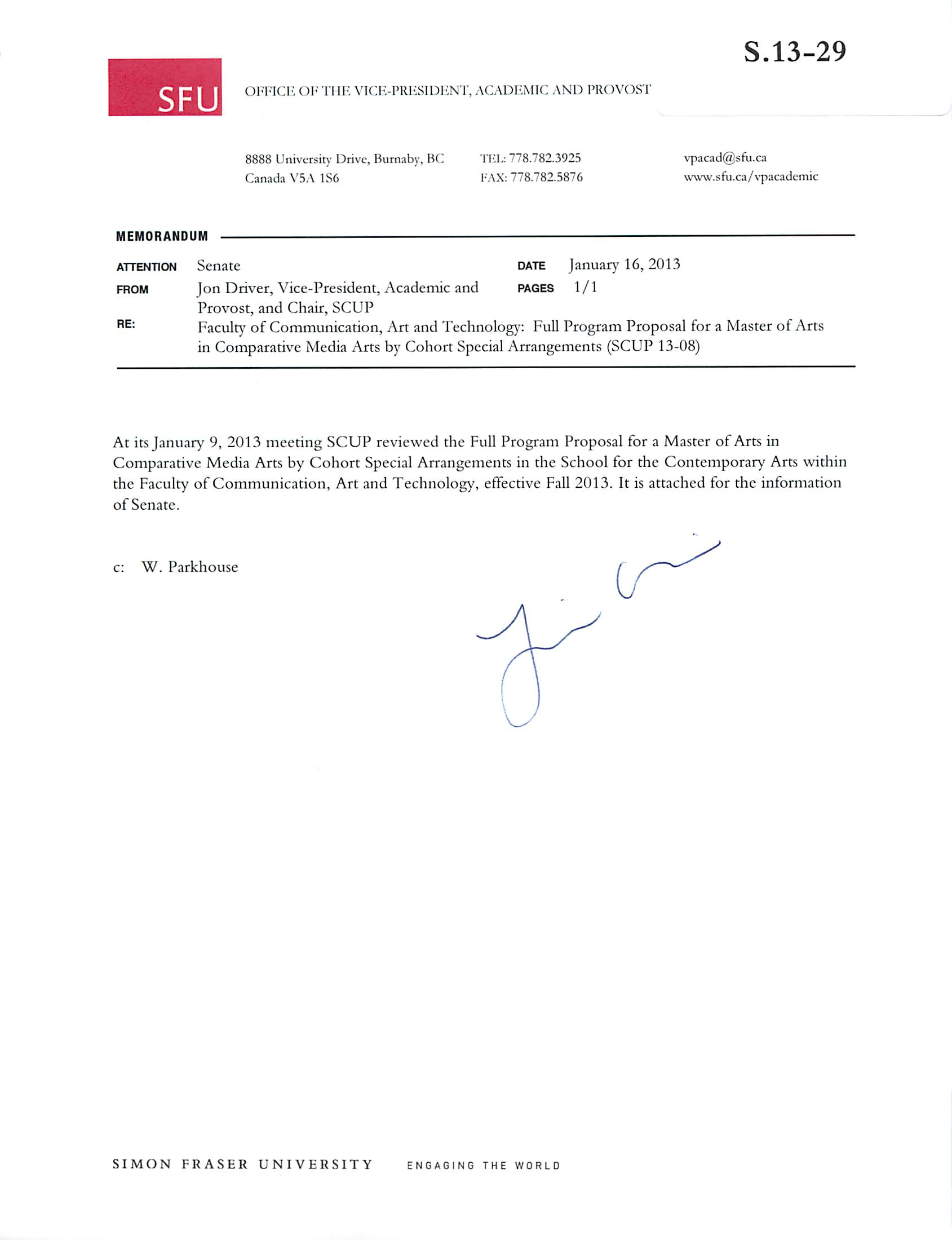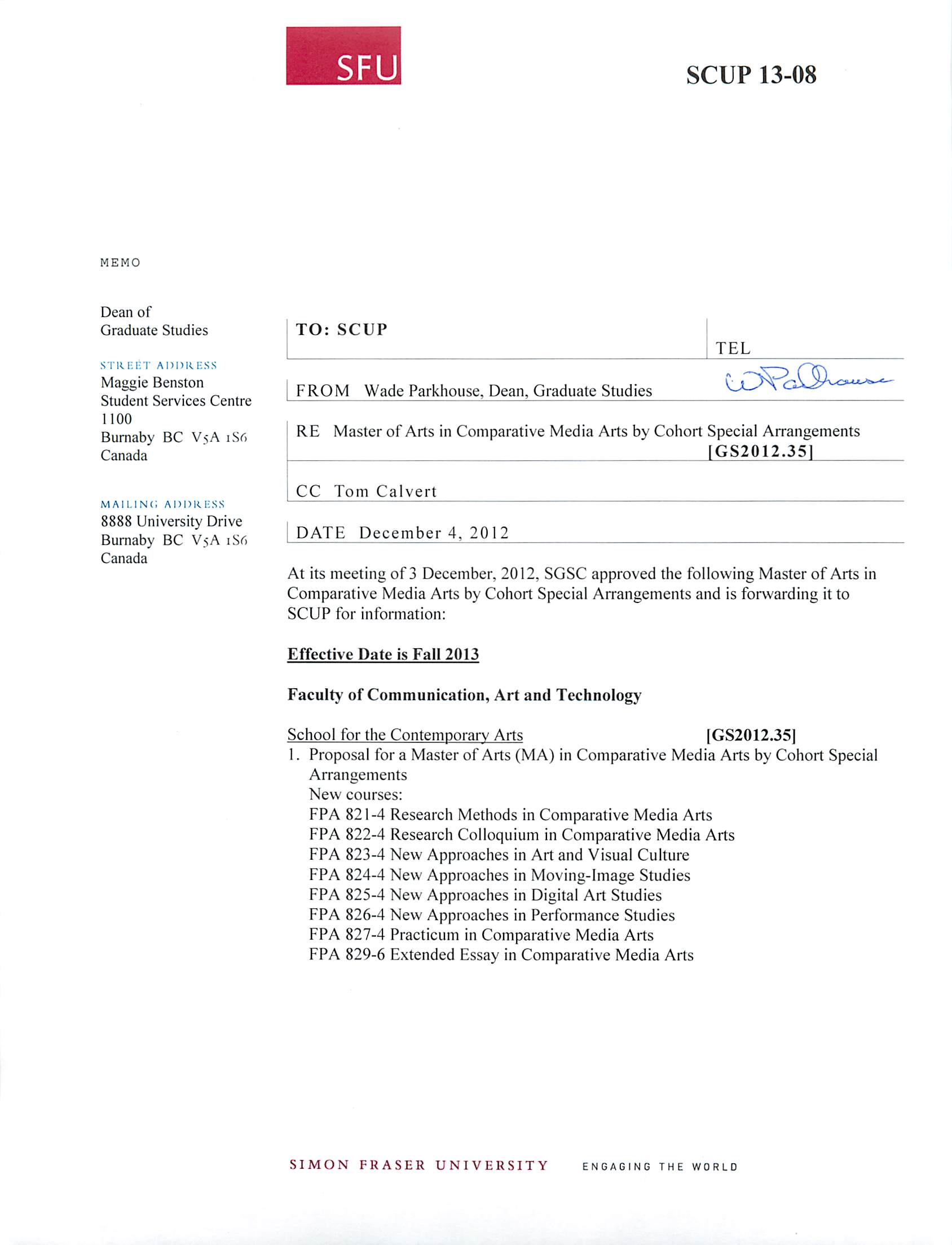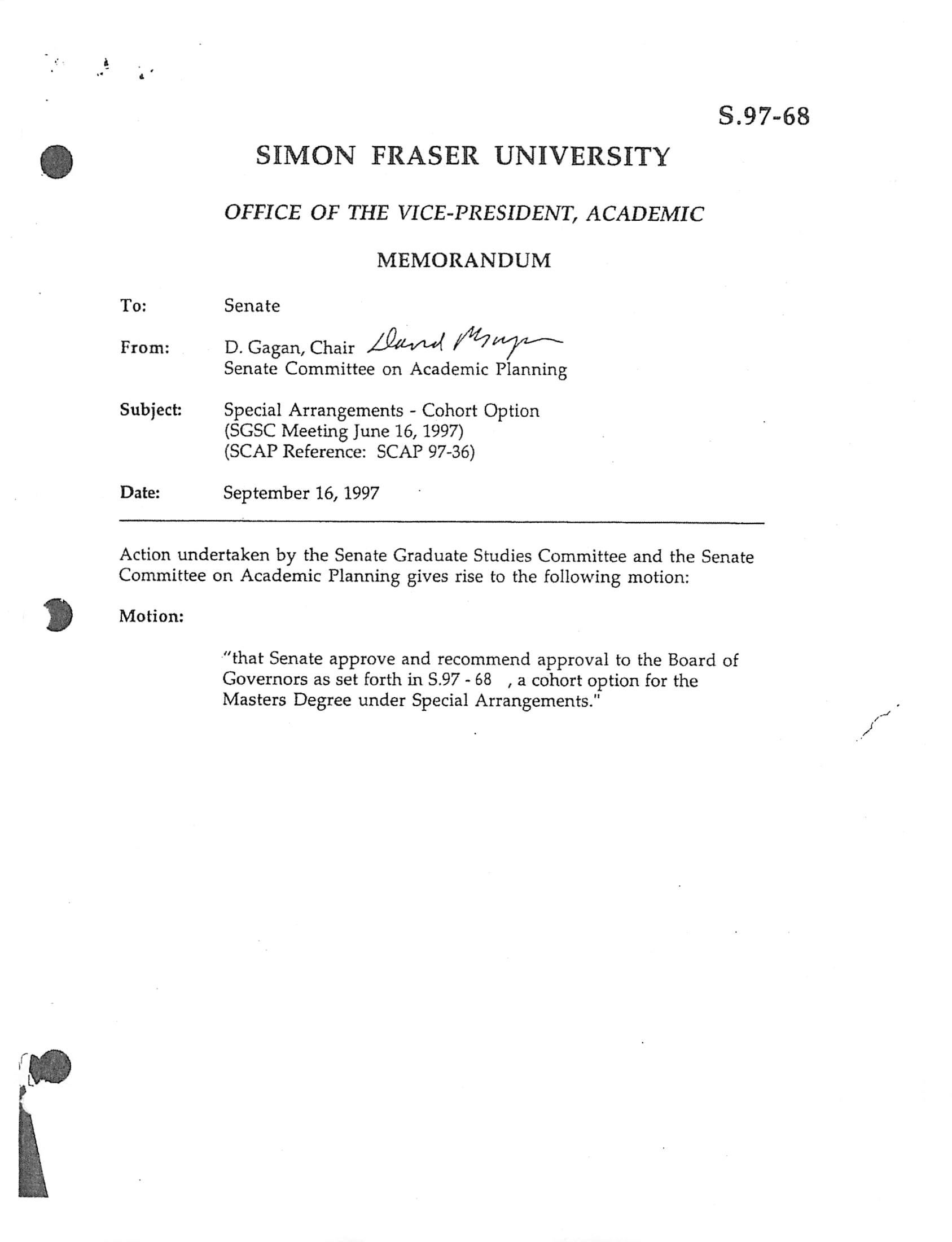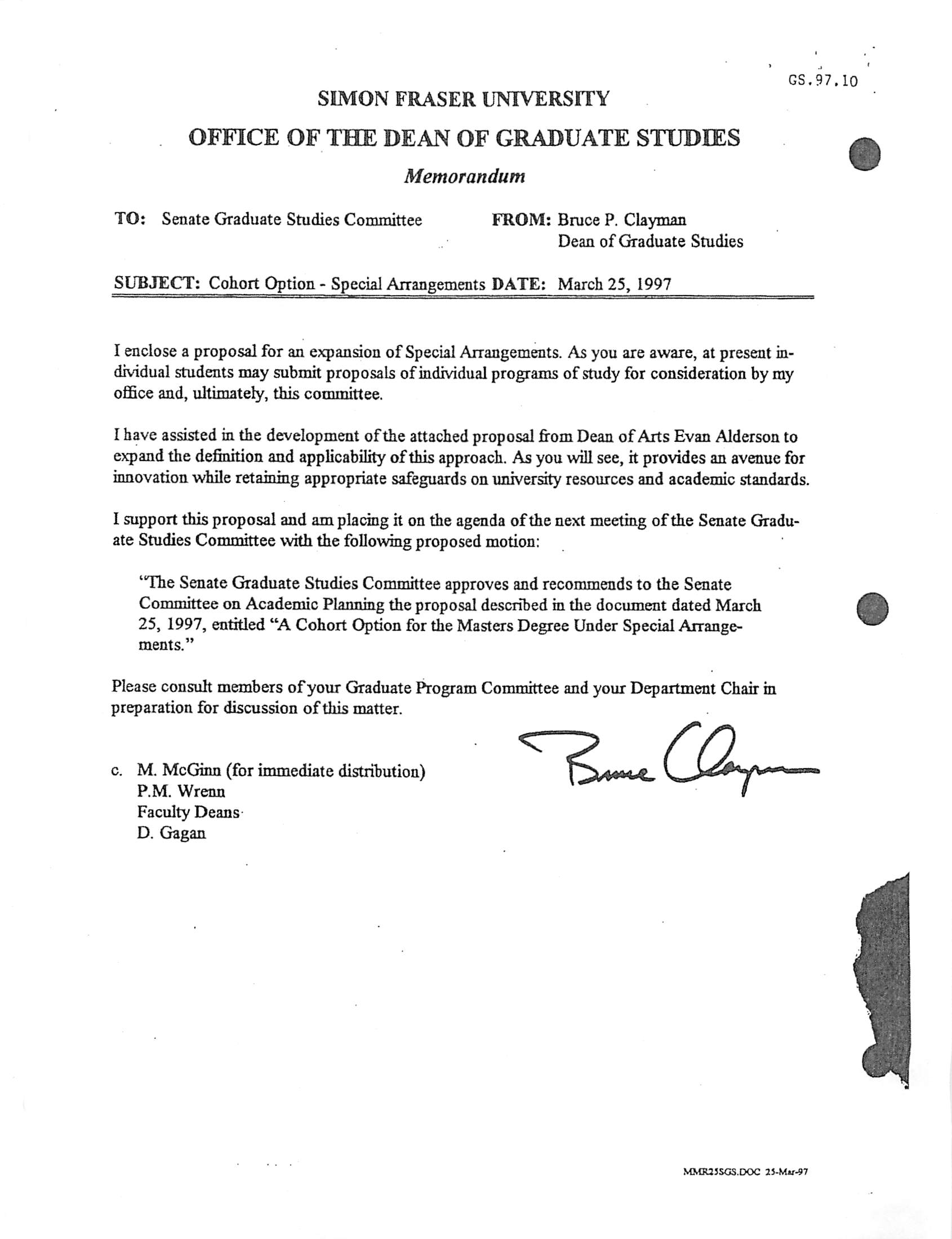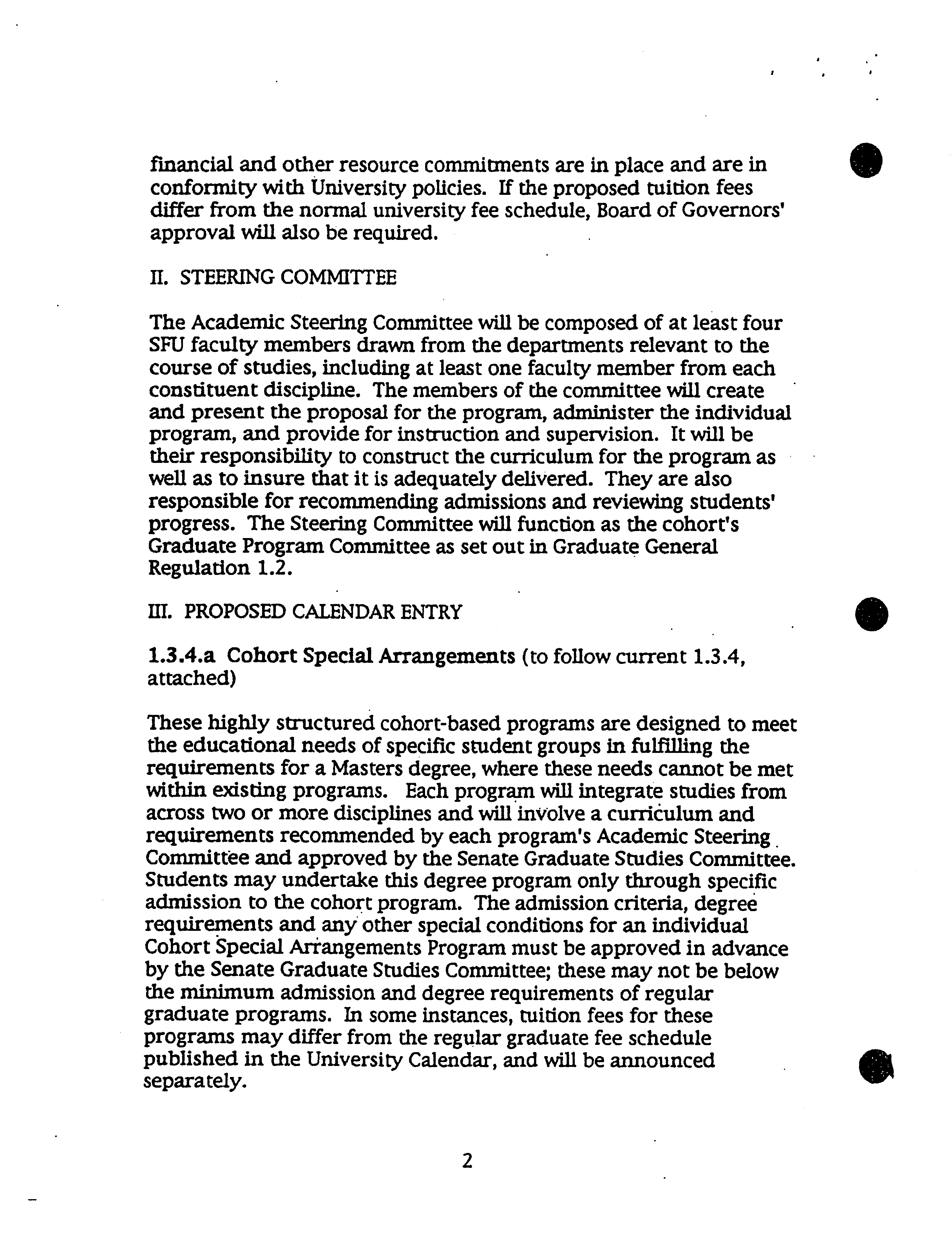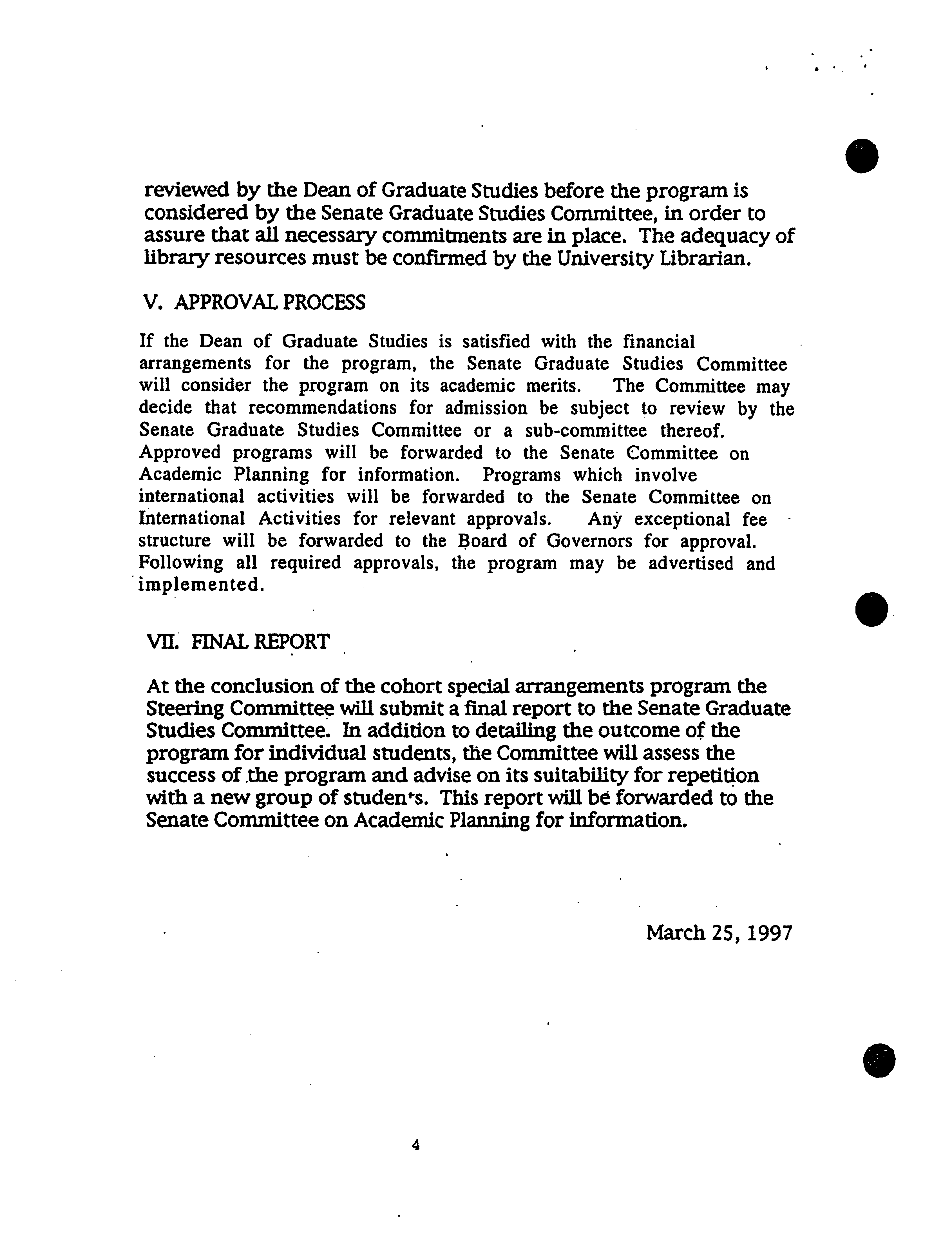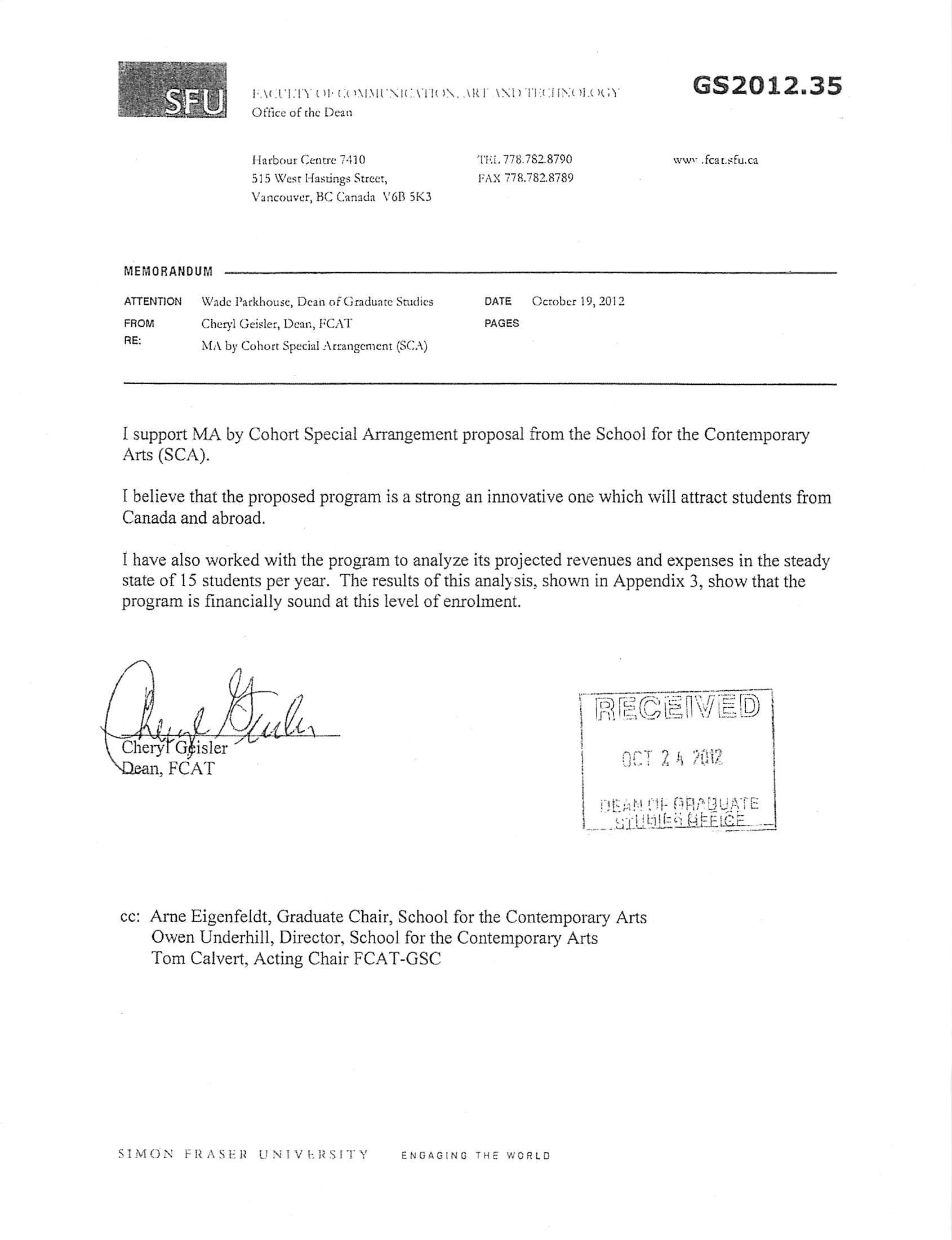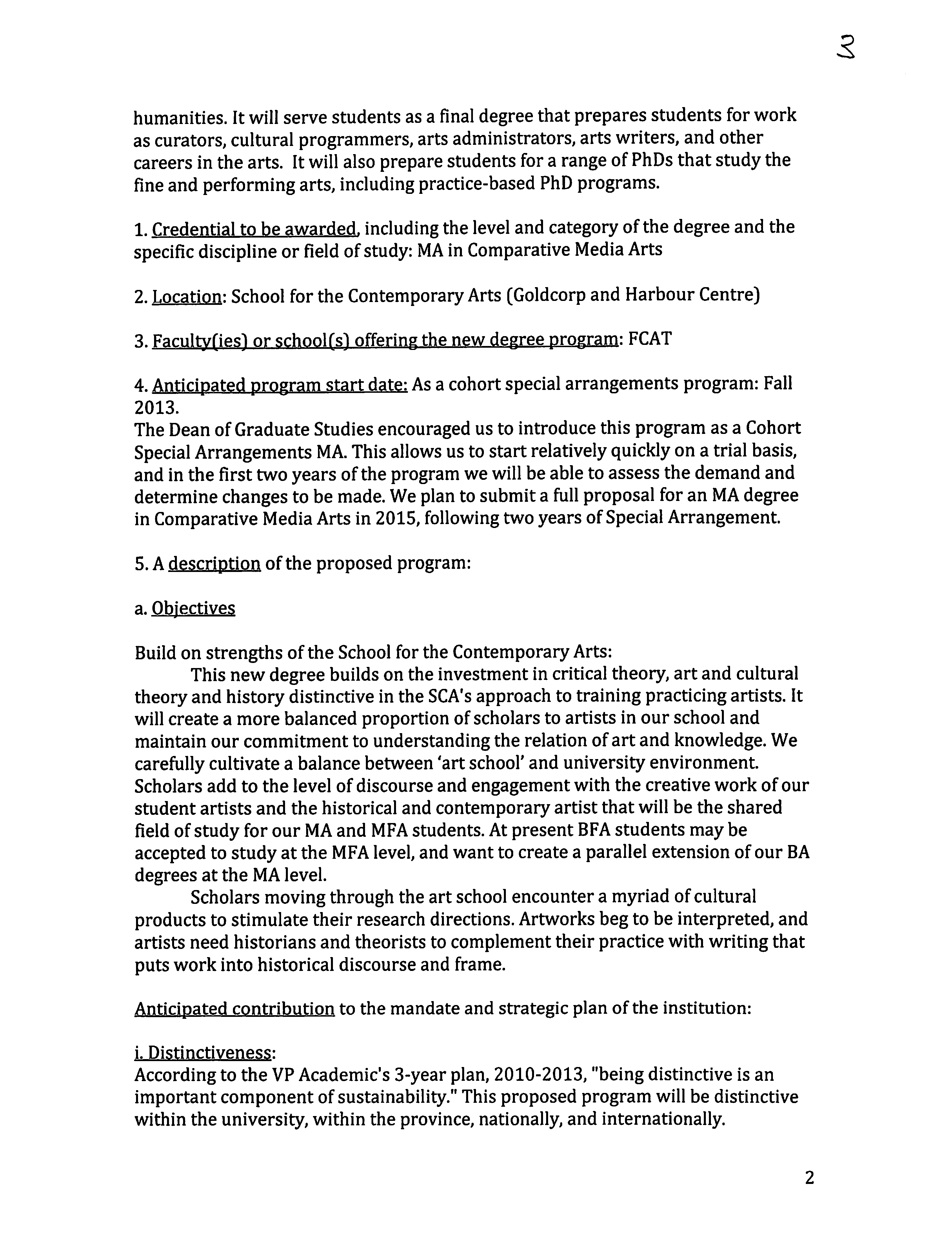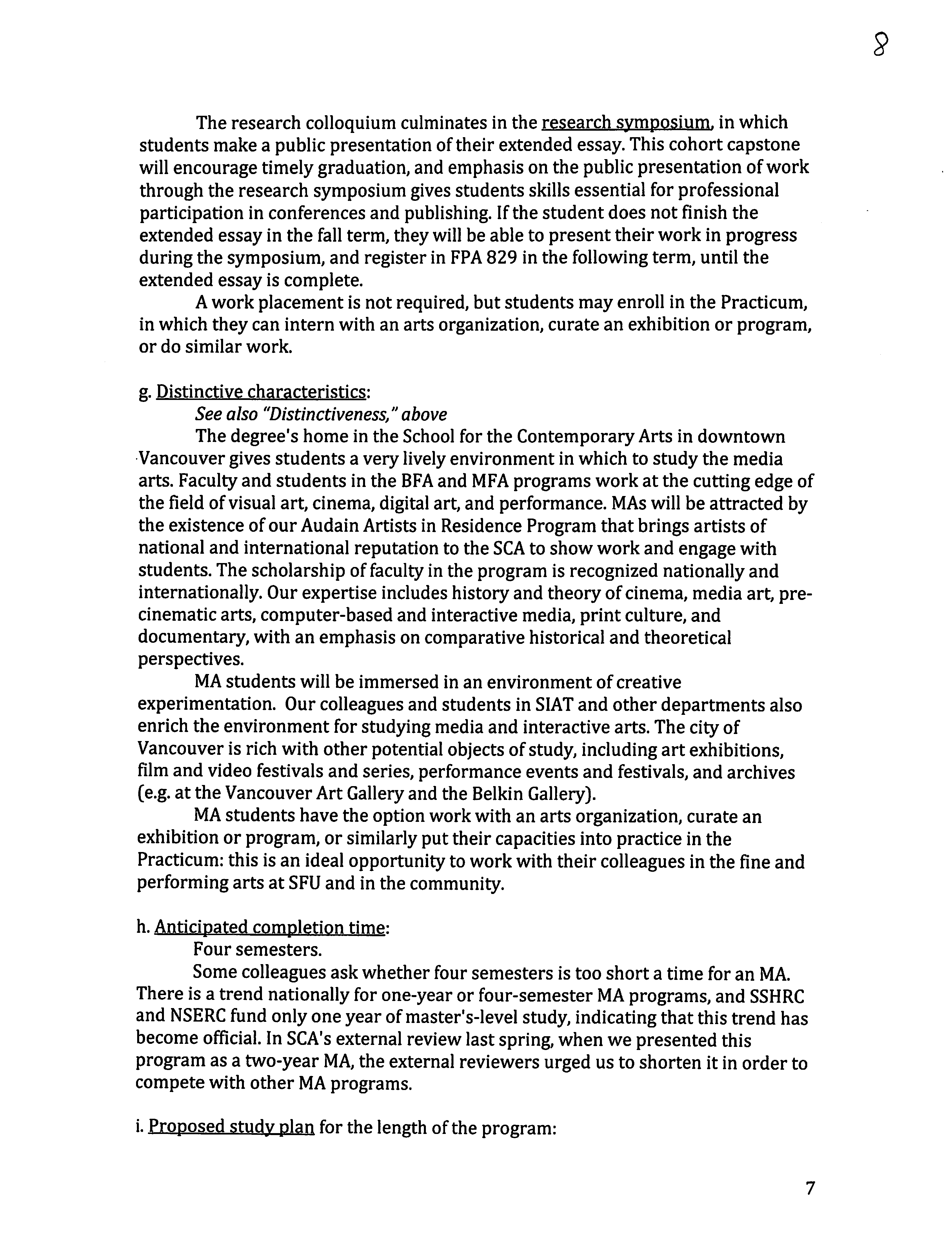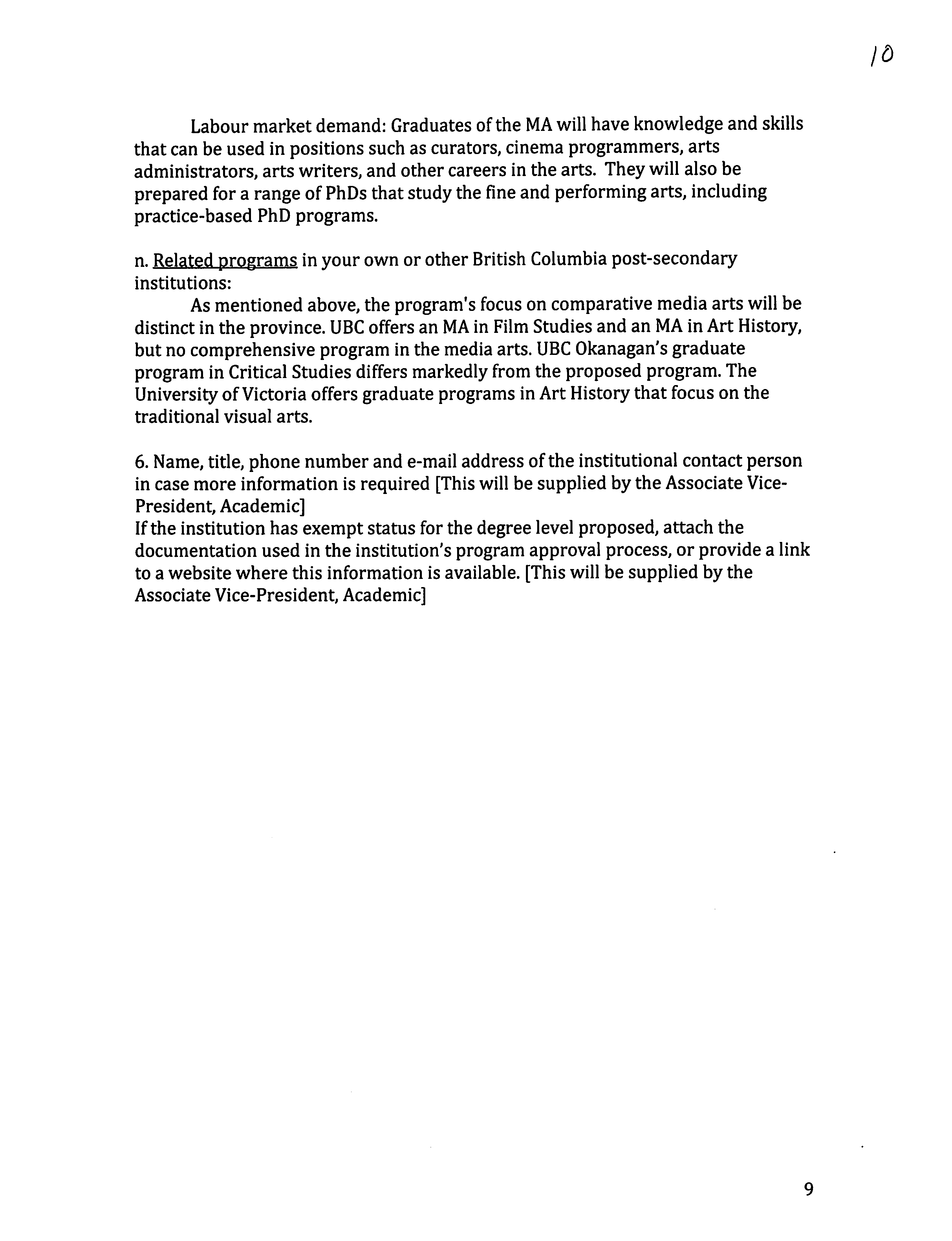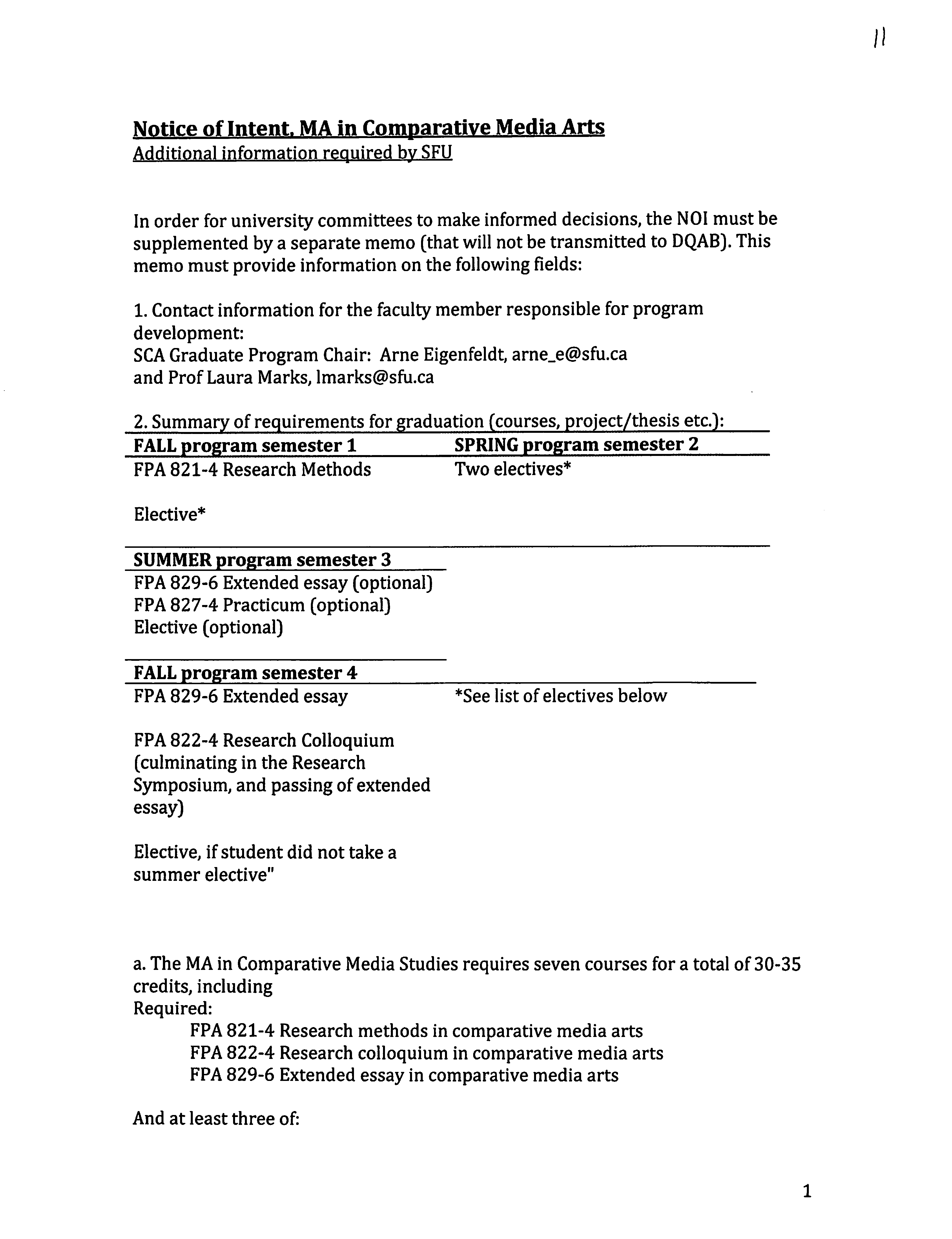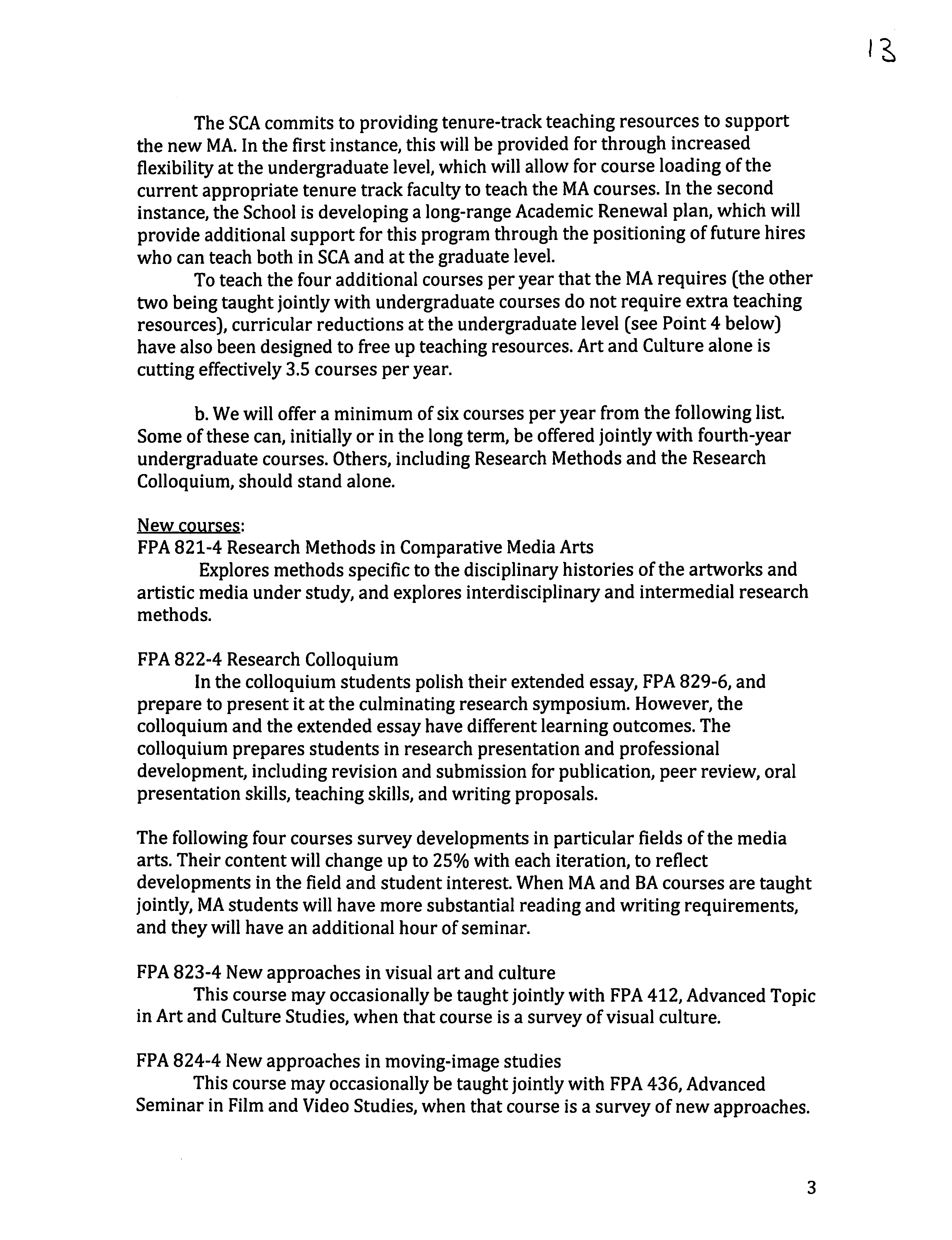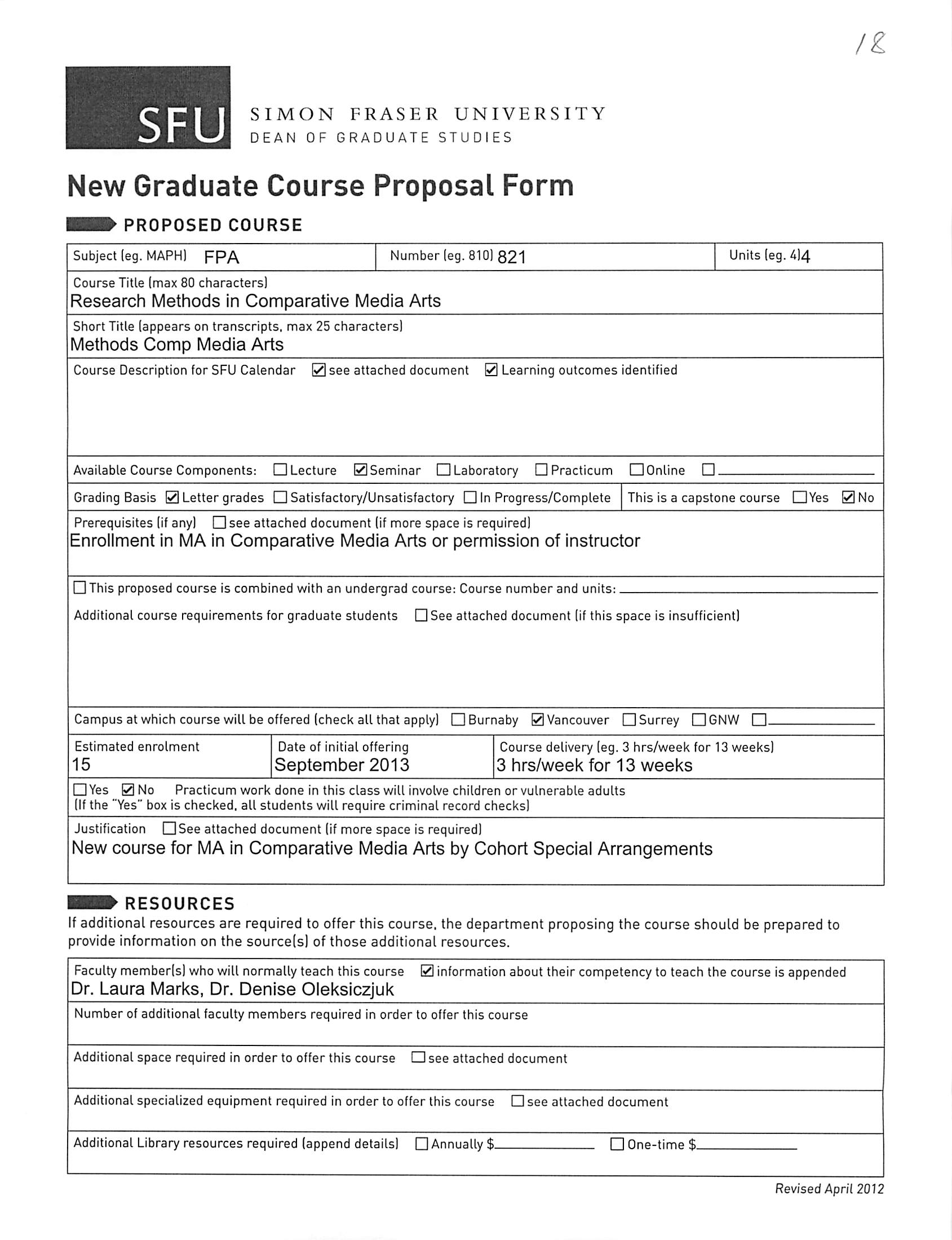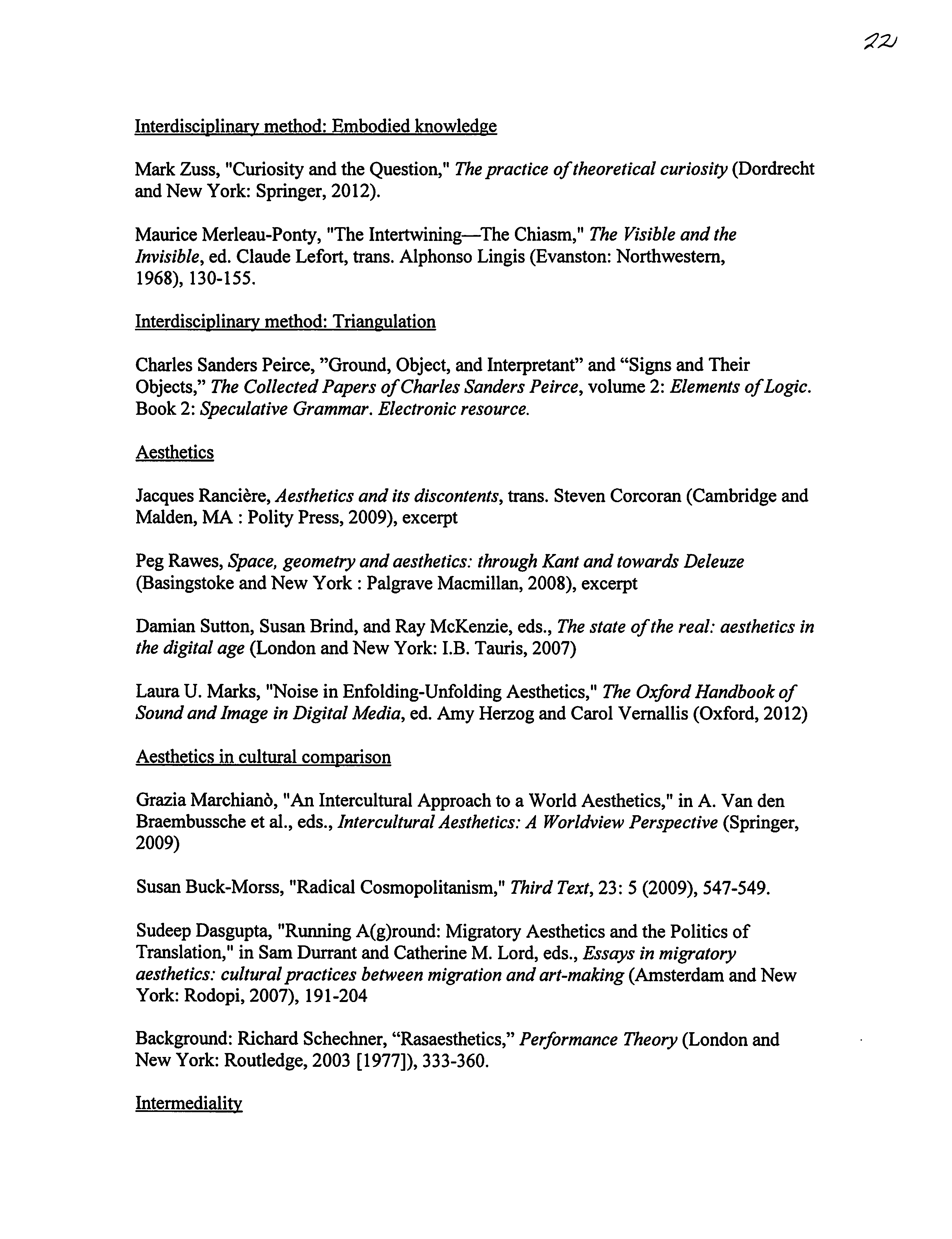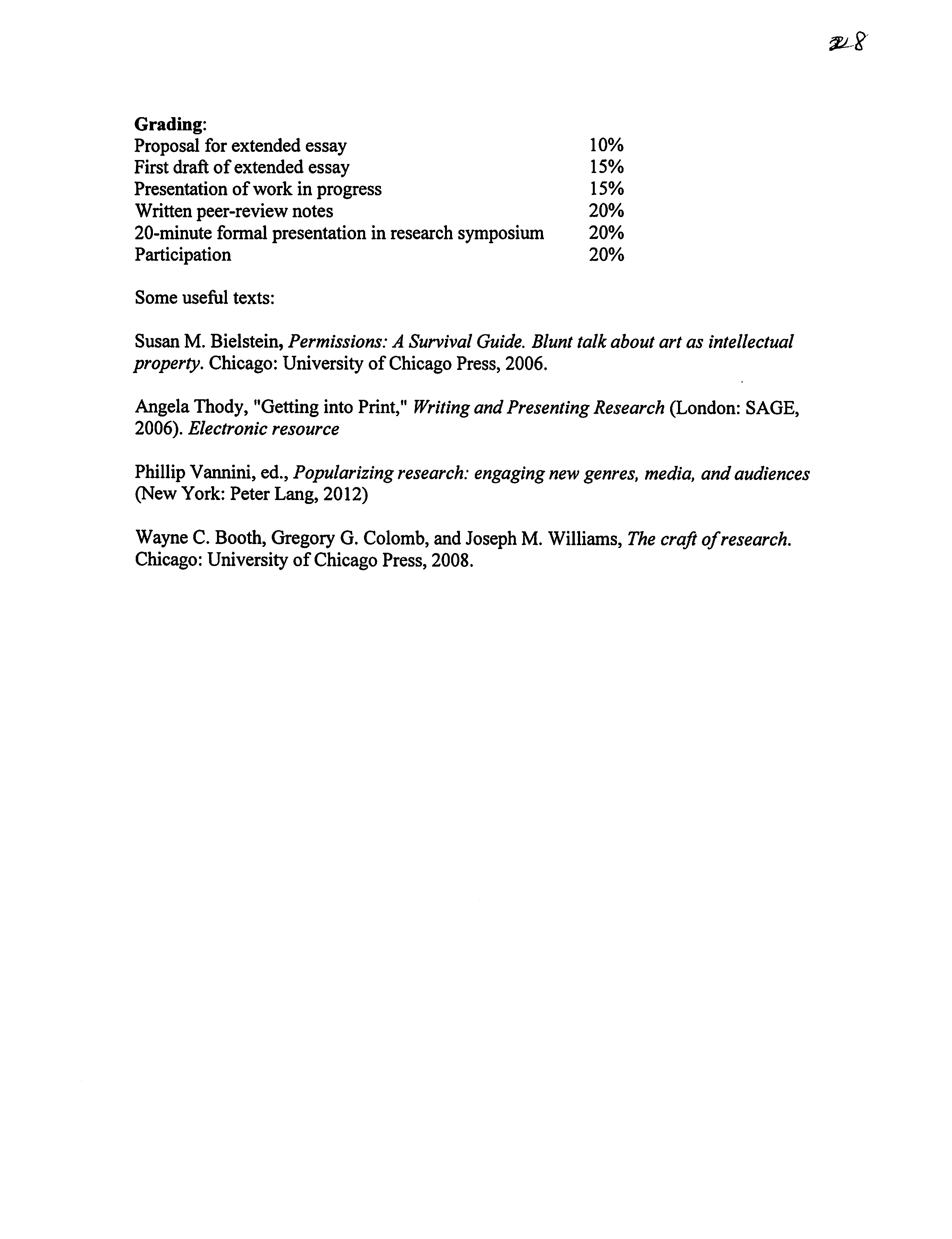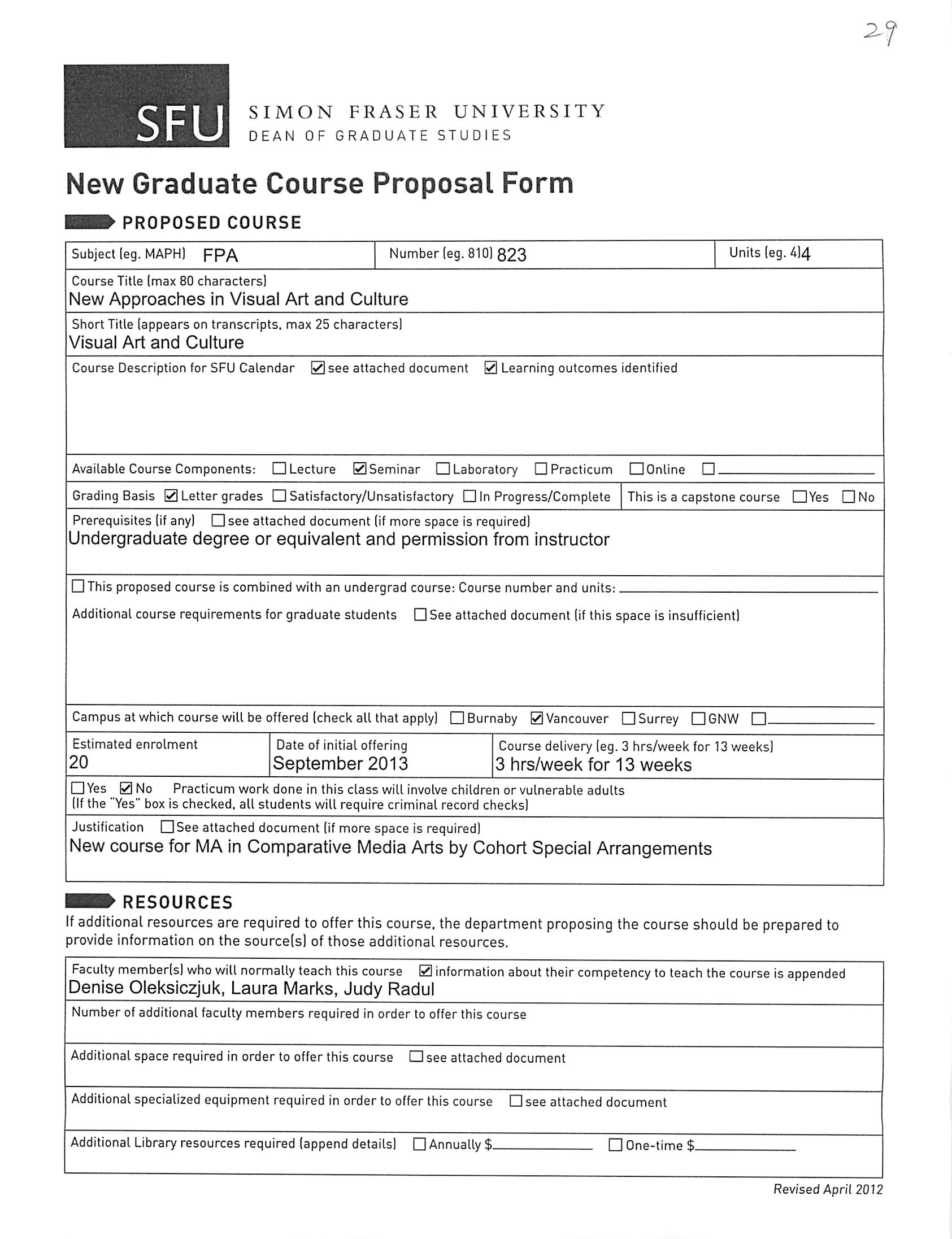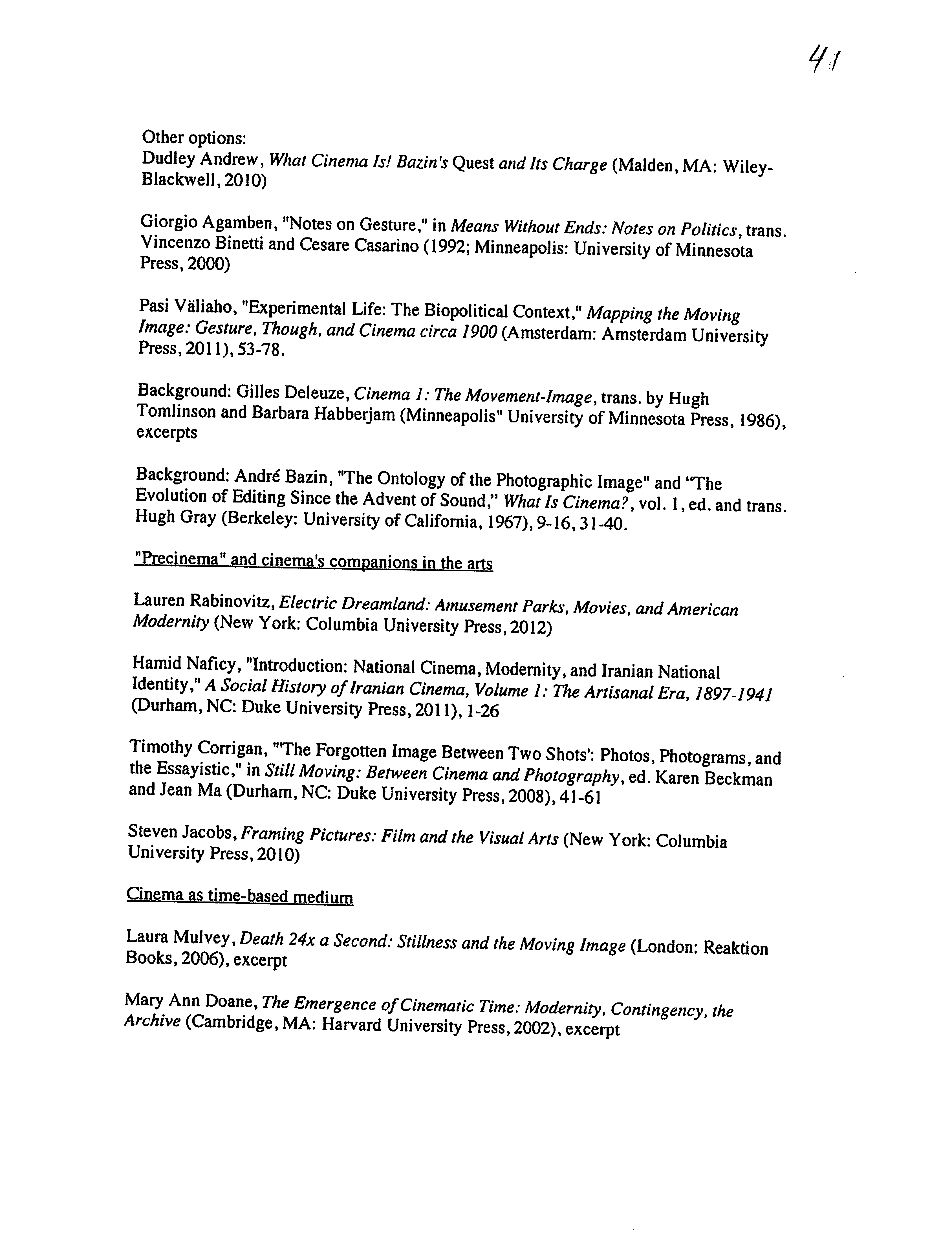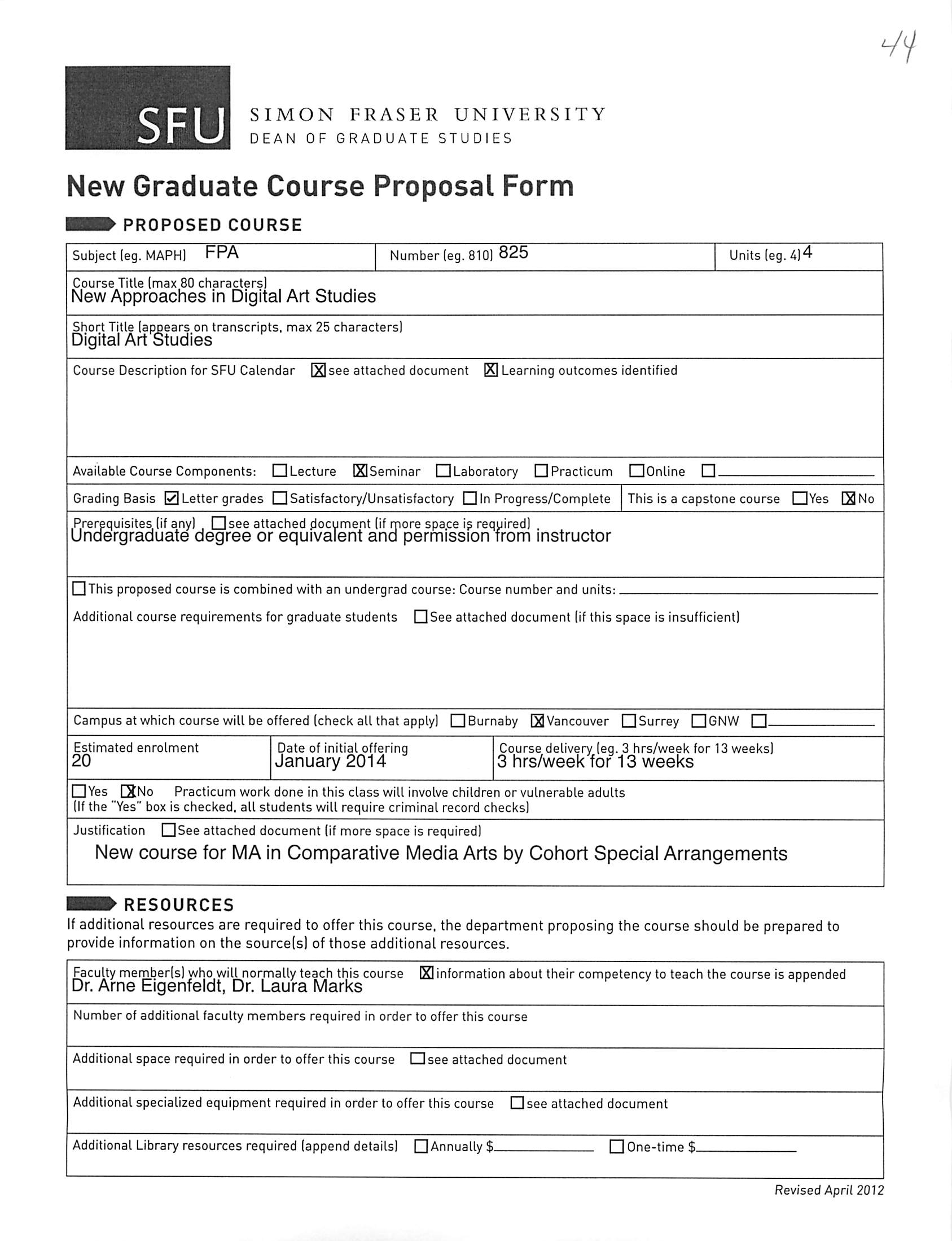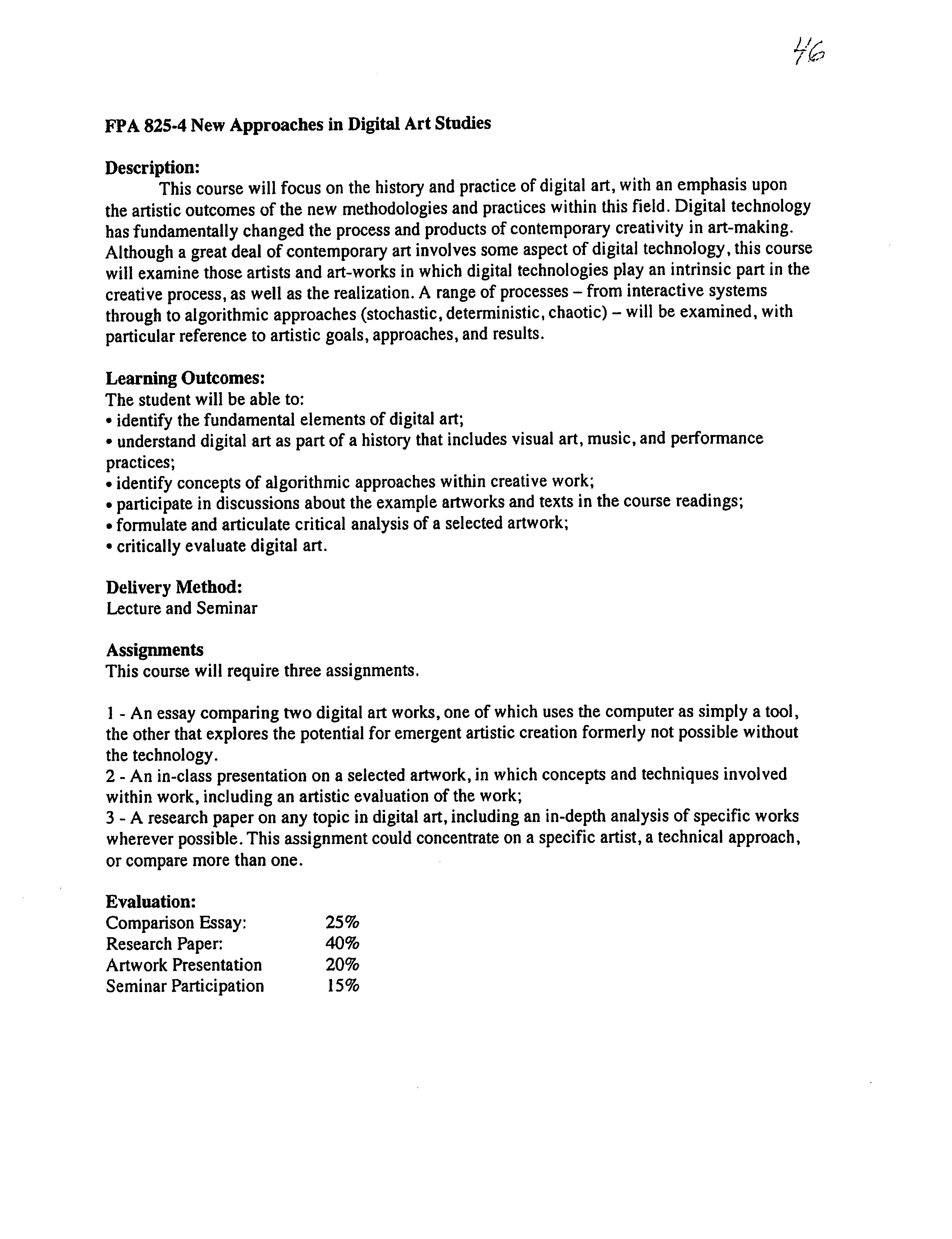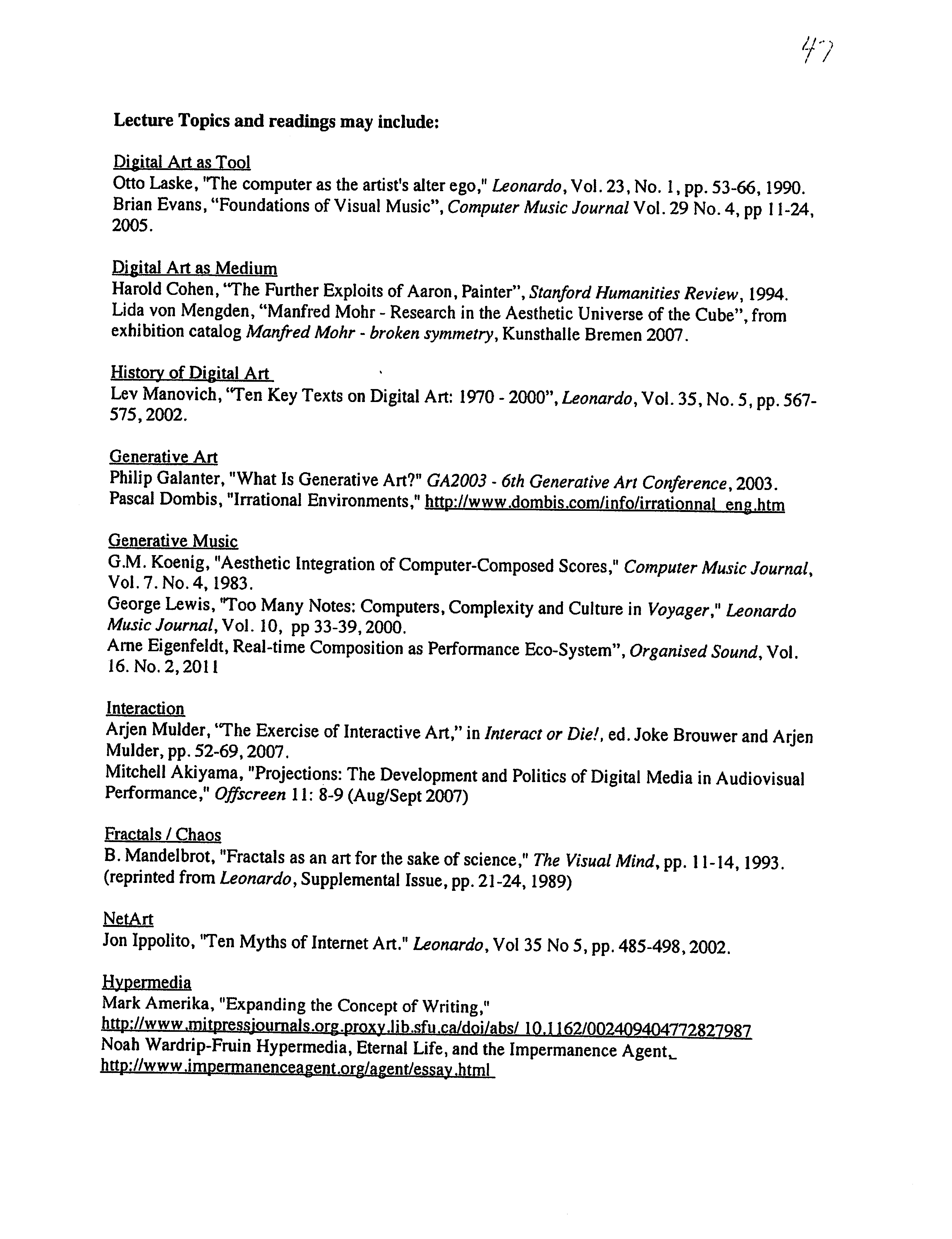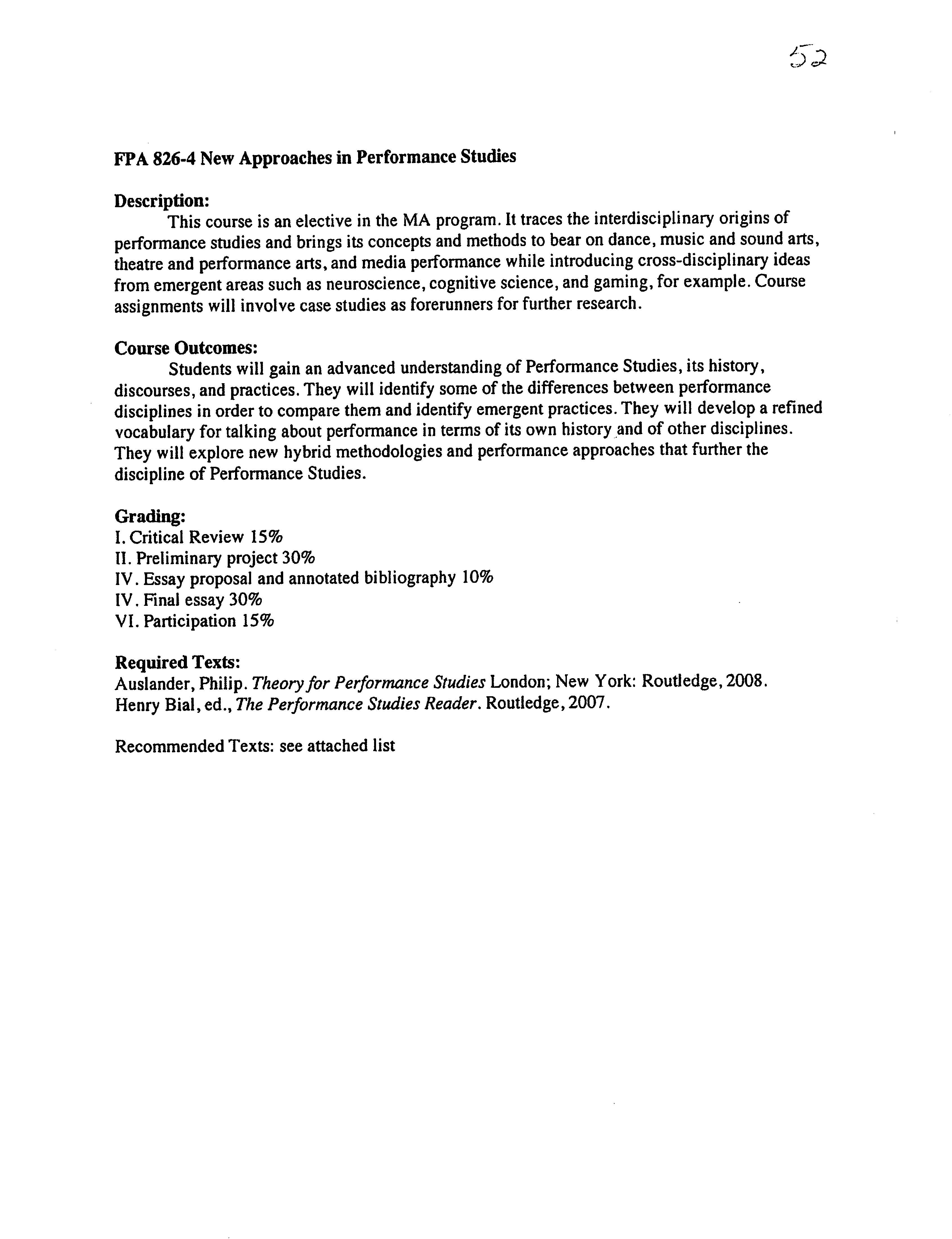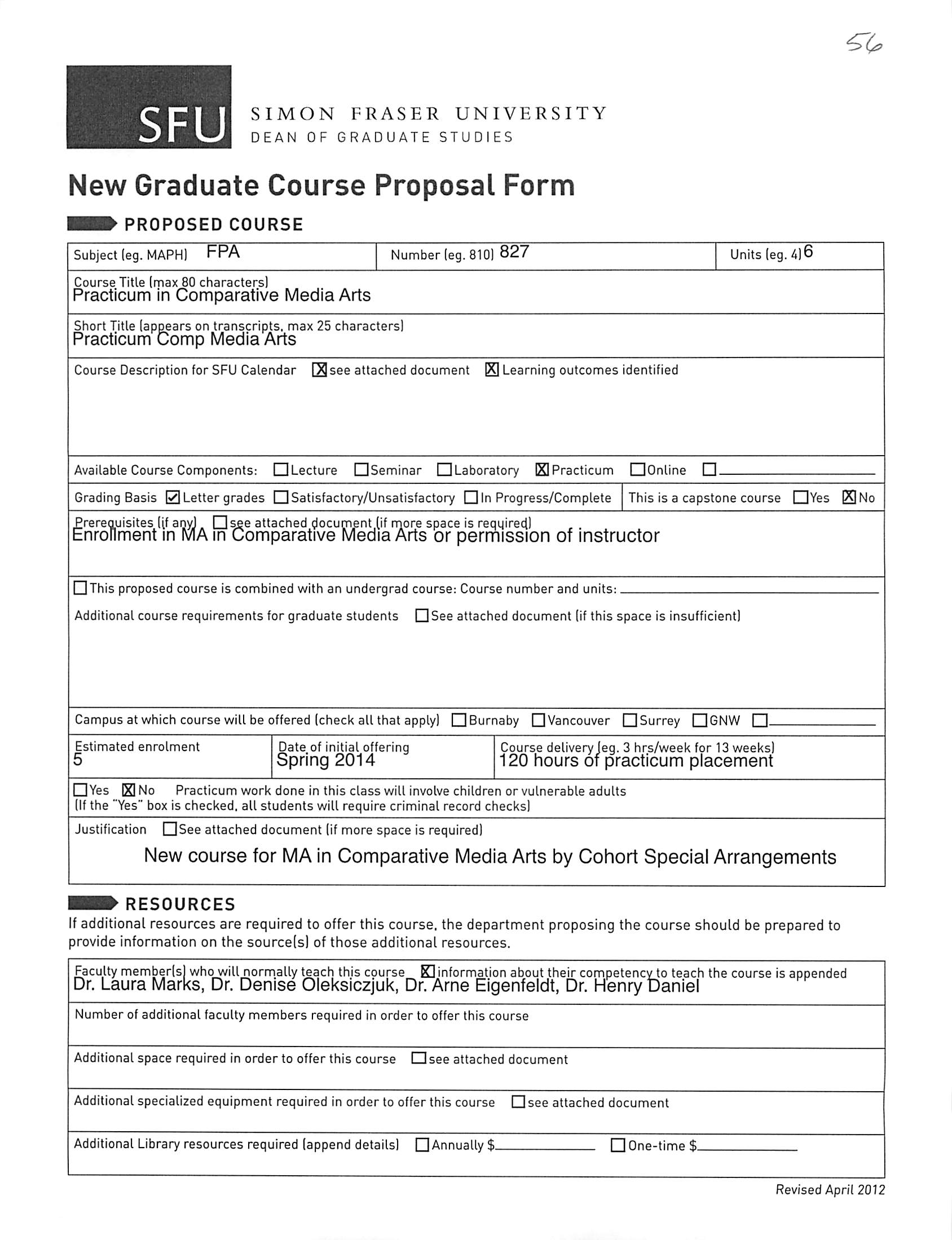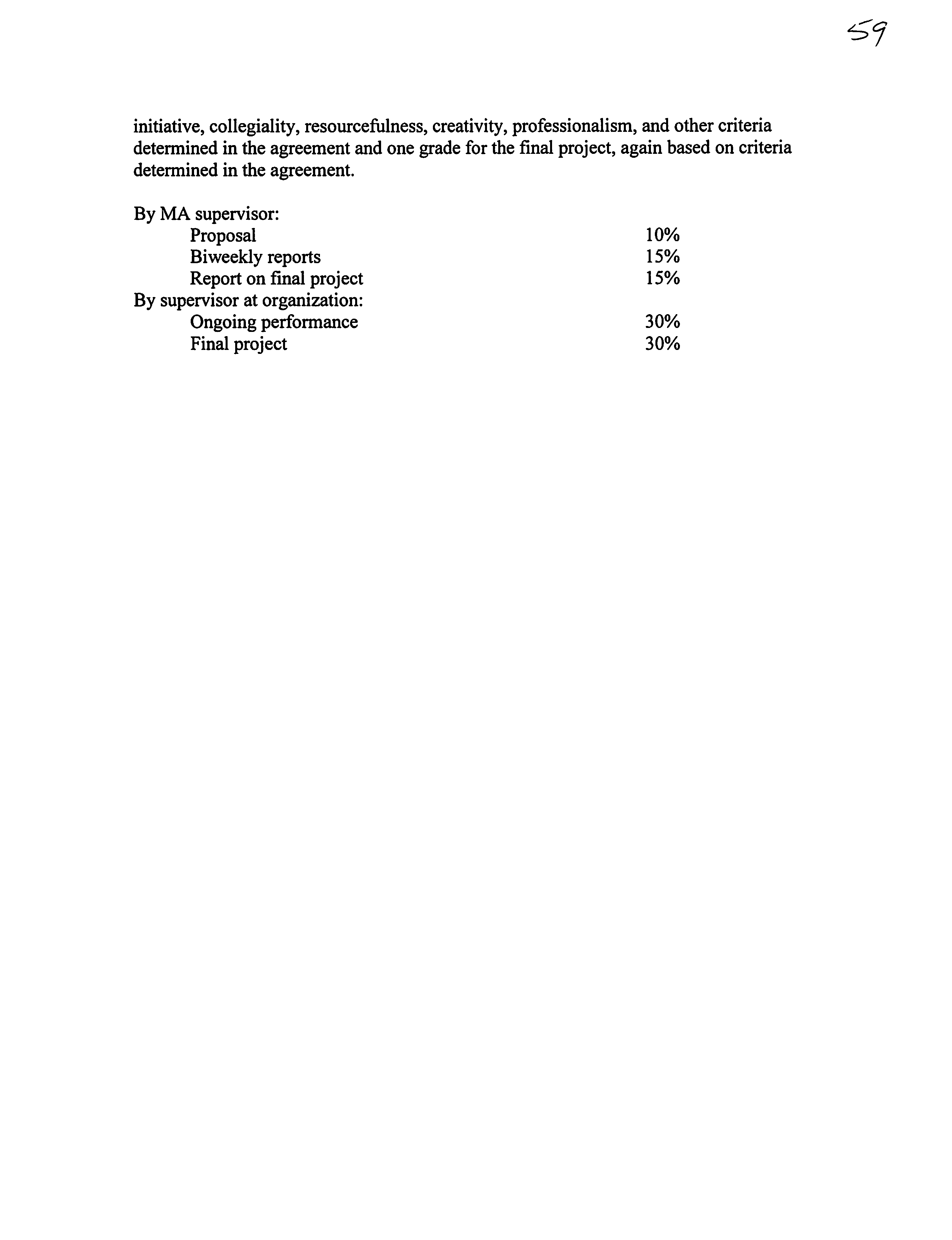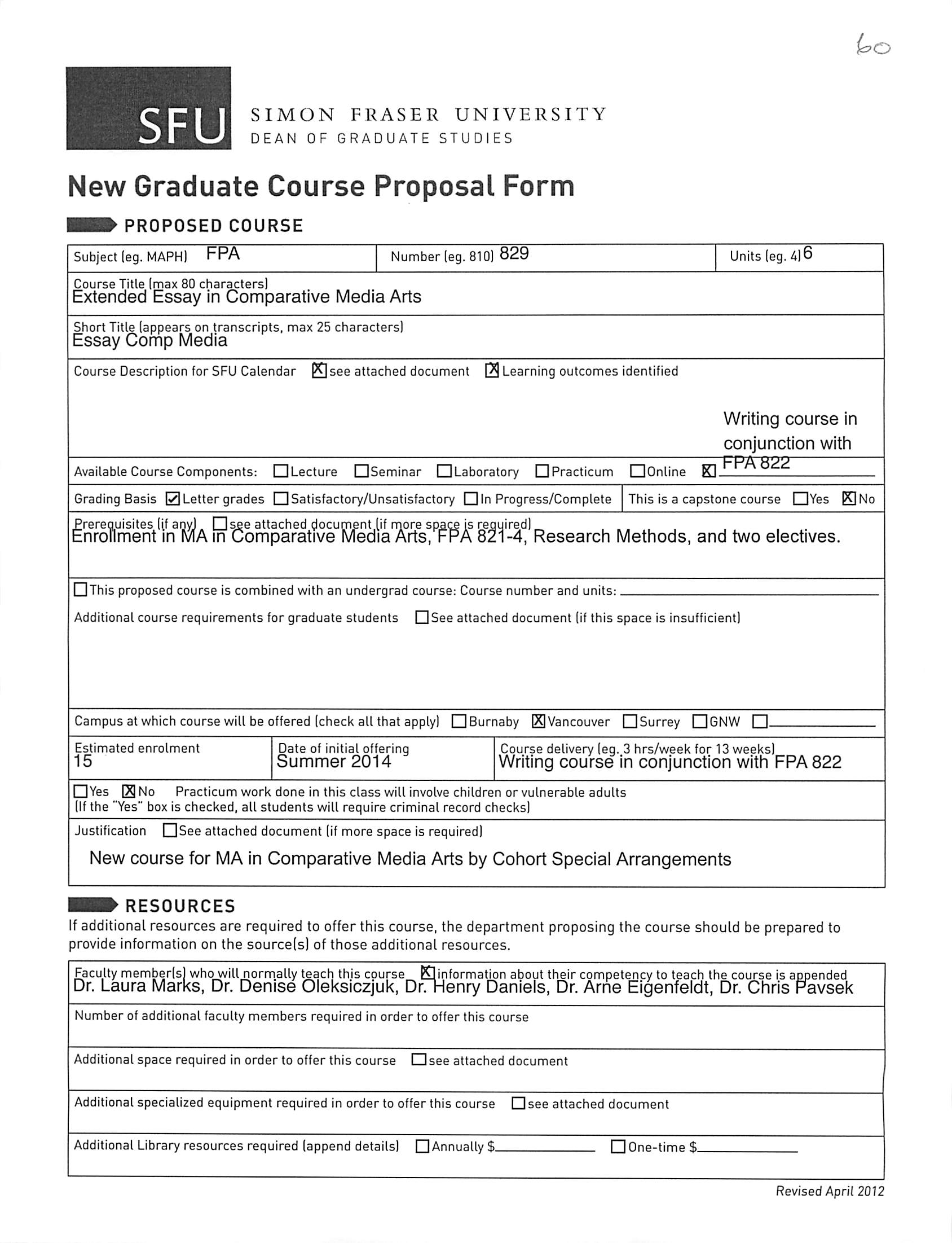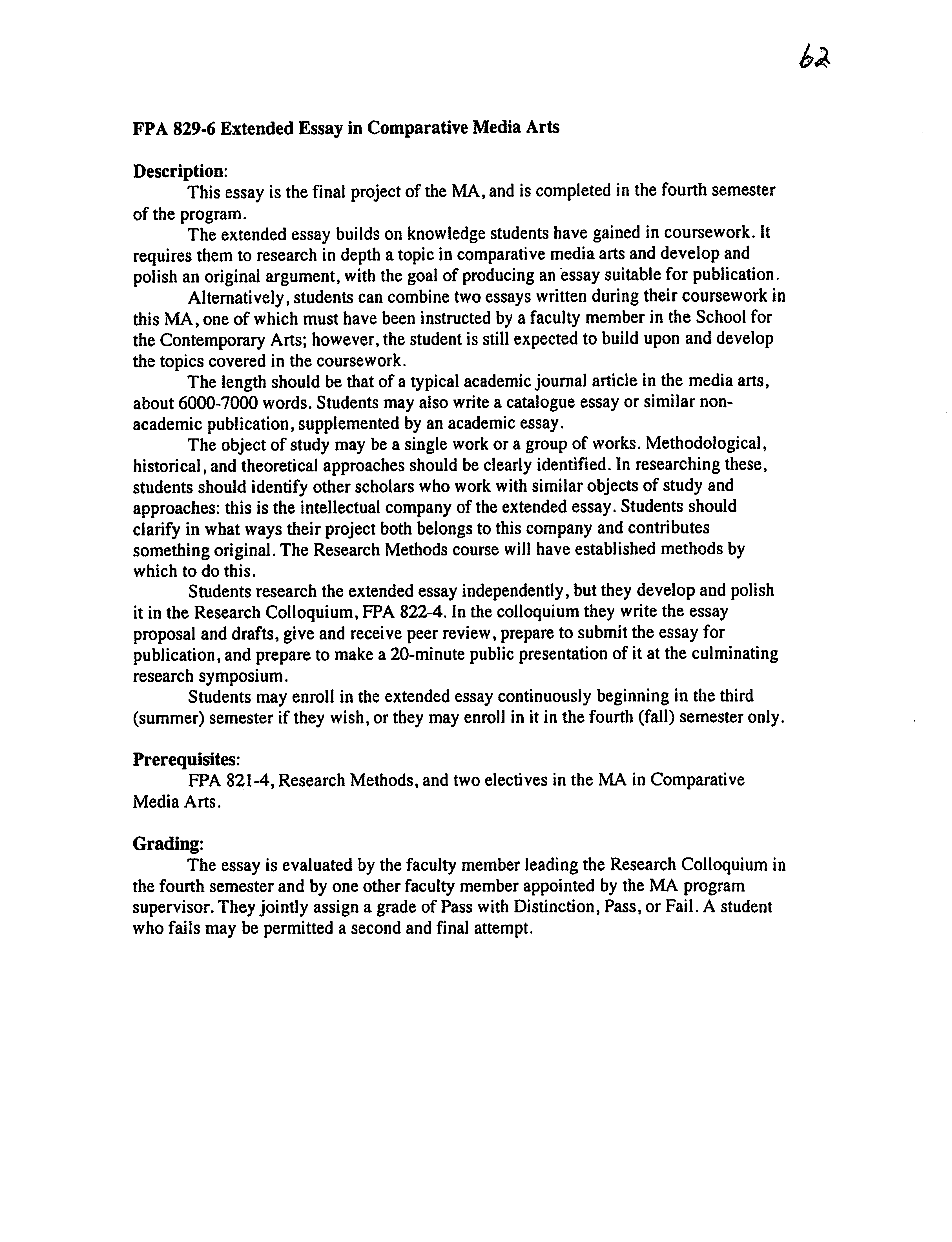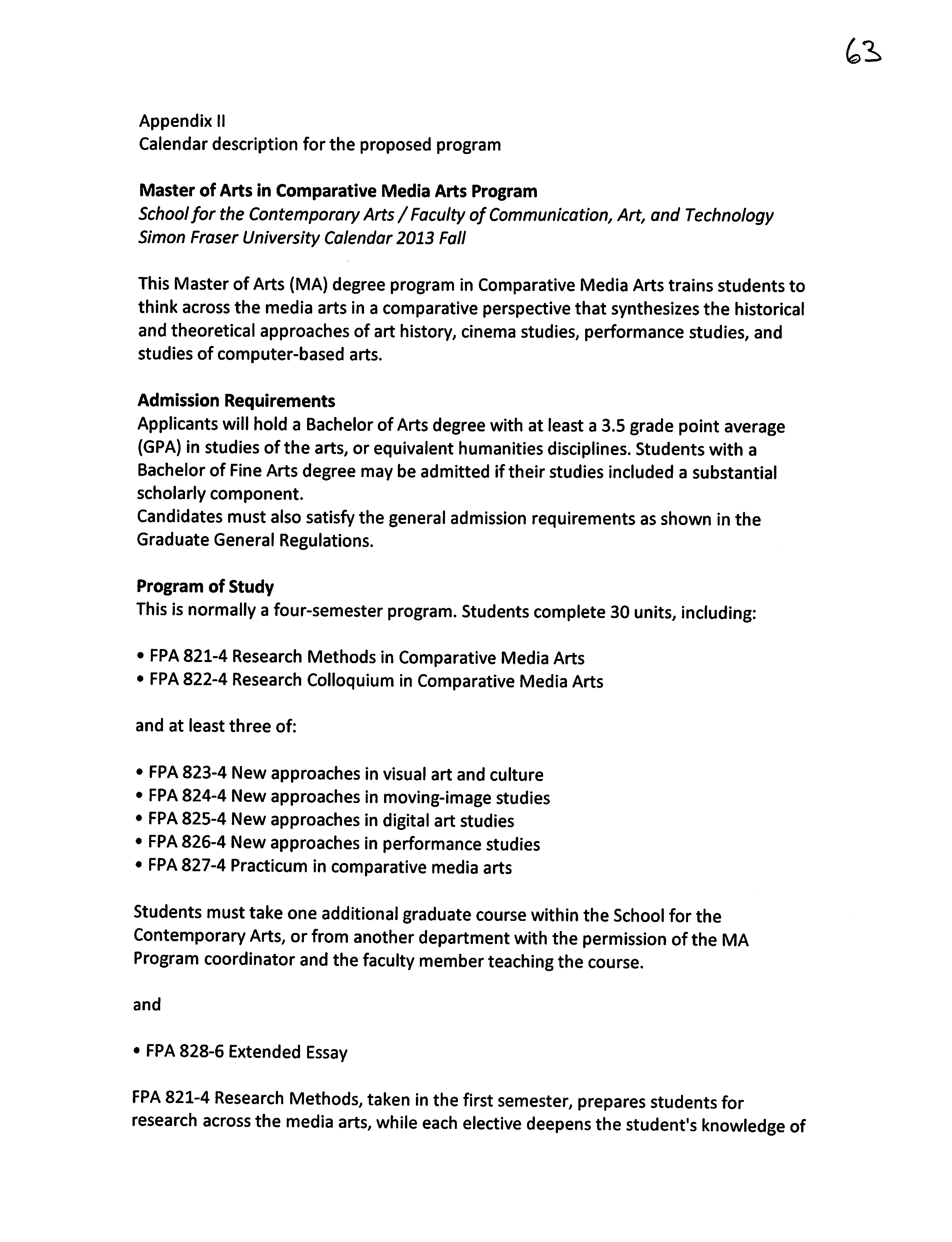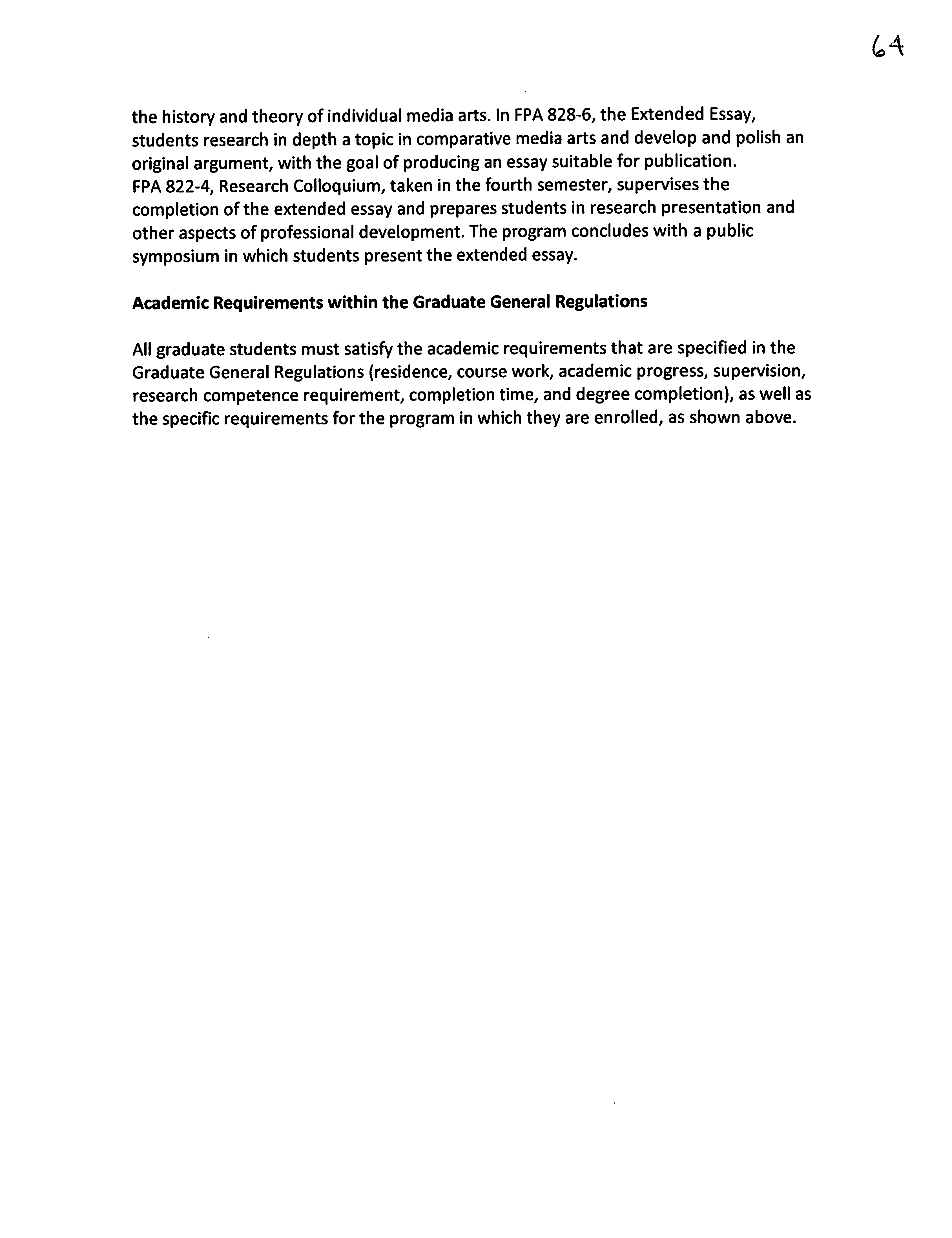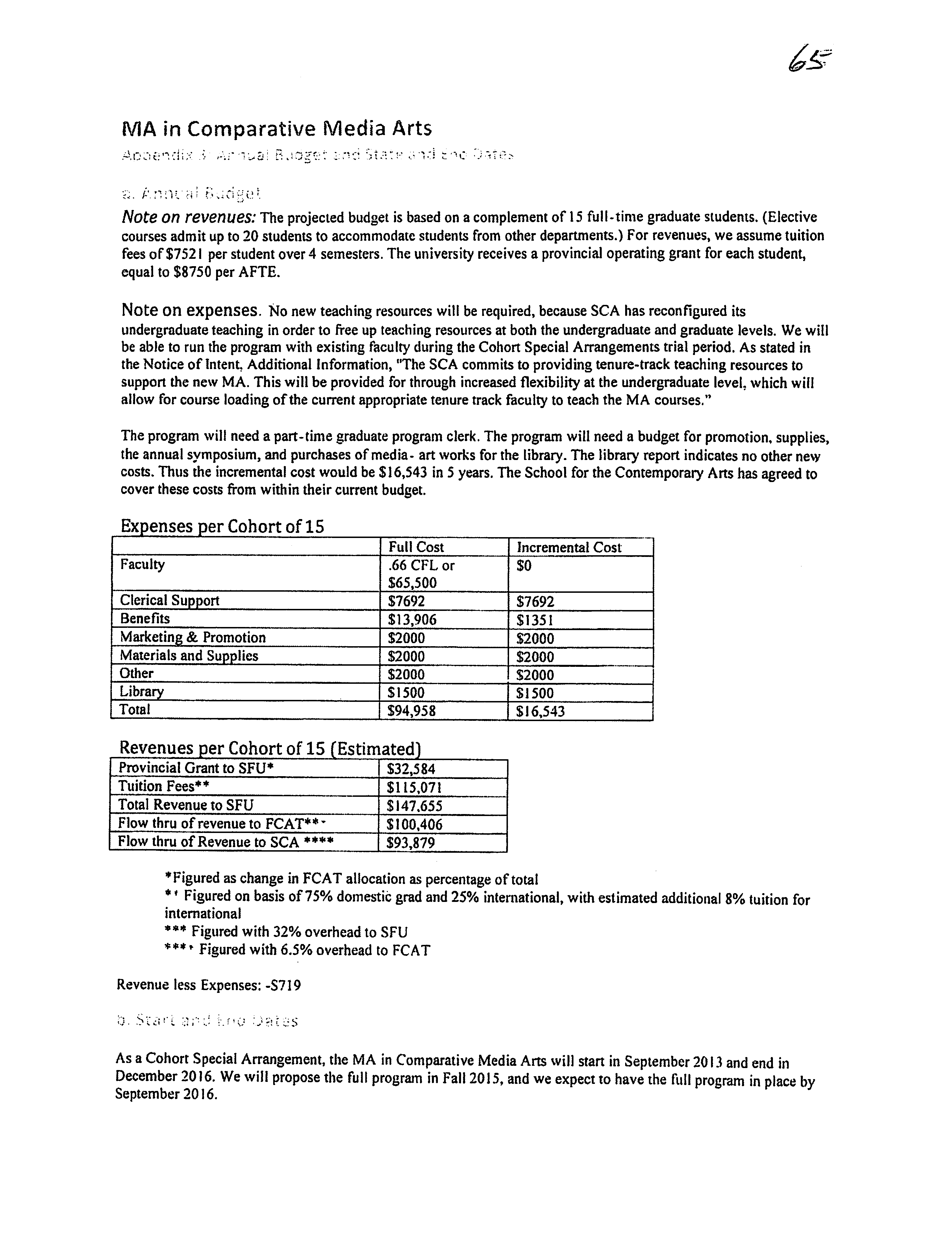SFU
MEMORANDUM
OFFICE OF THE VICE-PRESIDENT, ACADEMIC AND PROVOST
University Drive, Burnaby, BC
Canada \'5.\ 1S6
TF.L: 778.782.3925
FAX: 778.782.5876
S.13-29
attention
Senate
date
January 16,2013
from
Jon Driver, Vice-President, Academic and
pages
1/1
Provost, and Chair, SCUP
Faculty of Communication, Art and Technology: Full Program Proposal for a Master of Arts
in Comparative Media Arts by Cohort SpecialArrangements (SCUP 13-08)
RE:
At itsJanuary 9, 2013 meeting SCUP reviewed the Full Program Proposal for a Master of Arts in
Comparative Media Arts by Cohort Special Arrangements in the School for the Contemporary Arts within
the Faculty of Communication, Art and Technology, effective Fall 2013. It is attached for the information
of Senate.
c: W. Parkhouse
SIMON ERASER UNIVERSITY
ENGAGING THE WORLD
MEMO
Dean of
Graduate Studies
STREET ADDRESS
Maggie Benston
Student Services Centre
1100
Burnaby BC V>A 1S6
Canada
MAII.1NC ADDRESS
8888 University Drive
Burnaby BC VsA iSr.
Canada
SFU
SCUP 13-08
TO:SCUP
TEL
FROM Wade Parkhouse. Dean, Graduate Studies
(^^^JL^^--
RE Master of Arts in Comparative Media Arts by Cohort Special Arrangements
[GS2012.351
CC Tom Calvert
DATE December 4. 2012
At its meeting of 3 December, 2012, SGSC approved the following Master of Arts in
Comparative Media Arts by Cohort Special Arrangements and is forwarding it to
SCUP for information:
Effective Date is Fall 2013
Faculty of Communication, Art and Technology
School for the Contemporary Arts
|GS2012.35|
1. Proposal for a Master of Arts (MA) in Comparative Media Arts by Cohort Special
Arrangements
New courses:
FPA 821-4 Research Methods in Comparative Media Arts
FPA 822-4 Research Colloquium in Comparative Media Arts
FPA 823-4 New Approaches in Art and Visual Culture
FPA 824-4 New Approaches in Moving-Image Studies
FPA 825-4 New Approaches in Digital Art Studies
FPA 826-4 New Approaches in Performance Studies
FPA 827-4 Practicum in Comparative Media Arts
FPA 829-6 Extended Essay in Comparative Media Arts
SIMON FRASER UNIVERSITY
ENGAGING THE WORLD
Timeline:
September 2012 - Approved by School of Contemporary Arts
October 1, 2012 - Proposal and initial discussion to SGSC
November 5,2012 - New courses were submitted; calendar entries were required
December 3, 2012 - Approved by SGSC
SIMON FRASER UNIVERSITY
OFFICE OF THE VICE-PRESIDENT, ACADEMIC
MEMORANDUM
To:
Senate
From:
D. Gagan, Chair /^W
A?<y«
Senate Committee on Academic Planning
Subject:
Special Arrangements - Cohort Option
(SGSC Meeting June 16,1997)
(SCAP Reference: SCAP 97-36)
Date:
September 16,1997
S.97-68
Action undertaken by the Senate Graduate Studies Committee and the Senate
Committee on Academic Planning gives rise to the following motion:
Motion:
"that Senate approve and recommend approval to the Board of
Governors as set forth in S.97 - 68 , a cohort option for the
Masters Degree under Special Arrangements."
y
SCAP 97 - 36
SIMON FRASER UNIVERSITY
MEMORANDUM
To: Alison Watt, Director
From: Phyllis Wrenn
Secretariat Services
Acting Dean, Graduate
Studies
Subject:
Cohort;Option - Special
*.*'
Date:
August 14, 1997
Arrangements
******************************************************************************
The Senate Graduate Studies Committee, at their Meeting on June 16, 1997,
approved the following motion and it is now being forwarded to the Senate
Committee on Academic Planning for approval:
MOTION:
"That the Senate Graduate Studies Committee approves and
recommends to the Senate Committee on Academic Planning
the proposal described in the document dated March 25, 1997,
entitled "A Cohort Option for the Masters degree Under Special
Arrangements" with the following amendment:
Page 4, Item V. Approval Process
Add after sentence ending "...-.academic merits."
The
Committee may decide that recommendations for admission
be subject to review by the Senate Graduate Studies Committee
or a sub-committee thereof."
H_L- H- U)
M^
mm/
Phyllis Wrenn
encl.
Acting Dean, Graduate Studies
GS.97.10
SIMON FRASER UNIVERSITY
. OFFICE OF THE DEAN OF GRADUATE STUDIES
Memorandum
TO: Senate Graduate Studies Committee
FROM:
Bruce P. Clayman
Dean of Graduate Studies
SUBJECT: Cohort Option - Special Arrangements
DATE:
March 25, 1997
I enclose a proposal for an expansion of Special Arrangements. As you are aware, at present in
dividual students may submit proposals of individual programs of study for consideration by my
office and, ultimately, this committee.
I have assisted in the development ofthe attached proposal from Dean ofArts Evan Alderson to
expand the definition and applicability of this approach. As you willsee, it provides an avenue for
innovation whileretaining appropriate safeguards on university resources and
academic standards.
I support this proposal and am placing it on the agenda ofthe next meeting ofthe Senate Gradu
ate StudiesCommitteewith the following proposed motion:
"The Senate Graduate Studies Committee approves and recommends to the Senate
Committee on Academic Planning the proposal described in the document dated March
25, 1997, entitled "A Cohort Option for the Masters Degree Under Special Arrange
ments."
Please consult members ofyour Graduate Program Committee and your Department Chair in
preparation for discussion ofthis matter.
c. M. McGinn (for immediatedistribution)
P.M. Wrenn
Faculty Deans
D. Gagan
NO.lR25SGS.DOC 25-M«-97
•
A COHORT OPTION
for the
MASTERS DEGREE UNDER SPECIAL ARRANGEMENTS
This is a proposal that Graduate Admission under Special
Arrangements be amended to provide for a cohort option for the
Masters degree.
I. BACKGROUND
Graduate study under Special Arrangements is defined as work
toward a degree that falls ."outside or between existing- programs* -
"but which has a "well-developed plan of studies in an area which can
be shown to have internal coherence and academic merit and in
which the University has appropriate expertise and interests among
its faculty members." (Graduate Regulation 1.3.4)
Until this time, this mode of study has been open only to individual
students, but it is becoming clear that the flexibility to create a
program focused on a specific interdisciplinary goal need not be
limited to individual students. The opportunity to apply the Special
Arrangements designation to groups of students would be very
useful. It would enable new and innovative programs to be offered
to specific groups of students (as with the individual program), it
would permit the prototyping of programs which might eventually
be regularly established under normal procedures, and it would give
the university the opportunity to respond quickly and responsibly to
new areas of need without creating cumbersome infrastructures that
then must be maintained.
As with the individual Special Arrangements, the cohort option
would exist only for the life of the cohort Special Arrangement and
resources would have to be assured only for the duration of the
particular program. Once the cohort had completed its work, the
program would cease to exist. Any subsequent cohort program in
the same area would require its own separate approval. Because the
approval for Special Arrangements rests with the Senate Graduate
Studies Committee, the review process can be done in a timely way.
Approval will be given only if the committee is confident that the
proposed program has academic merit and that adequate resources
are available. The Dean of Graduate Studies will be responsible for
reviewing the program budget and insuring that all necessary
financial and other resource commitments are in place and are in
iff
conformity with University policies. If the proposed tuition fees
differ from the normal university fee schedule, Board of Governors'
approval will also be required.
n. STEERING COMMITTEE
The Academic Steering Committee will be composed of at least four
SFU faculty members drawn from the departments relevant to the
course of studies, including at least one faculty member from each
constituent discipline. The members of the committee will create
and present the proposal for the program, administer the individual
program, and provide for instruction and supervision. It will be
their responsibility to construct the curriculum for the program as
well as to insure that it is adequately delivered. They are also
responsible for recommending admissions and reviewing students1
progress. The Steering Committee will function as the cohort's
Graduate Program Committee as set out in Graduate General
Regulation 1.2.
HI. PROPOSED CALENDAR ENTRY
1.3.4.a Cohort Special Arrangements (to follow current 1.3.4,
attached)
These highly structured cohort-based programs are designed to meet
the educational needs of specific student groups in fulfilling the
requirements for a Masters degree, where these needs cannot be met
within existing programs. Each program will integrate studies from
across two or more disciplines and will involve a curriculum and
requirements recommended by each program's Academic Steering
Commitfee and approved by the Senate Graduate Studies Committee.
Students may undertake this degree program only through specific
admission to the cohort program. The admission criteria, degree
requirements and any other special conditions for an individual
Cohort Special Arrangements Program must be approved in advance
by the Senate Graduate Studies Committee; these may not be below
the minimum admission and degree requirements of regular
graduate programs. In some instances, tuition fees for these
programs may differ from the regular graduate fee schedule
published in the University Calendar, and will be announced
separately.
•
IV. FORMAT FOR PROPOSALS
Any proposal for a Cohort Special Arrangements Program will
include:
1. A statement of the field of study and its core areas to be
covered by the proposed arrangements and the rationale for the
program. This statement will indicate the academic merit and
coherence of the program; the expertise necessary to mount the
program and evidence that such expertise is present and available
within the SFU faculty and that the program cannot be pursued
within existing SFU graduate Programs.
-
"
~"
2. The names and curricula vitae of all members of the Steering
Committee. For each member, a brief statement of research interests
and their relevance to the proposed program must be provided. Each
member should indicate willingness to participate and each relevant
Department Chair should provide explicit assurances that the
required teaching and other resources will be made available, in
accordance with point #5, below.
3. The criteria for admission into the program, including
provision for and scheduling of any qualifying work that may be
required of some students.
4. The minimum academic requirements for the degree, e.g.
courses, examinations, field work and/or thesis. To the maximum
extent possible, the academic requirements should resemble those of
graduate programs in relevant areas and should include where
possible regular SFU graduate courses.
5. A timetable for the completion of the requirements. This
statement should include provision for students who may be unable
to complete the requirements in a timely fashion for unexpected
reasons.
6. A statement as to what University facilities will be needed
with approvals for their use by the appropriate authorities.
7. A budget for the program which specifies any additional
direct costs and details the revenue sources through which these will
be met, including any unusual fee structure. The budget will be
reviewed by the Dean of Graduate Studies before the program is
considered by the Senate Graduate Studies Committee, in order to
assure that all necessary commitments are in place. The adequacy of
library resources must be confirmed by the University Librarian.
V. APPROVAL PROCESS
If the Dean of Graduate Studies is satisfied with the financial
arrangements for the program, the Senate Graduate Studies Committee
will consider the program on its academic merits.
The Committee may
decide that recommendations for admission be subject to review by the
Senate Graduate Studies Committee or a sub-committee thereof.
Approved programs will be forwarded to the Senate Committee on
Academic Planning for information. Programs which involve
international activities will be forwarded to the Senate Committee on
International Activities for relevant approvals.
Any exceptional fee
structure
will be forwarded to the Board of Governors for approval.
Following all required approvals, the program
may be advertised and
implemented.
VH. FINAL REPORT
At the conclusion of the cohort special arrangements program the
Steering Committee will submit a final report to the Senate Graduate
Studies Committee. In addition to detailing the outcome of the
program for individual students, the Committee will assess the
success of the program and advise on its suitability for repetition
with a new group of students. This report will be forwarded to the
Senate Committee on Academic Planning for information.
March 25,1997
•
Full Special Arrangements Calendar entry:
1.3.4. .Admission Under Special Arrangements.
Exceptionally able applicants, who wish towork tor a Masters orDoctoral
degree outside or between existing programs alSimon Fraser University.
.
may apply to work under Special Arrangements. Astudent applying (or
Special Arrangements must have a wetMaveloped plan olstudies in an
areawhich canbeshown tohave internal coherence andscademic merit.
and inwhich theUniversity hasappropriate expertise and interests among •
its faculty members.'•'
Graduate students applying orworking under Special Arrangements are
required toconform toSenate regulations for graduate students. Howovar..
there areadditional regulations which concern only students applying or
working under Special Arrangements.Enquiries about thesa regulations-
should bedirected to theDeanofGraduate Studies byJanuary 1stol each '
yearforadmission tothe Fall semester.
Students working under Spectal'Airangementsmay berequired tolake a -
selection ofcourses from existing programs. Other courses open toSpecial
.. _ ..
Arrangements students are:- •'•
'•""*""
*
....... ^^
895.3 specialTopics tobeselected bytheStudent andthe
Supervisory Committee.
'
SAR
896-6 Special Topics toboselected bytheStudent andthe
Supervisory Commftlee. •
SAR
897-5 Special Topics tobeselected bytheStudent andthe
SupervisoryCommittee. ••
Special Arrangements Masters and Doctoral thesis work are assigned the
following numbers:
.
:•.••••••
•".••..
>:>.
SAR."-898}Masters Thesis
. •'•
SAR.' 899 PhD Thesis •• •
1
...
•
.
.••••••--
1.3.4.a Cohort Special Arrangements
These highly structured cohort-based programs are designed to meet
the educational needs of specific student groups in fulfilling the
requirements for a Masters degree, where these needs cannot be met
within existing programs. Each program will integrate studies from
across two or more disciplines and vvill involve a curriculum and
requirements recommended by each program's Academic Steering
Committee and approved by the Senate Graduate Studies Committee.
Students may undertake this degree program only through specific
admission to the cohort program. The admission criteria, degree
requirements and any other special conditions for an individual
Cohort Special Arrangements Program must be approved in advance
by the Senate Graduate Studies Committee; these may not be below
the minimum admission and degree requirements of regular
graduate programs.
lAU'l.TYOl'CiniMlWlC'VUMN.Aki \M)'I'I-U liXOl.CK'.V
Office of the Dean
MEMORANDUM
I [arbour Centre 7410
515 West Hastings Street,
Vancouver, BC Canada V6B 3K3
ATTENTION
Wade l'arkhousc, Dean of Graduate Studies
FROM
Cher>-1 Geisler, Dean, FCAT
MA by Cohort Special Arrangement (SCA)
TIu.77b.7S2.8790
FAX 778.782.8789
DATE
Ocrobcr 19,2012
PAGES
GS2012.35
wwv .fcar.sru.ca
I support MA by Cohort Special Arrangement proposal from the School for the Contemporary
Arts (SCA).
I believe that the proposed program is a strong an innovative one which will attract students from
Canada and abroad.
I have also worked with the program to analyze its projected revenues and expenses in the steady
state
of 15 students per year. The results of this anal>sis, shown in Appendix 3, show that the
program is financially sound at this level of enrolment.
CheryfG$isler
in, FCAT
OCT 2
h ?&Z
cc: Arne Eigenfeldt, Graduate Chair, School for the Contemporary Arts
Owen Underhill, Director, School for the Contemporary Arts
Tom Calvert, Acting Chair FCAT-GSC
SIM O N F: K ASKK U N IV h RS IT Y
ENGAGING TH£ WORLD
Proposal for an MA by Cohort Special Arrangement
October 18,2012
Prepared by Laura Marks in consultation with MA committee (Arne Eigenfeldt,
graduate program chair; Colin Browne, Henry Daniel, Judy Radul, Jacqueline Levitin,
Christopher Pavsek, Denise Oleksijczuk)
Preamble
The arts are no longer defined by specific media. Rather, a radical mutuality now
characterizes the relationships among the visual arts, visual culture, performing
arts, and art forms that incorporate reproducible and digital media, including
cinema, video, photography, music and sound arts, and computer-based media. We
define "media" broadly to mean both the traditional media of the arts and the long
history of communications media (as in "media studies"), whose art forms interest
us. Useful methods have emerged for comparing among media, across history, and
across cultures. Thus it is timely to think across the media arts in a comparative
perspective that synthesizes the historical and theoretical approaches of art history,
cinema studies, performance studies, and studies
of computer-based arts. Students
will learn the histories and approaches pertaining to individual media arts, in light
of interdisciplinary and intermedial research methods, in order to work across the
media arts. The MA in Comparative Media Arts will be at the forefront of an
emergent intermedial approach to the arts.
This course has precedents in comparative studies. Comparative literature is,
of course, a long-established course of study with its own methods. Comparative
Media Studies is a graduate program at MIT that brings together the methods of
cinema studies, media studies, and new media studies, among others. It influences
our approach, though our focus is on the arts and our methods reflect this. The
Centre de recherche sur l'intermedialite at University de Montreal studies
"intermediality," or precisely the qualities that cross media and art forms; their
approach also inspires us. And the Centre for New Aesthetics at Radboud University
in the Netherlands "explor[es] cutting-edge approaches to art and artistic practices,"
meeting emergent art practices with new scholarly approaches.
The School for the Contemporary Arts at SFU is already a magnet for artists
working in emergent practices across media.We intend to make it a magnet for
scholars of these practices as well. The SCA, with its intimate scale, interdisciplinary
design, and faculty of international reputation, provides an incomparablyrich
environment for scholars of the fine and performing arts. This MA will allow
scholars to immerse themselves in an environment of creative experimentation,
work in parallel with students in the interdisciplinary Master's of Fine Arts
program, and study cutting-edge developments in art practice and theory.
Students who complete the MA in Comparative Media Arts will possess first
hand knowledge of emergent practices in the arts and a solid grounding in
theoretical and methodological approaches and historical studies that will allow
them to shape the future. Students attain skills in research, reasoning,
argumentation, and writing appropriate to graduate-level scholarship in the
humanities. It will serve students as a final degree that prepares students for work
as curators, cultural programmers, arts administrators, arts writers, and other
careers in the arts. It will also prepare students for a range of PhDs that study the
fine and performing arts, including practice-based PhD programs.
1. Credential to be awarded, including the level and category of the degree and the
specific discipline or field of study: MA in Comparative Media Arts
2. Location: School for the Contemporary Arts (Goldcorp and Harbour Centre)
3. Faculty(ies) or school(s) offering the new degree program: FCAT
4. Anticipated program start date: As a cohort special arrangements program: Fall
2013.
The Dean of Graduate Studies encouraged us to introduce this program as a Cohort
Special Arrangements MA. This allows us to start relatively quickly on a trial basis,
and in the first two years of the programwe will be able to assess the demand and
determine changes to be made. We planto submit a
full proposal for an MA degree
in Comparative Media Arts in 2015, following two years of Special Arrangement.
5. A description of the proposed program:
a. Objectives
Build on strengths of the School for the Contemporary Arts:
This new degree builds on the investment in critical theory, art and cultural
theory and history distinctive in the SCA'sapproach to training practicing artists. It
will create a
more balanced proportion of scholars to artists in our school and
maintain our
commitment to understanding the relation of art and knowledge. We
carefully cultivate a balance between 'art school' anduniversity environment.
Scholars add to the level of discourse and engagement with the creative work of our
student artists and the historical and contemporary artist that will be the shared
field of study for our MA and MFA students. At present BFAstudents may be
accepted to study at the MFA level, and want to create a parallel extension of our BA
degrees at the MA level.
Scholars moving through the art school encounter a myriad of cultural
products to stimulate their research directions. Artworks beg to be interpreted, and
artists need historians and theorists to complement their practice with writing that
puts work into historical discourse and frame.
Anticipated contribution to the mandate and strategic plan of the institution:
i. Distinctiveness:
According to the VP Academic's 3-year plan, 2010-2013, "being distinctive is an
important component of sustainability." This proposed program will be distinctive
within the university, within the province, nationally, and internationally.
5
At SFU
The School for the Contemporary Arts is the only department at SFU solely devoted
to the study of the fine and performing arts. SCA's scholars are respected nationally
and internationally for their innovative work in the media arts.
SFU currently offers a very limited range of humanities-based study of the
fine and media arts at the graduate level. Over the past several years a number of
graduate students within the university, from
SIAT, Communications, and other
departments, have sought out graduate courses and supervision in Contemporary
Arts. This fact establishes that there is internal demand.
Distinction from SCA's MFA: The proposed MA is a scholarly degree, not a
practice-based degree. Thus it is distinct from the MFA we offer in the School for the
Contemporary Arts, though we expect that the presence of the MFAwill attract
students to the MA degree. However, we expect lively interactions between MA and
MFAstudents.
We will encourage MA students to study and write about the work of
their MFA colleagues. MFA students may take any of the "New approaches" courses
as electives. MAs
may take MFA seminars.
MFA students take 4 courses (2 seminars, 1 studio, 1 elective) plus 10-credit
project, for a total of 35 credits. MA students will take 7 courses, including the 6-
credit extended essay.
Distinction from other graduate programs at SFU: Unlike graduate degrees
offered in
other departments at SFU, the proposed MA focuses on the study of the
fine and performing arts. Its methods are informed by art history, cinema history,
performance studies, aesthetics, studies ofthe media arts, and studies of the fine
and performing arts in general. It is relatively little informed by theories of mass
communications and theories of interactive media technologies in themselves,
though the art forms we study may be based in mass communications and
interactive media.
SIAT's degree that appears most comparable to the proposed MA, the MA in
Interactive Arts and Technology, "focuses on humanistic and artistic traditions of
inquiry. Coursework in this degree typically includes core courses in new media,
computational art and design, and human cognition" (program web site). Our
respected colleagues in SIAT work predominantly on the technological and cognitive
side
of interactive media; they do not primarily focus on the broad range of fine arts
that the proposed degree would make fundamental. A number of SIAT graduate
students have taken courses in
SCA precisely to fill a gap in their arts and
humanities knowledge. Thus we see no concern about overlap
between the MAin
Interactive Arts and Technology and the proposed MA in Comparative Media Arts.
The School of Communications focuses on "critical, interdisciplinary
approaches to the study of media and technology with a commitment to social
theory and political economy" (program web site). Some Communication graduate
students study cinema, but the program does not focus on the study of cinema and
4
media as art forms. Thus we see no concern about overlap between the MA in
Communication and the proposed MA in Comparative Media Arts.
Both the M.Ed, in Art Education, and Education's MA degrees study art
pedagogy. The proposed MA studiesthe historyand practice of the arts.
In British Columbia
The program'sfocus on comparative mediaarts will be distinctive in the province.
UBC offers an MA in Film Studies and an MA in Art History, but no comprehensive
program in the media arts. UBC Okanagan's graduate program in Critical Studies
does not focus on the study of the arts. The University of Victoria offers graduate
programsin Art Historythat focus on the traditional visual arts.
Nationally and internationally
Current demand from prospective students across Canada and internationally
demonstrates that the unique focus of the
MA in Comparative Media Arts and the
reputations of our faculty will distinguish the program at these levels.
ii. Economy and Flexibility
The VP Academic's 3-year plan also emphasizes that "the only opportunity
for change will be through re-allocation of resources." This program will make
better use of current faculty members'abilities by allowing them to teach and
supervise students at the graduate level. Also, in light of the same report's Goal 1.1,
"Create multiple admission routes," this program will admit students
with BAs and
BFAs seeking an MA, as well as MFAs seeking coursework toward a Ph.D.
b. Target audience:
The program's target audience comprises students desiring graduate study
of the media arts in order to prepare for careers in arts administration, curating,
media-art programming, art making, university-level teaching, and related careers.
The program will admit students with backgrounds in studies of the arts.
Appropriate backgrounds will include BAs in art history, cinema studies,
performance studies, and, in some cases, cultural studies, communications, and
literary studies. Students with BFA degrees that include substantial scholarly
studies will also qualify. Graduates from SCA's own BA and BFAdegrees are ideal
internal candidates. An artist-scholar who has a BFA and an ongoing artistic practice
and graduates from this MA will be eligible for practice-based Ph.D. programs.
Our target audience also includes Ph.D. students needing coursework
preparation. These include:
-students pursuing the Ph.D. by Special Arrangements with faculty in SCA;
-graduate students enrolled in SIAT, Communication, Humanities, English,
and other departments at SFU who require or desire humanities-based courses in
history and theory of the media arts;
Our target audience also includes MFA students seeking elective courses in
comparative media arts.
r
c. Plans for enrollment:
We hope to admit 6 to 8 students in first year, and increase to a capacity of
15 students per year. A maximum cohort of 15 students per year is an appropriate
size for our program and school. There will be a one-semester overlap between
first- and fourth-semester students, so we will need to make sure that enough
courses are offered.
Admissions to the MA can align with the admission process in place for the
MFA. To keep the application process simple, we will base the application on the
MFA program application, with candidates submitting writing samples instead of
artwork. Publicity for the program will encourage prospective students to apply for
SSHRC funding.
The MA in Comparative Media Arts will be a per-credit fee program.
d. Content:
Program of Study
This is normally a four-semester program. Students complete 30 units, including:
• FPA821-4
Research Methods in Comparative Media Arts
• FPA 822-4 Research Colloquium in Comparative Media Arts
and at least three of:
• FPA823-4 New approaches in visual art and culture
• FPA824-4 New approaches in moving-image studies
• FPA825-4 New approaches in digital art studies
• FPA 826-4 New approaches in performance studies
• FPA827-4 Practicum in comparative media arts
Students must take one additional graduate course within the School for the
Contemporary Arts, or from another department with the permission of the MA
Program coordinator and the faculty member teaching the course.
and
• FPA828-6 Extended Essay
FPA 821-4 Research Methods, taken in the first semester, prepares students for
research across the media arts, while each elective deepens the student's knowledge of
the history and theory of individual media arts. In FPA 828-6, the Extended Essay,
students research in depth a topic in comparative media arts and develop and polish an
original argument, with the goal of producing an essay suitable for publication.
FPA 822-4, Research Colloquium, taken in the fourth semester, supervises the
completion of the extended essay and prepares students in research presentation and
L
other aspects of professional development. The program concludes with a public
symposium in which students present the extended essay.
♦Should
a graduate course be concurrently offered with an upper division FPA UG
course, students registered in the graduate course will have one additional contact hour
per week, complete more extensive assignments and different examinations.
e. Delivery methods:
Seminars, directed studies, directed reading courses
f. Linkages between the learning outcomes and the curriculum design:
Coursework is designed to facilitate study of the media arts. Seminars,
courses, and directed studies give students a strong grounding in new developments
in visual culture, historical studies, cinema studies, digital art studies, art and
theory, performance studies, and documentary studies. Curriculum is closely linked
to faculty research interests.
The research methods course introduces methods appropriate to the
comparative study of the media arts, drawn from art history, cinema studies, studies
of the media arts, performance studies, and related disciplines.
The research colloquium prepares students in research presentation and
professional development, including grant applications, teaching skills, and revising
for publication. In this colloquium students develop the extended research essay.
The extended essay builds on knowledge students have gained in
coursework. It requires
them to research in depth a topic in comparative media arts
and develop and polish an original argument, with the goal of producing an essay
suitable for publication. Alternatively, students can combine two essays written
during their coursework in this MA, one of which must have been instructed by a
faculty member in the School for the Contemporary Arts; however, the student is
still expected to build
upon and develop the topics covered in the coursework.
Students
may enroll in the extended essay continuously beginning in the
third (summer) semester if they wish, or they may enroll in it in the fourth (fall)
semester only. The essay is evaluated by the faculty member leading the Research
Colloquium in the fourth semester and by one other faculty member appointed by
the program supervisor, ideally (one of) the instructor(s) who taught the course(s)
on which the essay is based.
Some colleagues ask whether an extended essay, rather than a thesis, will be
sufficient preparation for those students who intend to go on to do a Ph.D. We note
that the proposed program resembles MAs in other departments at SFU, including
English and Communications,
that give students the option to write an extended
essay and take more courses, rather than write a thesis. Also, students will be
writing substantial papers in five other courses (FPA 821-4, Research Methods, and
the four electives), and they will develop skills of research, writing, and developing
an extended argument in FPA 821-4, Research Methods, and FPA 822-4, Research
Colloquium.
7
The research colloquium culminates in the research symposium, in which
students make a public presentation of their extended essay. This cohort capstone
will encourage timely graduation, and emphasis on the public presentation of work
through the research symposium gives students skills essential for professional
participation in conferences and publishing. If the student does not finish the
extended essay in the fall term, they will be able to present their work in progress
during the symposium, and register in FPA829 in the following term, until the
extended essay is complete.
A work placement is not required, but students may enroll in the Practicum,
in which they can intern with an arts organization, curate an exhibition or program,
or do similar work.
g. Distinctive characteristics:
See also "Distinctiveness,"above
The degree's home in the School for the Contemporary Arts in downtown
Vancouver gives students a very lively environment in which to study the media
arts. Faculty and students in the BFAand MFA programs work at the cutting edge of
the field of visual art, cinema, digital art, and performance. MAs will be attracted by
the existence of our Audain Artists in Residence Program that brings artists of
national and international reputation to the SCAto show work and engage with
students. The scholarship of faculty in the program is recognized nationally and
internationally. Our expertise includes history and theory
of cinema, media art, pre-
cinematic arts, computer-based and interactive media, print culture, and
documentary, with an emphasis on comparative historical and theoretical
perspectives.
MA students will be immersed in an environment of creative
experimentation. Our colleagues and students in SIAT and other departments also
enrich the environment for studying media and interactive arts. The city of
Vancouver is rich with other potential objects of study, including art exhibitions,
film and video festivals and series, performance events and festivals, and archives
(e.g. at the Vancouver Art Gallery and the Belkin Gallery).
MA students have the option work with an arts organization, curate an
exhibition or program, or similarly put their capacities into practice in the
Practicum: this is an ideal opportunity to work with their colleagues in the fine and
performing arts at
SFU and in the community.
h. Anticipated completion time:
Four semesters.
Some colleagues ask whether four semesters is too short a time for an MA.
There is a trend nationally for one-year or four-semester MA programs, and SSHRC
and NSERC fund only one year of master's-level study, indicating that this trend has
become official. In SCA's external review last spring, when we presented this
program as a two-year MA, the external reviewers urged us to shorten it in order to
compete with other MA programs.
i. Proposed study plan for the length of the program:
s>
Students must complete a minimum of 30 credits of graduate coursework.
Fall semester 1
Research methods
One elective
Spring semester 1
Two electives
Summer semester 1 option to enroll in extended essay
option of practicum, directed study, or other elective
Fall semester 2
Research colloquium
Extended essay
One elective, ifnot taken in the summer
Final research symposium
j. Policies on student evaluation:
Courses and seminars: grading.
Research colloquium: pass/fail.
The final research paper will be evaluated
by the colloquium
leader and one other faculty member.
k. Policieson faculty appointments (minimum qualifications):
Must be tenure-track faculty
1. Policies on program assessment:
The program will be assessed after five years, in accordance
with SFU policies.
m. Evidence of student interest and labour market demand:
Numerous students have contacted us about the possibility of scholarly
graduate study in the School for the Contemporary Arts, especially in visual culture
and cinema studies. From 2009 to 2012 we received at least 30 inquiries about a
potential graduate program based in SCA. In particular, students from other
institutions and within SFU often approach us wishing to pursue graduate work in
cinema studies and studies of the media arts. We have not been able to
accommodate them except through Special Arrangements.
For example, since 2007 Laura Marks has supervised three students by
Special Arrangement, two students in SIAT, and one student in History, and she has
supervised three students at other institutions. About 20 students have contacted
her with interest in doing an MA or Ph.D. Since 2008 Henry Daniel has been
requested to supervise four MAs in Performance Studies. We have not been able to
accommodate
these requests in the absence of an appropriate graduate program.
Demand comes from students with BAs and BFAs in Vancouver and British
Columbia. Local professionals working in cinema, media, and the arts also constitute
part of the demand. Demand also comes from students across Canada and
internationally.
8
Labour market demand: Graduates of the MA will have knowledge and skills
that can be used in positions such as curators, cinema programmers, arts
administrators, arts writers, and other careers in
the arts. They will also be
prepared for a rangeof PhDs that study the fine and performing arts, including
practice-based PhD programs.
n. Related programs in your own or other British Columbia post-secondary
institutions:
As mentioned above, the program's focus on comparative media arts will be
distinct in the province.
UBC offers an MA in Film Studies and an MA in Art History,
but no comprehensive program in the media arts.
UBC Okanagan's graduate
program in Critical Studies differs markedly from the proposed program. The
University ofVictoria offers graduate programs in Art History that focus on the
traditional visual arts.
6. Name, title, phone number and e-mail address of the institutional contact person
in case more information is required [This will be supplied by the Associate Vice-
President, Academic]
If the institution has exempt status for the degree level proposed, attach the
documentation used in the institution's program approval process, or provide a link
to a
website where this information is available. [This will be supplied by the
Associate Vice-President, Academic]
Id
Notice of Intent. MA in Comparative Media Arts
Additional information required by SFU
In order for university committees to make informed decisions, the NOI must be
supplemented by a separate memo (that will not be transmitted to DQAB). This
memo must provide information on the following fields:
1. Contact information for the faculty member responsible for program
development:
SCA Graduate Program Chair: Arne Eigenfeldt, arne_e@sfu.ca
and Prof Laura Marks, lmarks@sfu.ca
2. Summary of requirements for graduation (courses, project/thesis etc.):
FALL program semester 1
SPRING program semester 2
FPA 821-4 Research Methods
Two electives*
Elective*
SUMMER program semester
3
FPA
829-6 Extended essay (optional)
FPA
827-4 Practicum (optional)
Elective (optional)
FALL program semester 4
FPA829-6 Extended essay
*See list of electives below
FPA 822-4 Research Colloquium
(culminating in the Research
Symposium,
and passing of extended
essay)
Elective, if student did not take a
summer elective"
a. The MA in Comparative Media Studies requires seven courses for a total of 30-35
credits, including
Required:
FPA 821-4 Research methods in comparative media arts
FPA 822-4 Research colloquium in comparative media arts
FPA 829-6 Extended essay in comparative media arts
And at least three of:
FPA 823-4 New approaches in visual art and culture
FPA 824-4 New approaches in moving-image studies
FPA 825-4 New approaches in digital art studies
FPA 826-4 New approaches in performance studies
FPA 827-4 Practicum in comparative media arts
And one of:
FPA 823-827 may be substituted by a graduate course within the School for
the Contemporary Arts or from another department, with the permission of
the
MA Program Coordinator, and the faculty member teaching the course.
Recommended Alternate Courses:
FPA 811-5 Interdisciplinary Graduate Seminar I
FPA812-5 Interdisciplinary Graduate Seminar
II
FPA 877-5 Selected Topics in Fine and Performing Arts
FPA 889-5 Directed Study in Fine and Performing Arts
CMNS 855-5 Selected Topics in Communication Studies
CMNS 857-5 Selected Topics in Communication Studies
ENGL 811-4 Studies in Theory II: Performance and/in the City b
ENGL 820-4 Studies in Print Culture Theory
ENGL 821-4 Studies in Manuscript, Print and Media Culture
GSWS 823-5 Graduate Seminar in Feminist Art/Literary Criticism
HUM 802-5 Themes in the Humanities
HUM 805-5 Special Topics
IAT 810-3 New Media
IAT 811-3 Computational Poetics
IAT
832-3 Exploring Interactivity
SA 875-5 Ethnographic Methodology: Social/Cultural Anthropology
We have permission from graduate chairs in the relevant departments regarding
listing the courses above
b. Space and equipment:
The program will use seminar rooms at SFU Woodward's and at Harbour
Center. Only already existing audiovisual teaching aids such as data/video
projectors (built into
many rooms at Woodward's) will be needed.
c.The capstone requirement is the final research symposium, in which students
make a public presentation of their final research paper.
3. Summary of resources (faculty members, space and equipment) required to
implement the program:
a. Faculty members will teach courses, supervise and evaluate the extended
research essay, and administer the program. Incentive to supervise is ensured by
SCA'sGraduate Supervision Policy, according to which supervisors gain credits
toward application for course release.
z
The SCA commits to providing tenure-track teaching resources to support
the
new MA. In the first instance, this will be provided for through increased
flexibility at the undergraduate level, which will allow for course loading of the
current appropriatetenure track
faculty to teach the MA courses. In the second
instance, the School is developing a long-range Academic Renewal plan, which will
provide additional support for this program throughthe positioningof future hires
who can teach both in SCAand at the graduate level.
To teach the four additional courses per year that the MA requires (the other
two being taught jointly with undergraduate courses do not require extra teaching
resources), curricular reductions at the undergraduate level (see Point 4 below)
have also been designed to free up teaching resources. Art and Culture alone is
cutting effectively 3.5 courses per year.
b. We will offer a minimum of six courses per year from the following list.
Some of these can, initially or in the long term, be offered jointly with fourth-year
undergraduate courses. Others, including Research Methods and the Research
Colloquium, should stand alone.
New courses:
FPA 821-4 Research Methods in Comparative Media Arts
Explores methods specific to the disciplinary histories of the artworks and
artistic media under study, and explores interdisciplinary and intermedial research
methods.
FPA 822-4 Research Colloquium
In
the colloquium students polish their extended essay, FPA 829-6, and
prepare to present it at the culminating research symposium. However, the
colloquium and the extended essay have different learning outcomes. The
colloquium prepares students in research presentation and professional
development, including revision and submission for publication, peer review, oral
presentation skills, teaching skills, and writing proposals.
The following four courses survey developments in particular fields of the media
arts. Their content will change up to 25% with each iteration, to reflect
developments in the field and student interest. When MA and BA courses are taught
jointly, MA students will have more substantial reading and writing requirements,
and they will have an additional hour of seminar.
FPA
823-4 New approaches in visual art and culture
This course may occasionally be taught jointly with FPA 412, Advanced Topic
in Art and Culture Studies, when that course is a survey of visual culture.
FPA824-4 New approaches in moving-image studies
This course may occasionally be taught jointly with FPA436, Advanced
Seminar in Filmand Video Studies, when that course is a survey of new approaches.
B>
FPA 825-4 New approaches in digital art studies
FPA 826-4 New approaches in performance studies
FPA827-4 Practicum in Comparative Media Arts
This course allows students to get credit for doing an internship with an arts
organization, curatingan exhibition or program, or similarwork. It can be taken in
the place of an elective.
FPA 829-6 Extended Essay in Comparative Media Arts
The extended essay builds on knowledge students have gained in
coursework. It requires
them to research in depth a topic in comparative media arts
and develop and polish an original argument, with the goal of producing an essay
suitable for publication. Alternatively, students can combine two essays written
during their coursework in this MA, one of which must have been instructed by a
faculty member in the School for the Contemporary Arts; however, the student is
still expected to build upon and develop the topics covered in the coursework.
Students may enroll in the extended essay continuously beginning in the
third (summer) semester if they wish, or they may enroll in it in the fourth (fall)
semester only. The essay is evaluated by the faculty member leading the Research
Colloquium in the fourth semester and by one other faculty member appointed by
the program supervisor, ideally (one of) the instructor(s) who taught the course(s)
on which the essay is based.
4. Brief description of any program and associated resources that will be reduced or
eliminated when the new program is introduced
In 2011-2012 the School for the Contemporary Arts extensively revised its
curriculum, eliminating courses and streamlining teaching requirements, in
order to
free up teaching for new core undergraduate courses and graduate courses. A
comprehensive undergraduate curriculum proposal will go forward in
Fall 2012.
Undergraduate courses that will be eliminated include:
FPA111 Issues in the Fine and Performing Arts
FPA 224-3 Dance Composition I
FPA
150-3 Introduction to Acting I
FPA 147-3 Introduction to Electroacoustic Music
FPA 240-3 Contemporary Music Performance I
FPA 290-3 Video Production I
FPA 262-3 Methods and Concepts: Drawing-based Practices
FPA 272-3 Production Practicum I
FPA 273-3 Production Practicum II
FPA 310-4 Interdisciplinary Research Methods in Art and Culture Studies
FPA 311-4 Interdisciplinary Studies in the Arts
FPA 372-3 Production Practicum III
FPA 373-3 Production Practicum IV
FPA 387-3 Digital Art
FPA411-4 Advanced Interdisciplinary Studies in the Arts
H
FPA 416-3 Practices in Art and Culture Studies
FPA 472-3 Production Practicum V
FPA 473-6 Production Practicum VI
This will free up SCA faculty to teach a minimum of four new MA stand-alone
graduate courses per year initially.
In regard to overall graduate numbers at SFU, the School for Interactive Art and
Technology, also in our Faculty of Communication, Art and Technology, is
committed to reducing its graduate student numbers. This decrease in SIAT will
offset the increase of graduate student numbers in SCA.
5. List of faculty members who will be teaching/supervising, what percentage of
their graduate teaching will be devoted to the program, and their areas of research
specialization:
Dr. Henry Daniel
50% of graduate teaching; 12.5% of teaching
Dr. Daniel also teaches in the MFA program; he will teach in the MA once every two
years, most likely FPA826-4, New approaches in performance studies.
Research specialization: Research-creation; performance studies
Dr. Arne Eigenfeldt
100% of graduate teaching; 12.5% of teaching
Dr. Eigenfeldt will teach in the MA once every two years: most likely FPA825-4,
New approaches in digital art studies.
Research specialization: New media and performance
Dr. Jacqueline Levitin
50% of graduate teaching; 12.5% of teaching
Dr. Levitin also teaches in the MA in Gender, Sexuality, and Women's Studies. She
will teach in the MA once every two years, most likely FPA 824-4, New approaches
in moving-image studies.
Research specialization: Film history, genre studies,
women filmmakers, Chinese
cinemas, art of film directing, post-colonial cinemas
Dr. Laura Marks
66% of graduate teaching; 87% of teaching
Dr. Marks teaches a total three courses per year due to a course release. She also
teaches the MFA seminar every other year and teaches FPA 335, Film Theory, every
other year. She will teach 2-3 courses per year in the MA: FPA821-4, Research
methods, and FPA 822-4, Research colloquium (in alternating years), and 1-2 other
graduate courses, offered jointly with undergrad courses.
Research specialization: Cinema and media studies; new media art; experimental
media; visual culture; art and philosophy
Dr. Denise Oleksijczuk
><
100% of graduate teaching; 50% of teaching
Dr. Oleksijczuk will teach FPA 821-4, Research methods, and FPA 822-4, Research
colloquium (in alternating years) and one other graduate course, offered jointly
with an undergrad course.
Research specialization: Visual culture; photography; pre-cinematic media arts;
curating
Dr. Christopher Pavsek
100% of graduate teaching; 25% of teaching
Dr. Pavsek will teach one course per year in the MA, most likely FPA 824-4, New
approaches in moving-image studies.
Research specialization: Non-fiction cinema and art; cinema studies; critical theory
Judy Radul
33% of graduate teaching (1 course biannually); 12.5% of teaching
Professor Radul also teaches in the MFA program. She will teach in the MA once
every two years.
Research specialization: Document and documentary; art and theory
6. For a program where the intention is to charge a premium fee, a budget
developed in collaboration with the dean of the faculty
NA
7. A statement as to whether or not students will be eligible to apply for awards
funded from the university's operating budget (e.g. entrance scholarships, graduate
fellowships); if students are to be eligible, there must be confirmation that funding
will be available to cover the increased demand for the awards
Students will be eligible to apply for awards once the program is fully approved.
During the Cohort Special Arrangements stage, students will be ineligible for
university awards. However, during this initial stage, students will be eligible for
TAships within the school (including some for which they will be more suitably
qualified than our MFA
students) as well as RAships from our faculty.
8. For programs planned for delivery at SFU Surrey or SFUVancouver, confirmation
that a copy of the NOI was sent to the director of the campus who will ensure a
review is conducted by the appropriate campus coordinating committee.
IU
MA in Comparative Media Arts
Library Course Assessment for MA in Comparative Media Arts
August, 27, 2012
This is the Library'sassessment for a Master of Arts Degree in Comparative Media Arts,
which is proposed to begin in the Fall of 2013 at the Vancouver campus. Proposals for
eight courses listed below have been reviewed. Each class has an estimated enrollment
of 15 students.
FPA821 - Research Methods in Comparative Media Arts (Fall 2013)
FPA 822 - Research Colloquium in Comparative Media Arts (Fall 2014)
FPA 823 - New Approaches in Visual Art and Culture (Fall2013)
FPA 824 - New Approaches in Moving-Image Studies (Spring 2014)
FPA 825 - New Approaches in Digital Art Studies (Spring 2014)
FPA 826 - New Approaches in Performance Studies (Fall 2013)
FPA 827 - Practicum in Comparative Media Arts (Spring 2014)
FPA829 - Extended Essay in Comparative Media Arts (Summer 2014)
Based on the reading lists and outlines of the eight proposed new courses, it has been
etermined that at the present no additional Libraryresources are necessary to support
the MAin Comparative Media Arts program. Since there is a preference among faculty
that the books needed for this program be housed at the downtown campus, additional
copies of a
rather small number of titles that are exclusively held at Bennett or Surrey
may need to be purchased for Belzberg.The amount of approximately $400 will be
covered from the existing library funds for Contemporary Arts, so there will be
no one
time cost
for the Department.
However, there
will be ongoing costs
associated with purchasing media, which are
presently not listed in the reading lists of the proposed new courses. The School of
Contemporary Arts has agreed to cover the costs of purchasing artists' media works
with public performance rights in the amount of $l,500/year, once the program is
approved.
Owned by: Ivana Niseteo
Revised by: ivana Niseteo
Last Modified: 2012-08-29
n
SIMON FRASER UNIVERSITY
DEAN OF GRADUATE STUDIES
New Graduate Course Proposal Form
PROPOSED COURSE
Subject (eg. MAPH)
FPA
Number (eg. 810) 821
Course Title (max 80 characters)
Research Methods in Comparative Media Arts
Short Title (appears on transcripts, max 25 characters)
Methods Comp Media Arts
Course Description for SFU Calendar
0 see attached document
0 Learning outcomes identified
Available Course Components:
CDLecture
0Seminar
(ZlLaboratory
• Practicum
[ZlOnline • .
It
Units (eg. 4)4
Grading Basis 0 Letter grades Q Satisfactory/Unsatisfactory • In Progress/Complete
This is a capstone course (ZlYes 0No
Prerequisites (if any) Osee attached document (ifmore space is required)
Enrollment in MA in Comparative Media Arts or permission of instructor
DThis proposed course is combined with an undergrad course: Course number and units:
Additional course requirements for graduate students
DSee attached document (if this space is insufficient)
Campus at which course will be offered (check all that
apply) • Burnaby 0 Vancouver D Surrey DGNW •.
Estimated enrolment
15
Date of initial offering
September 2013
Course delivery (eg. 3 hrs/week for 13 weeks)
3 hrs/week for 13 weeks
• Yes 0 No
Practicum work done in this class will involve children or vulnerable adults
(If the "Yes" box is checked, all students will require criminal record checks)
Justification
DSee attached document (if more space is required)
New course for MA in Comparative Media Arts by Cohort Special Arrangements
warn
RESOURCES
If additional resources are required to offer this course, the department proposing the course should be prepared to
provide information on the source(s) of those additional resources.
Faculty memberls) who will normally teach this course
0 information about their competency to teach the course is appended
Dr. Laura Marks, Dr. Denise Oleksiczjuk
Number of additional faculty members required in order to offer this course
Additional space required in order to offer this course • see attached document
Additional specialized equipment required in order to offer this course • see attached document
Additional Library resources required (append details)
• Annually$.
• One-time $.
Revised April 2012
Wmm
PROPOSED COURSE
from first
page
1
Program (eg. MAPH)
FPA
Number (eg. 810) 821
Units (eg. 4] 4
Course title [max 80 characters)
Research Methods in Comparative Media Arts
APPROVAL SIGNATURES
When a department proposes a new course it must first be sent to the chairs of each faculty graduate program
committee where there might be an overlap in course content. The chairs will indicate that overlap concerns have
been dealt with by signing the appropriate space or via a separate memo or e-mail (attached to this form).
The new course proposal must also be sent to the Library for a report on library resources.
Once overlap concerns have been dealt with, signatures indicate approval by the department, home faculty and
Senate Graduate Studies Committee.
Other Faculties
The signature(s) below indicate that the Dean(s) or designate of other Faculties affected by the proposed new course
support(s) the approval of the new course.
Name of Faculty
Signature of Dean or Designate
Date
Departmental Approval
(non-departmentalized faculties need not sign)
Department Graduate Program Committee
Arne Eigenfeldt
Department Chair
Owen Underhil
Signature
£^J
//(l^4x^U^O{
Date,
^
_
Date
Ck//2//#
Faculty Approval
Faculty approval indicates that all the necessary course content and overlap concerns have been resolved, and that the
Faculty/Department commits to providing the required Library funds and anyother necessary resources.
Faculty Graduate Program Committee
™4{j0
J/ktQj^&A
Senate Graduate Studies Committee Approval
SGSC approval indicates that the Library report has been seen, and all resource issues dealt with. Once approved, new
course proposals are sent to Senate for information.
Senate Graduate Studies Committee
Signature^ (' "N i
Date
Wm»
CONTACT
Upon approval ofthe course, the Office of the Dean ofGraduate Studieswill consult with the department or school regarding
other course attributes that may be required to enable the proper entry ofthe new course in the student record system.
Department/School/ Program
School for the Contemporary Art
Contact name
Arne Eigenfeldt
Contact email
ame_e@sfu.ca
FPA 821-4 Research Methods in Comparative Media Arts
Description:
This core course is taken in the first semester of the MA program. It develops
thinking across the
media arts in a comparative perspective that synthesizes the historical
and theoretical approaches of art history, cinema studies, performance studies, and
computer-based media studies. The term
media
indicates both the traditional media of the
arts and communications media, the art forms of which interest us. The course devotes
some time to the issue ofaesthetics, which comprises a set of ways to identify and
evaluate the effects of art forms in a variety of media. It establishes bases for
understanding the relationships among the visual arts, visual culture, performing arts, and
art forms that incorporate reproducible and digital media; these include cinema, video,
photography, and computer-based media. In addition to this the course investigates some
of the useful emergent methods for making comparisons among media, across history,
and across cultures. While other courses in the MA in Comparative Media Arts focus on
the distinctive nature
of specific media arts, this course considers what properties cross
different forms of media arts.
The course will develop basic graduate-level research skills. Students are
expected to know how to identify a topic, develop a research question, research
appropriate sources, craft an argument, and write within a determined academic genre;
we will develop these skills further. Next, general interdisciplinary research methods will
occupy about two weeks of the course. The interdisciplinary researcher must be at least
somewhat acquainted with the different disciplines that inform the specific topic under
study. However, interdisciplinary scholarship can'tcover the history of all media art
forms: the other courses in the MA programhelp to do this. This course prepares students
to develop research questions for particular objects
of study in the media arts by teaching
them how to develop rigorous investigative approaches
among
disciplines. The object of
study, i.e. the media artwork or practice in question, will guide the research questions. To
help identifyour objects of study and research methods, we will study philosophies of
emergence, newness, and durability.
Mark Zuss writes, "Theoretical curiosity always emerges from the phenomenal,
perceptual world to which it gives expression." In particular, research in the arts needs to
cultivate perceptual acuity. Thus one of the goals of the seminaris to hone our perceptual
skillsthrough phenomenology and other object-based and embodied forms of inquiry.
Course outcomes:
Students will gain an advanced understanding of moving-image studies, its
history, discourses, and practices. The course willenable students to identify
methodological approaches and to understand their historical trajectories, in orderto
contextualize their own research practice. Students should be able to selectan objectof
study and determinewhat approaches will best illuminate its qualities and effects. They
should be able to select approaches that will allow them to compare qualities and effects
across two or more art forms or media arts.
Prerequisite: Enrolment in MA in Comparative Media Arts or permission of the
instructor.
2*
Grading:
Short essay testing methods on an object of study
10%
Annotated bibliography
20%
Essay proposal
5%
Presentation on reading
10%
Presentation
on proposed essay
10%
Final essay
25%
Participation
20%
Syllabus
An enlarged understanding of'medium'and 'media'
Siegfried Zielinski, "Introduction: The Idea of a Deep Time of the Media" and
"Fortuitous Finds instead of Searching in Vain: Methodological Borrowings and
Affinities for an Anarcheology
of Seeing and Hearing by Technical Means,"
Deep Time
oftheMedia: Towardan Archaeology ofHearingandSeeing by TechnicalMeans
(Cambridge and London: MIT Press, 2006), 1-11,13-38.
Identifying emergence
Henri Bergson,
Creative Evolution,
trans. Arthur Mitchell (London: Electric Book Co.,
2001 [1911[), 1-16.
Gilbert Simondon,
"The Genesis ofthe Individual," trans. Mark Cohen and Sanford
Kwinter, in Jonathan Crary and Sanford Kwinter, eds., Incorporations (New York: Zone
Books, 1992), 296-319.
Daniel W. Smith, editor's introduction, and Gilles Deleuze, "Painting and Sensation" and
"The Painting Before Painting,"
FrancisBacon: The Logic ofSensation,
trans. Daniel W.
Smith (Minneapolis: University of Minnesota Press, 2002), vii-xxxiii, 31-38, 71-80.
Cultivating novel, durable connections
Alfred North Whitehead, "Process,"
Process andReality: An Essay in Cosmology,
ed.
David Ray Griffin and Donald W. Sherburne (New York: The Free Press, 1978), 209-
215.
BrianMassumi, "The thinking-feeling of what happens: putting the radical back in
empiricism,"
Semblance and Event: activist philosophy and the occurrent arts
(Cambridge, MA: MIT Press, 2011)
Bruno Latour, "Why Has Critique Run out
of Steam? From Matters of Fact to Matters of
Concern,"
Critical Inquiry
30:2 (Winter 2004): 225-248.
-2/
Interdisciplinary method: Embodied knowledge
Mark Zuss, "Curiosity and the Question,"
The practice oftheoretical curiosity
(Dordrecht
and New York: Springer, 2012).
Maurice Merleau-Ponty, "The Intertwining—The Chiasm,"
The Visible and the
Invisible,
ed. Claude Lefort, trans. Alphonso Lingis (Evanston: Northwestern,
1968), 130-155.
Interdisciplinary method: Triangulation
Charles Sanders Peirce, "Ground, Object, and Interpretant" and "Signs and Their
Objects,"
The Collected Papers ofCharles Sanders Peirce,
volume 2:
Elements ofLogic.
Book 2:
Speculative Grammar. Electronic resource.
Aesthetics
Jacques Ranciere,
Aesthetics and its discontents,
trans. Steven Corcoran (Cambridge and
Maiden,
MA : Polity Press, 2009), excerpt
Peg Rawes,
Space, geometry and aesthetics: through Kant and towards Deleuze
(Basingstoke and
New York : Palgrave Macmillan, 2008), excerpt
Damian Sutton, Susan Brind, and Ray McKenzie, eds.,
The state
ofthe real: aesthetics in
the digital age
(London and
New York: LB. Tauris, 2007)
LauraU. Marks, "Noise in Enfolding-Unfolding Aesthetics,"
The Oxford Handbookof
Sound and Image in Digital Media,
ed. Amy Herzog and Carol Vernallis (Oxford, 2012)
Aesthetics in cultural comparison
Grazia Marchian6,
"An Intercultural Approach to a World Aesthetics," in A. Van den
Braembussche et al., eds.,
Intercultural Aesthetics:A Worldview Perspective
(Springer,
2009)
Susan Buck-Morss, "Radical Cosmopolitanism,"
ThirdText,
23: 5 (2009), 547-549.
Sudeep Dasgupta, "Running A(g)round: Migratory Aesthetics and the Politics of
Translation," in Sam Durrant and Catherine M. Lord, eds.,
Essays in migratory
aesthetics: culturalpractices between migration and art-making
(Amsterdam and New
York: Rodopi, 2007), 191-204
Background: Richard Scheduler, "Rasaesthetics,"
Performance Theory
(London and
New York: Routledge, 2003 [1977]), 333-360.
Intermedialitv
32J
Jill Bennett, "Aesthetics of Intermediality,"
Art History
30:3 (June 2007)
Julie Wilson-Bokowiec and Mark Bokowiec, "Sense & Sensation: the Act of Mediation
and its Effects,"
Intermediality: History and Theory ofthe Arts, Literature and
Technologies,
12 (2008): 129-142.
Agnes Petho, "Intermediality in Film: A Historiography of Methodologies,"
Cinema and
Intermediality: The Passion for the In-Between
(Cambridge: Cambridge Scholars
Publishing, 2011): 432-450.
Medium specificity and the "post-medium condition"
Rosalind Krauss,
'A Voyage on the North Sea': Art in the Age ofthe Post-medium
Condition
(London: Thames and Hudson, 2000)
see also Rosalind Krauss, "Reinventing the medium,"
Critical Inquiry
25:2 (Winter 1999)
and "'The Rock': William Kentridge's Drawings for Projection,"
October,
92 (Spring
2000): 3-35
Ji-hoon Kim, "The post-medium condition and the explosion of cinema,"
Screen
50:1
(Autumn 2009): 114-123
Arild Fetveit, "Convergence by means of globalized remediation,"
Northern Lights
5
(2007)
Matthew Bowman, "Redrawing the medium,"
Art History
Mary Ann Doane, "The indexical and the concept ofmedium specificity,"
Differences: a
Journal ofFeminist Cultural Studies,
18:1 (2007)
Intermedial qualities: Indexicalitv
C.S. Peirce, Chapter 3: "The Icon, Index, and Symbol," in
The Collected Papers of
Charles Sanders Peirce, Electronic edition,
Volume 2:
Elements ofLogic,
Book 2:
Speculative Grammar. Electronic resource
Mary Ann Doane, "Indexicality: Trace and Sign,"
Differences
18:1 (2007): 1-6.
Electronic journal
Akira Mizuta Lippit, "The Shadow Archive: A Secret Light,"
Atomic Light (Shadow
Optics)
(Minneapolis: University of Minnesota Press, 2005), 13-34.
Electronic book
a^
Tom Gunning, "Moving Away from the Index: Cinema and the Impression of Reality,"
Differences 18:1 (2007): 29-52. Electronic journal
Intermedial qualities: Performativity
J.L. Austin, "Lecture II,"
How To Do Thingswith Words,
in
The Works ofJ. L. Austin
(Charlottesville, Va.: InteLex Corporation, 2000)
Electronic book
Sound, signal, and noise
Seth Kim-Cohen, "Ohrenblick,"
In the Blinkofan Ear: Toward a Non-Cochlear Sonic
Art
(New York: Continuum, 2009), 91-119.
Jonathan Sterne, "Hello!",
The Audible Past: Cultural Origins ofSound Reproduction
(Durham and London: Duke University Press, 2003), 1-19.
Andy Birtwhistle, "Introduction: sound, signification, and materiality,"
Cikesonika:
soundingfilm and video
(Manchester University Press, 2010), 1-29.
Basic research methods
Wayne C. Booth, Gregory G. Colomb, and Joseph M. Williams,
The craft ofresearch.
Chicago: University of Chicago Press, 2008.
Case studies in intermedial research
Topics will change yearly
*f
SIMON FRASER UNIVERSITY
DEAN OF GRADUATE STUDIES
New Graduate Course Proposal Form
PROPOSED COURSE
Subject (eg. MAPH)
FPA
Number leg. 810) 822
Course Title (max 80 characters)
Research Colloquium in Comparative Media Arts
Short Title (appears on transcripts, max 25 characters)
Colloquium Comp Media Arts
Course Description for SFU Calendar |3see attached document
0 Learning outcomes identified
Available Course Components: [ZlLecture
ElSeminar
^Laboratory
• Practicum [ZlOnline
• .
^
Units (eg. 4)4
Grading Basis 0Letter grades • Satisfactory/Unsatisfactory din Progress/Complete
Thisis a capstone course OYes K]No
prerequisites (if any)
[Usee attached document (if more space is reqqiredj
inrollment in MA in Comparative Media Arts or permission of instructor
• This proposed course is combined with an undergrad course: Course number and units:
Additional course requirements for graduate students
DSee attached document (if this space is insufficient)
Campus at
which course will be offered (check all that apply) • Burnaby E$3 Vancouver ^Surrey dGNW PI.
Estimated enrolment
15
Date of initial offerinc
September 201 ^
Course delivery (eg. 3 hrs/week for 13 weeks)
3 hrs/week for 13 weeks
• Yes 0No
Practicum work done in this class will involve children or vulnerable adults
(If the "Yes" boxis checked, all students will require criminal record checks)
Justification QSee attached document (if more space is required)
New course for MA in Comparative Media Arts by Cohort Special Arrangements
wmm
RESOURCES
Ifadditional resources are required to offer this course, the department proposing the course should be prepared to
provide information on the source(s) of those additional resources.
Faculty member(s) who will normally teach this course
0 information about their competencvto teach the course is appended
Dr. Denise Oleksiczjuk, Dr. Laura Marks, Dr. Arne Eigenfeldt, Dr. Henry Daniels
Number of additional faculty members required in order to offer this course
Additional space required in order to offer this course [Zlsee attached document
Additional specialized equipment required in order to offer this course CUsee attached document
Additional Library resources required (append details)
• Annually $.
• One-time $.
Revised April 2012
PROPOSED COURSE
from first page
Program (eg. MAPH)
FPA
Number leg. 810) 822
Course title (max 80 characters)
Research Colloquium in Comparative Media Arts
oJ
b
Units (eg. 4)
4
••» APPROVAL SIGNATURES
When a department proposes a new course it must first be sent to the chairs of each faculty graduate program
committee where there might be an overlap in course content. The chairs will indicate that overlap concerns have
been dealt with by signing the appropriate space or via a separate memo or e-mail (attached to this form).
The new course proposal must also be sent to the Library for a report on library resources.
Once overlap concerns have been dealt with, signatures indicate approval by the department, home faculty and
Senate Graduate Studies Committee.
Other Faculties
The signaturels) below indicate that the Dean(s) or designate of other Faculties affected by the proposed newcourse
supports) the approval of the new course.
Name of Faculty
Signature of Dean or Designate
Date
Departmental Approval
(non-departmentalized faculties need not sign]
Department Chair
Owen Underhill
Faculty Approval
Faculty approval indicates that all the necessary course content and overlap concerns have been resolved, and that the
Faculty/Department commits to providing the required Library funds and any other necessary resources.
Faculty Graduate Program Committee
Signature
*
/I
-
t
Date
_
t&OcI 1-7
Senate Graduate Studies Committee Approval
SGSC approval indicates that the Library report has been seen, and all resource issues dealt with. Once approved, new
course proposals are sent to Senate for information.
Senate Graduate Studies Committee
Signature ^— _
-^o
Date
-•x—j-
CONTACT
Upon approval of the course, the Office of the Dean of Graduate Studies will consult with the department or school regarding
other course attributes that may be required to enable the proper entry of the new course in thestudent record system.
Department/ School / Program
School for the Contemporary Art
Contact name
Arne Eigenfeldt
Contact email
arne e@sfu.ca
s^
FPA 822-4 Research Colloquium in Comparative Media Arts
Description:
The research colloquium is a core course is taken in the final semester of the MA
program. It develops students' research presentation skills and other aspects of
professional development. In it students develop the extended research essay under the
supervision of the faculty member leading the colloquium. The course guides students in
methods of writing extended prose works, including strategies to move through writer's
block. We will devote time to developing public presentation skills for a variety of
venues. During the first half ofthe semester, students submit a draft oftheir extended
essay to their peers and make a formal presentation in the colloquium, which is followed
by detailed discussion, the goal of which is to evaluate the framing of the researchtopic
and research problem, timeliness, originality, appropriateness of research methods, depth
of research, structure and effectiveness of argument, and style. Students are guided in
peer review, developing useful and specific commentsthat will help their peers in
revising the essay for publication.
In the colloquium students also learnhowto develop their work for publication,
including identifying their audience, choosing an appropriate venueforpublication, and
submitting their work for publication. We discuss issues regarding publication such as
permissions for reproducing artworks, contracts, and responding to peer review.
The colloquium will also help students plan for their career after the MA. For
thosewho intendto work in the arts, for example as curators, culturalprogrammers, arts
administrators, and arts writers, we will examine some relevant careerpathsand planfirst
steps after completion of the degree. For those who intendto continue to a PhD, we will
study the steps involved in proposing a research topic, identifying a program, and
researching funding opportunities. Students will practice writing proposals andgrant
applications, develop theircurriculum vitae, and identify andpractice appropriate means
of self-promotion. Students havetheopportunity to develop proposals for curated
exhibitions, screenings, lecture series, and other public events. We will also devote some
time to teaching skills.
Thecolloquium will also invite speakers from throughout the university and
elsewhere in the city whose work relates to comparative mediaarts.
The researchcolloquium, and the MAprogram as a whole, culminate in the
research symposium, a public event for students to professionally present their work to
friends, colleagues, and the interested public and to celebrate their achievements.
Course outcomes:
Students will be ableto complete a publishable work, be prepared to submit it for
publication, and be equipped to present their work formally. They will be able to
effectively review thework oftheir peers. They will beprepared for academic and
professional careers following the completion of the MA.
Prerequisite:
Enrolment in MA in Comparative MediaArts or permission of the instructor.
Grading:
Proposal for extended essay
10%
First draft of extended essay
15%
Presentation of work in progress
15%
Written peer-review notes
20%
20-minute formal presentation in research symposium
20%
Participation
20%
Some useful texts:
Susan M. Bielstein,
Permissions: A Survival Guide. Blunt talk about art as intellectual
property.
Chicago: University of Chicago Press, 2006.
Angela Thody, "Getting into Print,"
Writing andPresenting Research
(London: SAGE,
2006).
Electronic resource
Phillip Vannini, ed.,
Popularizing research: engaging new genres, media, andaudiences
(New York: Peter Lang, 2012)
Wayne C. Booth, Gregory G. Colomb, and Joseph M. Williams,
The craft ofresearch.
Chicago: University of Chicago Press, 2008.
31%
SIMON FRASER UNIVERSITY
DEAN OF GRADUATE STUDIES
New Graduate Course Proposal Form
PROPOSED COURSE
Subject (eg. MAPH)
FPA
Number (eg. 810)
823
Course Title (max 80 characters)
New Approaches in Visual Art and Culture
Short Title (appears on transcripts, max 25 characters]
Visual Art and Culture
Course Description for SFU Calendar
0 see attached document
0 Learning outcomes identified
Available Course Components: • Lecture
0Seminar • Laboratory
• Practicum DOnline
•.
*?
Units(eg. 4)4
Grading Basis 0 Letter grades • Satisfactory/Unsatisfactory • In Progress/Complete
This is a capstone course (Z]Yes DNo
Prerequisites (if any)
• see attached document (if more space is required)
Undergraduate degree or equivalent and permission from instructor
• This proposed course is combined with an undergrad course: Course number and units:
Additional course requirements for graduate students
• See attached document (if this space is insufficient)
Campusat which course will be offered (check all that apply) • Burnaby 0 Vancouver • Surrey DGNW •-
Estimated enrolment
20
Date of initial offering
September 2013
Course delivery (eg. 3 hrs/week for 13 weeks)
3 hrs/week for 13 weeks
• Yes 0 No
Practicum work done in this class will involvechildren or vulnerable adults
(If the "Yes" box is checked, all students will require criminal record checks)
Justification
ClSee attached document (if more space is required)
New course for MA in Comparative Media Arts by Cohort Special Arrangements
••» RESOURCES
If additional resources are required to offer this course, the department proposing the course should be prepared to
provide information on the source(s) of those additional resources.
Faculty member(s) who will normally teach this course
0 information about their competency to teach the course isappended
Denise Oleksiczjuk, Laura Marks, Judy Radul
Number of additional faculty members required in order to offer this course
Additional space required in order to offer this course • see attached document
Additional specialized equipment required in order to offer this course
• see attached document
Additional Library resources required (append details)
• Annually $.
• One-time $.
Revised April 2012
PROPOSED COURSE from first page
3&
Program (eg. MAPH)
FPA
Number(eg. 8101 823
Units (eg.
i>)
4
Course title (max 80 characters]
Mew Approaches in Visual Art and Culture
WB»
APPROVAL SIGNATURES
When a department proposes a new course it must first be sent to the chairs of each faculty graduate program
committee where there might be an overlap in course content. The chairs will indicate that overlap concerns have
been dealt with bysigning the appropriate space or viaa separate memo or e-mail (attached to this form).
The new course proposal must also be sent to the Library for a report on library resources.
Once overlap concerns have been dealt with, signatures indicate approval by the department, home faculty and
Senate Graduate Studies Committee.
Other Faculties
The signature(s) below indicate that the Dean(s) or designate of other Faculties affected by the proposed new course
support(s) the approval of the new course.
Name of Faculty
Signature of Dean or Designate
Date
Departmental Approval
(non-departmentalized faculties need not sign]
Faculty Approval
Faculty approval indicates that all the necessary course content and overlap concerns have been resolved, and that the
Faculty/Department commits to providing the required Library funds and any other necessary resources.
Faculty Graduate Program Committee
Signature
±jka
{_
"jQaJj i >
Senate Graduate Studies Committee Approval
SGSC approvalindicates that the Library report has been seen, and all resource issues dealt with. Once approved, new
course proposals are sent to Senate for information.
Senate Graduate Studies Committee
Signature
, v.C'9-^-
Date
,
CONTACT
Upon approval ofthe course, the Office of the Dean of Graduate Studies will consult with the department
or
school regarding
othercourse attributes that may be required to enable the properentryof the newcourse in the student record system.
Department / School / Program
School for the Contemporary Art
Contact name
Arne Eigenfeldt
Contact email
arne_e@sfu.ca
^
FPA 823-4 New Approaches in Art and Visual Culture
Description:
Empire follows Art, and not vice versa as Englishmen suppose.
- William Blake, annotations to Sir Joshua Reynold's
Discourses
(ca. 1798-1809)
For WJ.T. Mitchell, pictures have lives and loves. Instead of seeing images as
inert objects that convey meaning, he urges us to see them as animated beings with
desires, needs, appetites, demands, and drives of their own. In the past three decades,
literature on visual culture has burgeoned in art history, cultural studies, critical theory,
philosophy and anthropology, and recently it has taken on a"performative turn." For art
history, which is traditionally concerned with the interpretation of art objects, the artists
who make them and the interests of patrons, the interdisciplinary field ofvisual culture
has opened up new ways ofthinking about images ofall kinds. In a culture in which the
production and dissemination ofimages has grown exponentially, ithas never been more
necessary to pay attention to how images work and what they do. While histories of
images tend to locate intentionality in the maker or the patron, this seminar seeks to bring
forward the intentions of the image, how, for example, its formal material characteristics,
modes and contexts of circulation and use, reproducibility and referentiality, solicit
responses: how images seem to take on,in Mitchell's words, "lives of their own."
For your paper, you can choose as your main object ofstudy a work ofart, a
landmark exhibition, or afamous image drawn from popular culture. This image or event
will be the subject of student presentations at the end of the term. The topic must be a
visual phenomenon about which there is asubstantial discourse in print, preferably in
both scholarly and popular sources. The final paper will be based on your presentation
and should address some ofthe critical issues and readings discussed in class.
Course outcomes:
Students will gain an advanced understanding ofvisual art and culture and its
historical discourses and practices. They will have the opportunity to read about and
discuss the key issues and topics concerning the hitherto unimagined number of images
that circulate in our culture; to develop acritical vocabulary and an understanding of the
categories of knowledge that are required to make sense of an image in a work of art or
the mass media; and to identify what is at stake when individuals or institutions create
new images that anticipate andcultivate new audiences.
32
Grading:
10%
Reading report (written and oral)
10%
Reading report (written and oral)
20%
Class presentation of research (in progress)
30%
Final paper
30%
Participation
Required textbooks:
Nicholas Mirzoeff,
An Introduction to Visual Culture,
Second edition. London:
Routledge,2009.
W.J.T. Mitchell,
What Do Pictures Want?; The Lives andLoves of Images.
Chicago:
University of Chicago Press, 2005.
On reserve:
Robert Nelson and Richard Shiff, eds.,
Critical Termsfor Art History,
Second edition,
Chicago: University of Chicago Press, 2003.
Weekly Topics and Reading Assignments
Week 1: Introduction to the main issues and themes of the course
Week 2: What is Visual Culture?
WDPW:
Mitchell, Chapter 2: "Whatdo Pictures Want?" pp.28-56.
Mirzoeff:
An Introduction to Visual Culture,
"Introduction: Global Visual Cultures:
Paradox and Comparison." 2009, pp. 1-20.
Johanna Drucker, "Who's Afraid of Visual Culture?"
Art Journal
58:4 (1999): 36-47.
Mieke Bal, Visual Essentialismand the Object of Visual Culture,"
Journal of Visual
Culture,
Vol. 2 (1) 2003: 5-32.
Critical Terms:
"Visual Culture/Visual Studies," James D. Herbert, pp. 452-464.
Week 3: Semiotics
Charles Sanders Peirce, "The Sign: Icon, Index, and Symbol," in
The Collected Papers of
Charles Sanders Peirce: Vol. II.
Cambridge: The Belknap Press of Harvard University
Press, 1960, pp. 135-173.
53
Roland Barthes, "The Third Meaning," in
ABarthes Reader.
New York: Hill and Wang,
1982,pp.317-333.
Meike Bal, "From Sub- to Suprasemiotic: The Sign as Event," in
Remembering
Rembrandt: Beyond the Word Image Opposition.
Amsterdam: Amsterdam University
Press, 2006.
Critical Terms:
Alex Potts,"Sign," pp.20-34.
Week 4: Phenomenology
Heidegger, Martin. "The Origin ofthe Work ofArt," [1935] In
The Art ofArt History; A
Critical Anthology,
edited by Donald Preziosi, Oxford: Oxford University Press, 1998,
pp. 413-426.
Merleau-Ponty "Eye and Mind" and "Cezanne's Doubt" in
The Primacy ofPerception,
Evanston: 1964.
Week 5: Commodities and Surplus Value
WDPW:
Mitchell, Ch. 3: "Drawing Desire," pp. 57-75.
WDPW:
Mitchell, Ch. 4: "The Surplus Value of Images" pp. 76-110.
Marx, Karl. 'TheFetishism of Commodities," Capital [1867], trans. Samuel Moore and
Edward Aveling, vol. 1,New York: International Publishers, pp.71-83.
Week 6: What is Vision?
Kaja Silverman, 'The Subject" in
The Subject ofSemiotics,
New York: Oxford
University Press Inc., 1983.
Jacques Lacan, "The Gaze " in The Four Fundamental Concepts of Pyscho-Analysis.
Translated by Alan Sheridan. W.W. Norton and Company, Inc. 1977.
Jonathan Crary, "1879: Unbinding Vision."
Suspensions ofPerception: Attention,
Spectacle, and Modern Culture.
Cambridge: MIT Press, 2000, pp.81-126.
Recommended Readings:
•5 4
Martin Jay,"Lacan, Althusser, and the Specular Subject of Ideology," in
Downcast Eyes:
The Denigration of Vision inTwentieth Berkeley and Los Angeles: University of
California Press, 1993, pp. 329-380.
Mirzoeff, "Sight becomes vision: from al-Haytham to Perspective" in
An Introduction to
VisualCulture,
Second edition. London: Routledge, 2009, pp. 21-44.
Week 7: Postcolonial Culture
WDPW:
Mitchell, Ch. 7: "Empire and Objecthood," pp. 145-168.
Mirzoeff,
Visual Culture:
"Imperial Transcultures: From Kongo to Congo," pp. 127-152.
Critical Terms:
"Ritual," Suzanne Preston Blier, pp. 296-305.
James Clifford, "Quai Branly in Process,"
October,
120,Spring 2007, pp. 3-23
Week 8: Reproducibility
Peter Galison, Images Scatter into Data, Data Gather into Images," in
Iconoclash:
Beyond the Image Wars in Science, Religion, andArt.
Edited by Bruno Latour and Peter
Weibel, Cambridge: MIT Press, 2002.
WDPW:
Mitchell, Ch. 15: "The Work of Art in the Age of Biocybernetic Reproduction,"
pp.309—335.
Week 9: Iconology
Bissera V. Pentcheva, 'The Performative Icon," The Art Bulletin, vol. 8, No. 4 (Dec.
2006): 631-655.
Erwin Panofsky, "Studies in Iconology," in
Studiesin Iconology: Humanistic Themes in
the Art
ofthe Renaissance,
Westview Press Inc., 1972.
Paul Ricoeur, "Icon and Image," in
The Rule ofMetaphor,
Routledge, 2003.
WDPW:
Mitchell, Ch. 16: "Showing Seeing: A Critique of Visual Culture," pp. 336-356.
Week
10:
Portraiture
?>5
SylviaBenso, "The Face," In
The Face of Things.
New York: State University of New
York Press, 2000.
Journal of Visual Culture,
Special Issue:
Obama
8:2 (Aug. 2009). Various authors.
Gilles Deleuze, and FeTix Guattari, "Faciality," in
AThousand Plateaus: Capitalism and
Schizophrenia.
Trans, and Foreword by Brian Massumi. Minneapolis: University of
Minnesota Press, 1987, pp. 167-191.
Joan Copjec, "Cindy Sherman's
Untitled Film Stills," Imagine There's No Woman:
Ethics and Sublimation,
MIT Press, 2004.
Week 11: Earth
Elizabeth Grosz, "Sensation, the Earth, a People, Art," pp. 63-104, in
Chaos, Territory,
Art: Deleuze and the Framing ofthe Earth.
New York: Columbia University Press, 2008.
Jane Bennett, Ch. 1: "The Force ofThings," and Ch. 2: 'TheAgency ofAssemblages," in
Vibrant Matter: A Political Ecology ofThings,
Durham: Duke University Press, 2010, pp
1-38.
Tim Ingold, 'TheShape ofthe Earth," in
Being Alive: Essays on Movement, Knowledge
andDescription,
New York: Routledge, 2011.
Weeks 12 and 13: Student presentations
Bibliography
Bennett, Jane.
Vibrant Matter: APolitical Ecology ofThings,
Durham: Duke University
Press, 2010.
Benso, Sylvia.
The Face ofThings.
New York: State University of New York Press,
2000.
Grosz, Elizabeth. "Sensation, the Earth, a People, Art," pp. 63-104, in
Chaos, Territory,
Art: Deleuze and the Framing ofthe Earth.
New York: Columbia University Press, 2008.
Barthes, Roland.
Music, Image, Text,
1964.
Boundas, Constantine, ed.
The Deleuze Reader,
New York: Columbia University Press
1993.
"3*
Chartier, Roger.
On the Edge ofthe Cliff,Trans.
Lydia G. Cochrane, Baltimore: The
Johns Hopkins University Press, 1997.
Copjec, Joan. "Cindy Sherman's
Untitled Film Stills," Imagine There's No Woman:
Ethics and Sublimation,
MIT Press, 2004.
Crary, Jonathan.
Suspensions ofPerception: Attention, Spectacle, and Modern Culture.
Cambridge: MIT Press, 2000.
Daston, Lorainne, ed.
Things That Talk,
New York: Zone Books, 2004.
Dikovitskaya, Margaret. Visual Culture: The Study of the Visual after the Cultural Turn.
Cambridge and London: MIT Press, 2006.
Fried, Michael.
Menzel's Realism: Artand Embodiment in Nineteenth-Century Berlin,
New Haven: Yale University Press, 2002.
Grosz, Elizabeth.
Chaos, Territory, Art: Deleuze and the Framing of the Earth.
New
York: Columbia University Press, 2008.
Kocur, Zoya and Simon Leung, eds.
Theory in Contemporary Art since 1985.
Oxford:
Blackwell Publishing, 2005.
Lacan "Mirror Stage" Evanston: 1964 p.178.
Marx, Kari.
Capital
[1867], trans. Samuel Moore and Edward Aveling, vol. 1, New York:
International Publishers.
Merleau-Ponty, Maurice.
The Primacy of Perception,
1961.
Mirzoeff, Nicholas.
An Introduction to Visual Culture,
Second edition. London:
Routledge, 2009.
Mitchell, W.J.T.
What do Pictures Want? The Lives and Loves ofImages.
Chicago:
University of Chicago Press, 2005.
Nelson, Robert and Richard Shiff, eds.,
Critical Termsfor Art History,
Second edition,
Chicago: University
of Chicago Press,2003.
SIMON FRASER UNIVERSITY
DEAN OF GRADUATE STUDIES
New Graduate Course Proposal Form
PROPOSED COURSE
Subject (eg. MAPH)
FPA
Number (eg. 810) 824
Course Title (max 80 characters)
New Approaches in Moving-Image Studies
Short Title (appears on transcripts, max 25 characters)
Moving-Image Studies
Course Description for SFU Calendar
0 see attached document
0 Learning outcomes identified
Available Course Components:
• Lecture
0 Seminar
• Laboratory
• Practicum
• Online
•.
Units (eg. 4)4
Grading Basis 0 Letter grades • Satisfactory/Unsatisfactory • In Progress/Complete
This is a capstone course (TJYes 0No
Prerequisites (if any) • see attached document (if more space is required)
Undergraduate degree or equivalent and permission from instructor
• This proposed course is combined with an undergrad course: Course number and units:
Additional course requirements for graduate students
• See attached document (if this space is insufficient)
Campus at which course will be offered (check all that
apply) • Burnaby 0 Vancouver • Surrey [TJGNW •_
Estimated enrolment
20
Date of initial offering
January 2014
Course delivery (eg. 3 hrs/week for 13 weeks)
3 hrs/week for 13 weeks
• Yes 0 No
Practicum work done in this class will involve children or vulnerable adults
(If the "Yes" box is checked, all students will require criminal record checks)
Justification
DSee attached document (if more space is required)
New course for MAin Comparative Media Arts by Cohort Special Arrangements
••» RESOURCES
If additional resources are required to offer this course, the department proposing the course should be prepared to
provide information on the source(s) of those additional resources.
Faculty member(s) who will normally teach this course
0 information about their competency to teach the course is appended
Dr. Laura Marks, Dr. Christopher Pavsek, Dr. Jacqueline Levitin
Number of additional faculty members required in order to offer this course
Additional space required in order to offer this course • see attached document
Additional specialized equipment required in order to offer this course
• see attached document
Additional Library resources required (append details)
• Annually$.
• One-time $.
m
Revised April 2012
PROPOSED COURSE
from first page
Program (eg. MAPH)
FPA
Number (eg. 810)
824
Units (eg. 4] 4
Course title (max 80 characters)
^ew Approaches in Moving-Image Studies
••» APPROVAL SIGNATURES
When a department proposes a new course it must first be sent to the chairs of each faculty graduate program
committee where there might be an overlap in course content. The chairs will indicate that overlap concerns have
been dealt with by signing the appropriate space or via a separate memo or e-mail [attached to this form).
The new course proposal must also be sent to the Library for a report on library resources.
Once overlap concerns have been dealt with, signatures indicate approval by the department, home faculty and
Senate Graduate Studies Committee.
Other Faculties
Thesignature(s) below indicate that the Deanls) or designate ofother Faculties affected bythe proposed new course
support(s) the approval of the new course.
Name of Faculty
Signature of Dean or Designate
Date
Departmental Approval
(non-departmentalized faculties need not sign]
Faculty Approval
Facultyapproval indicates that all the necessary course content and overlap concerns have been resolved, and that the
Faculty/Department commits to providing the required Library funds and any other necessary resources.
Faculty Graduate Program Committee
Signature
_A
/]
,
**l &*(•(?
Senate Graduate Studies Committee Approval
SGSC approval indicates that the Library report has been seen, and all resource issuesdealt with. Once approved, new
course proposals are sent to Senate for information.
Senate Graduate Studies Committee
Signature^
Date
.
Upon approval of the course, the Office of the Dean of Graduate Studies will consult with the department or school regarding
other course attributes that may be required to enable the proper entry of the new course in the student record system.
Department / School / Program
School for the Contemporary Art
Contact name
Arne Eigenfeldt
Contact email
ame_e@sfu.ca
39
FPA 824-4 New Approaches in Moving-Image Studies
Description:
This course is an elective in the MA program. In it we examine what are
understood as the arts of the moving image: these include film, video, and other time-
based audiovisual media. We will begin by grounding our objects of study, i.e. specific
works and practices, in cinema studies andsurvey emerging approaches in cinema
studies, relating these developments to the longer history of the discipline. Investigating
cinema intermedially, we will keep in mind the art forms that informed it historically,
including theater, public spectacles, photography, painting, music, sound recording.
Then the course will examine how the practice, aesthetics, and reception change when
cinema moves totelevision, both move to digital formats, and all these platforms move to
handheld and social media. We will investigate medium specificity in the moving-image
arts in lightof whatis termed "media convergence." We will consider what new forms
emerge when moving images shift from the institution of cinema to other contexts such
as museums and onlinesites.The course includes twoor three weeks topics of interest
that arise in the field, such as new national cinemas, new approaches to documentary,
cognitive theory and neuroscience, etc.
Course outcomes:
Students will gain an advanced understanding of the theoretical and historical
approaches to the moving-image arts, and they will be able to evaluate and apply these
approaches with respect to specific works. They will be able to situate media artworks in
terms of the histories of the medium and the discipline, and to draw on histories of
emergence, "convergence," and intermediality in order to choose the most fruitful
approaches to their own objects of study.
Grading:
Short essay testing methods on an object ofstudy
20%
Essay proposal
10%
Presentation on reading
10%
Presentation on proposed essay
10%
Final essay
30%
Participation
20%
Syllabus
Nature of the object/the discipline
Dudley Andrew, "The Core and How of Film Studies,"
Critical Inquiry
(Summer 2009)
Emerging issues in cinema studies
Agnes Petho," Intermediary in Film: A Historiography of Methodologies" and "The
World as a Media Maze: Sensual and Structural Gateways of Intermediality in the
Cinematic Image,"
Cinema andIntermediality: The Passion for the In-Between
(Cambridge: Cambridge Scholars Publishing, 2011)
Ilona Hongisto,
Soul ofthe Documentary: Expression and Capture ofthe Real
(University of Turku, Finland, 2011)
Sean Cubitt, "Pixel, cut, vector,"
The Cinema
Effect
(Cambridge, MA: MIT Press, 2004)
Patricia Pisters,
The Neuro-Image: A Deleuzian Film-Philosophy of Digital Screen
Culture
(Stanford, CA: Stanford University Press,2012)
Other options:
Tarja Lane,
Feeling Cinema: Emotional Dynamics in Film Studies
(New York:
Continuum, 2011)
Haidee Wasson and Charles Acland, eds.,
UsefitlCinema
(Durham, NC: Duke University
Press, 2011)
DImitris Eleftheriotis,
Cinematic Journeys: Film and Movement
(Edinburgh University
Press, 2010)
New approaches to reality and sensation
Tom Gunning, "Moving Away from the Index: Cinema and the Impression of Reality,"
Differences
18:1 (2007): 29-52.
Electronic resource
Martine Beugnet, "The Aesthetics of Sensation,"
Cinema and Sensation: French Film
and the Art ofTransgression
(Edinburgh UP, 2007), 63-75.
Vivian Sobchack,
'The Charge of the Real: Embodied Knowledge and Cinematic
Consciousness,"
Carnal Thoughts: Embodiment and Moving Image Culture
(Berkeley:
University of California, 2004), 258-285.
E-book
i&
Other options:
Dudley Andrew,
What Cinema Is! Bazin's
Quest
and Its Charge
(Maiden, MA- Wilev-
Blackwell,2010)
J
Giorgio Agamben, "Notes on Gesture," in
Means Without Ends: Notes on Politics,
trans
Vincenzo Binetti and Cesare Casarino (1992; Minneapolis: University ofMinnesota
Press, 2000)
Pasi Valiaho, "Experimental Life: The Biopolitical Context,"
Mapping the Moving
Image: Gesture, Though, and Cinema circa 1900
(Amsterdam: Amsterdam University
Press, 2011), 53-78.
y
Background: Gilles Deleuze,
Cinema I: The Movement-Image,
trans, by Hugh
Tomlinson and Barbara Habberjam (Minneapolis" University ofMinnesota Press 1986)
excerpts
Background: Andre Bazin, "The Ontology of the Photographic Image" and 'The
Evolution ofEditing Since the Advent ofSound,"
What Is Cinema?,
vol. 1, ed. and trans
Hugh Gray (Berkeley: University ofCalifornia, 1967), 9-16,31-40.
"Precinema" and cinema's companions in the aits
Lauren Rabinovitz,
Electric Dreamland: Amusement Parks, Movies, and American
Modernity
(New York: Columbia University Press, 2012)
Hamid Naficy, "Introduction: National Cinema, Modernity, and Iranian National
Identity,"
ASocial History ofIranian Cinema, Volume 1: The Artisanal Era, 1897-1941
(Durham, NC: Duke University Press, 2011), 1-26
Timothy Corrigan, "The Forgotten Image Between Two Shots': Photos, Photograms and
the Essayistic," in
Still Moving: Between Cinema and Photography,
ed. Karen Beckman
and Jean Ma (Durham, NC: Duke University Press, 2008), 41-61
Steven Jacobs,
Framing Pictures: Film and the Visual Arts
(New York: Columbia
University Press, 2010)
Cinema as time-based medium
Laura Mulvey,
Death 24x aSecond: Stillness and the Moving Image
(London: Reaktion
Books, 2006), excerpt
Mary Ann Doane,
The Emergence ofCinematic Time: Modernity, Contingency the
Archive
(Cambridge, MA: Harvard University Press, 2002), excerpt
Medium specificity
Mary Ann Doane, "The Indexical and the Concept of Medium Specificity,"
Differences
18:1 (2007): 128-152.
Electronic resource
Jay David Bolter, "Transference and Transparency: Digital Technology and the
Remediation of Cinema,"
Intermedialites
6 (Autumn 2005): 13-26
Comparisons across cultures
Paul Willemen, "For a Comparative Film Studies," in
Digital and Other Virtualities:
Renegotiating the Image,
ed.Antony Bryant and Griselda Pollock (London and New
York: I. B. Tauris, 2010), 93-110
Walid El Khachab, "Faceof the Human and Surface of the World : Reflections on
Cinematic Pantheism,"
Intermedialites
8 (Fall 2006)
Jean Ma,
Melancholy Drift: Marking Time in Chinese Cinema
(Hong Kong : Hong Kong
University Press, 2010)
Media convergence
Henry Jenkins,
Convergence Culture: where oldand new media collide
(New York :
New York University Press, 2008), excerpt
Lev Manovich, "The Practice of Everyday (Media) Life: From Mass Consumption to
MassCultural Production?",
Critical Inquiry
35 (Winter 2009)
William Uricchio, "Phantasia and Techne at the Fin-de-siecle,"
Intermedialites: histoire
et theorie des arts, des lettres et des techniques
(fall 2006).
Robynn J. Stilwell, "Audio-Visual Space in an Era of Technological Convergence,"
The
Oxford Handbook of New Audiovisual Aesthetics,
ed. Claudia Gorbman, John
Richardson, and Carol Vernallis (Oxford, 2012)
Trond Lundemo, "Quoting Motion: The Frame, the Shot, and Digital Video," in Angela
Dalle Vacche, ed.,
Film, art, new media: museum without walls?
(Houndmills,
Basingstoke, Hampshire; New York: Palgrave Macmillan, 2012)
Images moving across media and platforms
Francesco Cassetti, "Filmic Experience,"
Screen
50:1 (Spring 2009): 56-66.
Elvind R0ssaak, "Algorithmic culture: beyond the photo/film divide," in Rossaak, ed.,
Between Stillness and Motion:
Tc?'
i$
Francesco Cassetti and Sara Sampietro, "With Eyes, With Hands: The Relocation of
Cinema into the iPhone" and Jennifer Steetskamp, "Media Archaeology, Installation Art,
and the iPhone Experience," in
Moving Data: The iPhone andthe Future of Media,
ed.
Pelle Snickars and Patrick Vonderau (New York: Columbia University Press, 2012)
Bernard Stiegler, "The Carnival of the New Screen: From Hegemony to Isomony," in
The
YouTube Reader,
ed. Pelle Snickars and Patrick Vondereau (London: Wallflower Press, .
2009), 40-59.
Moving images in the museum
Tanya Leighton, Introduction,
Art and the Moving Image: A Critical Reader
(London:
Tate, 2008)
Gavin Hogben, "Right Here, Right Now—Cinema Gone Live!," in Angela Dalle Vacche,
ed.,
Film, art, new media: museum without walls?
(Houndmills, Basingstoke, Hampshire;
New York: Palgrave Macmillan, 2012), 301-320
Kate Mondloch,
Screens: Viewing Media Installation Art
(Minnesota, 2010)
Christine Ross, 'TheTemporalities of Video: Extendedness Revisited,"
Art Journal,
65:3
(Fall, 2006): 82-99
Mieke Bal, "Losing It: Politics of the Other (Medium),"
Journal of Visual Culture
10:3
(December 2011): 372-396
Background: Martha Rosier, "Video: Shedding The Utopian Moment," in
Theories and
documents ofcontemporary art: a sourcebook ofartists1 writings,
ed. Kristine Stiles and
Peter Selz (Berkeley : University
of California Press, 1996)
SIMON FRASER UNIVERSITY
DEAN OF GRADUATE STUDIES
New Graduate Course Proposal Form
PROPOSED COURSE
Subject (eg. MAPH]
FPA
Course Title (max 80 characters)
New Approaches in Digital Art Studies
Number (eg. 810) 825
Short Title (appears on transcripts, max 25 characters)
Digital Art Studies
Course Description for SFU Calendar
Elsee attached document
[X] Learning outcomes identified
Available Course Components: [ZlLecture
KlSeminar
IZlLaboratory
DPracticum
•Online
•.
Units (eg. 4)4
Grading Basis 0 Letter grades CH Satisfactory/Unsatisfactory d In Progress/Complete
This is a capstone course I lYes
Prerequisites (if any)
dsee attached document (if more spa.ce is required) .
Undergraduate degree or equivalent and permission from instructor
• "This proposed course is combined with an undergrad course: Course number and units:
Additional course requirements for graduate students
DSee attached document (if this space is insufficient)
Campus at which course will be offered (check all that
apply) [Z]Burnaby ^Vancouver ^Surrey |Z]GNW PI.
Estimated enrolment
20
Date of initial offering
January 2014
Course delivery (eg. 3 hrs/week for 13 weeks)
3 hrs/week for 13 weeks
• Yes (3No
Practicum work done in this class will involvechildren or vulnerable adults
(If the "Yes" box is checked, all students will require criminal record checks)
Justification (Z]See attached document (if more space is required)
New course for MA in Comparative Media Arts by Cohort Special Arrangements
•» RESOURCES
If additionalresources are required to offer this course, the department proposing the course should be prepared to
provide information on the source(s) of those additional resources.
Faculty member(s) who will normally teach this course
El information about their competency to teach the course is appended
Dr. Arne Eigenfeldt, Dr. Laura Marks
Number of additional faculty members required in order to offer this course
Additional space required in order to offer this course [Zlsee attached document
Additional specialized equipment required in order to offer this course Dsee attached document
Additional Library resources required (append details)
[^Annually $_
• One-time $.
vy
[No
Revised April 2012
PROPOSED COURSE
from first page
Program [eg. MAPH)
FPA
.Course title (max 80 characters)
Mew Approaches in Digital Art Studies
Number (eg. 810) 825
Units (eg.
U\
4
\::d::~,
approval signatures
When a department proposes a new course it must first be sent to the chairs of each faculty graduate program
committee where there might bean overlap in course content. The chairs will indicate that overlap concerns have
been dealt with by signing the appropriate space or via a separate memo or e-mail (attached to this form).
The new course proposal must also besent to the Library for a report on library resources.
Once overlap concerns have been dealt with, signatures indicate approval by the department, home faculty and
Senate Graduate Studies Committee.
Other Faculties
The signature(s) below indicate that the Dean(s) or designate of other Faculties affected by the proposed new course
support(s) the approval of the new course.
Name of Faculty
Signature of Dean or Designate
Date
Departmental Approval
[non-departmentalized faculties need not sign]
Department Graduate Program Committee
Arne Eigenfeldt
Department Chair
Owen Underhill
~Oe//&//3
Faculty Approval
Faculty approval indicates that all the necessary course content and overlap concerns have been resolved, and that the
Faculty/Department commits to providing the required Library funds and any other necessary resources. '
Faculty Graduate Program Committee
Signature
^2A
V.
Da/£W /
Senate Graduate Studies Committee Approval
SGSC approval indicates that the Library report has been seen, and all resource issues dealt with. Once approved, new
course proposals are sent to Senate for information.
Senate Graduate Studies Committee
Signature
KejcA8/2Q
CONTACT
Upon approval of the course, the Office of the Dean of Graduate Studies will consult with the department or school regarding
other course attributes that may be required to enable the proper entry of the new course in the student record system.
Department / School / Program
School for the Contemporary Art
Contact name
Arne Eigenfeldt
Contact email
arne_e@sfu.ca
%
FPA 825-4New Approaches in Digital Art Studies
Description:
This course will focus on the history and practice of digital art, with an emphasis upon
the artistic outcomes of the new methodologies and practices within this field. Digital technology
has fundamentally changed the process and products ofcontemporary creativity in art-making.
Although a great deal ofcontemporary art involves some aspect ofdigital technology, this course
will examine those artists and art-works in which digital technologies play an intrinsic part in the
creative process, as well as the realization. A range of processes - from interactive systems
through toalgorithmic approaches (stochastic, deterministic, chaotic) - will be examined, with
particular reference to artistic goals, approaches, and results.
Learning Outcomes:
The student will be able to:
• identify the fundamental elements of digital art;
• understand digital art as partof a history that includes visual art, music, and performance
practices;
• identify concepts of algorithmic approaches within creative work;
• participate in discussions about the example artworks and texts in thecourse readings;
• formulate and articulate critical analysis of a selected artwork;
• critically evaluate digital art.
Delivery Method:
Lecture and Seminar
Assignments
This course will require three assignments.
1 - An essay comparing two digital art works,one of which uses the computeras simply a tool,
the other that exploresthe potential for emergent artistic creation formerly not possible without
the technology.
2 - An in-class presentation on a selected artwork,in which concepts and techniques involved
within work, including an artistic evaluation of the work;
3 - A research paper on any topic in digital art, including an in-depth analysis of specificworks
wherever possible. This assignment could concentrate on a specific artist,a technical approach,
or compare more than one.
Evaluation:
Comparison Essay:
25%
Research Paper:
40%
Artwork Presentation
20%
Seminar Participation
15%
/./•
Lecture Topics and readings may include:
Digital Art as Tool
Otto Laske, 'Thecomputer as the artist'salter ego,"
Leonardo,
Vol. 23, No. 1, pp. 53-66,1990.
Brian Evans, "Foundations ofVisual Music",
Computer Music Journal
Vol. 29 No. 4, pp 11-24
2005.
Digital Art as Medium
Harold Cohen, 'TheFurther Exploits ofAaron, Painter",
Stanford Humanities Review,
1994.
Lida von Mengden, "Manfred Mohr - Research in the Aesthetic Universe ofthe Cube", from
exhibition catalog
Manfred Mohr - broken symmetry,
Kunsthalle Bremen 2007.
History of Digital Art
Lev Manovich, "Ten Key Texts on Digital Art: 1970 - 2000",
Leonardo,
Vol. 35,No. 5, pp 567-
575,2002.
^
Generative Art
Philip Galanter, "What Is Generative Art?"
GA2003 -6th Generative Art Conference,
Generative Music
G.M. Koenig, "Aesthetic Integration ofComputer-Composed Scores,"
Computer Music Journal
Vol. 7. No. 4,1983.
George Lewis, "Too Many Notes: Computers, Complexity and Culture in
Voyager," Leonardo
Music Journal,
Vol. 10, pp 33-39,2000.
Arne Eigenfeldt, Real-time Composition as Performance Eco-System",
Organised Sound
Vol
16. No. 2,2011
Interaction
Arjen Mulder, 'TheExercise of Interactive Art," in
Interact or Die!,
ed. Joke Brouwer and Arjen
Mulder, pp. 52-69,2007.
Mitchell Akiyama, "Projections: The Development and Politics ofDigital Media in Audiovisual
Performance,"
Offscreen
11:8-9 (Aug/Sept 2007)
Fractals / Chaos
B. Mandelbrot, "Fractals as an art for the sake of science,"
The Visual Mind,
pp. 11-14,1993.
(reprinted from
Leonardo,
Supplemental Issue, pp. 21 -24,1989)
NetArt
Jon Ippolito, 'Ten Myths ofInternet Art."
Leonardo,
Vol 35 No 5,pp. 485-498,2002.
Hypermedia
Mark Amerika, "Expanding the Concept ofWriting,"
http;//www,mitPressiournals.org.proxy.lib.sfu.ca/dni/abs/10.n62/Q024094047728279S7
Noah Wardrip-Fruin Hypermedia, Eternal Life, and the Impermanence Agents
•>
Games
Rebecca Cannon, "Meltdown,"
Journal ofMedia Practice
Vol. 7 No 1, p.7 - 23,2006.
Patrick Crogan, 'The Experience of Information inComputer Games,"
Scan Journal
Vol 1 No.
1,2004.
Installation
Maria Fernandez, "Illuminating Embodiment: Rafael Lozano-Hemmer's Relational
Architectures",
Architectural Design,
Special Issue: 4dsocial: Interactive Design Environments,
Vol. 77, No. 4, pp.78-87, July/August 2007
Jon McCormack, "Open Problems in Evolutionary Music and Art",
Lecture Notes in Computer
Science,
2005,Vol. 3449, "Applications of Evolutionary Computing," pp.428-436.
Steve DiPaola, "Evolving Creative Portrait Painter Programs Using Darwinian Techniques with
an Automatic Fitness Function",
EVA 2005 Conference,
2005.
Jon McCormack, "Eden: An Evolutionary Sonic Ecosystem,"
ECAL 2001,
J. Kelemen, P. Sosik,
eds., pp. 133-142
Wendy Hui Kyong Chun,
Programmed Visions: Software andMemory
(MIT Press, 2011)
langlois.org/html/e/page.php?NumPage=2121
Noah Wardrip-Fruin, Hypermedia, Eternal Life, and the Impermanence Agent,
Stephen Wilson, "Artificial Intelligence Research as Art,"
SEHR,
Vol. 4, No. 2: Constructions of
the Mind, 1995.
Timothy Binkley, "Autonomous Creations: Birthing Intelligent Agents,"
Leonardo
Vol. 31 No.
5, pp. 333-336,1998.
C Jacob, G. Hushlak,J. Boyd, P. Nuytten, M. Sayles, M. Pilat, "SwarmArt: Interactive Art from
Swarm Intelligence,"
Leonardo
Vol. 40 No. 3, pp. 248-254,2007.
Kenneth Rinaldo,"Technology Recapitulates Phylogency: Artificial Life Art,"
Leonardo,
Vol.
31, No. 5, pp 371-376,1998.
Kenneth Rinaldo, "The Hock,"
Leonardo,
Vol. 31 No. 5, pp. 405-407,1998.
Sha Xin Wei,
Poeisis and Enchantment in TopologicalMatter,
forthcoming, MIT Press; excerpt
Virtual Reality
Michael Heim, The Feng Shui of Virtual Worlds,
Computer Graphics World,
January 2001.
Gianna Maria Gatti, "Osmose by Char Davies",
The Technological Herbarium,
Avinus Verlag,
2009.
ff
Scott Fisher, "Virtual Environments, Personal Simultation & Telepresence",
Virtual Reality:
Theory, Practice and Promise,
Helsel and Roth, ed., Meckler, 1991
The Body
Eduardo Kac, "GFP Bunny,"
Leonardo,
Vol. 36, No. 2, pp 97-102,2003.
Thecia Schiphorst, "Body Matters: The Palpability of Invisible Computing,"
Leonardo,
Vol. 42,
No. 3, pp. 225-230,2009.
Additional Readings may be drawn from
The New Media and Technocultures Reader,
ed. Seth Giddings with Martin Lister (New York
and London: Routledge, 2011)
So
SIMON FRASER UNIVERSITY
DEAN OF GRADUATE STUDIES
New Graduate Course Proposal Form
WBB*
PROPOSED COURSE
Subject (eg. MAPH)
FPA
Number [eg. 810) 826
Course Title (max 80 characters)
New Approaches in Performance Studies
Short Title (appears on transcripts, max 25 characters)
Performance Studies
Course Description for SFU Calendar
[XJsee attached document
Q Learning outcomes identified
Available Course Components: QLecture
ElSeminar (ZlLaboratory
LTlPracticum
dOnline
O.
Units (eg. 4)4
Grading Basis 0Letter grades • Satisfactory/Unsatisfactory Din Progress/Complete
This is a capstone course flYes
Prerequisites (if any)
[Usee attached document (if more space is required)
Undergraduate degree or equivalent and permission from instructor
DThis proposed course is combined with an undergrad course: Course numberand units:
Additional course requirements for graduate students
QSee attached document (ifthis space is insufficient)
Campus at which course willbe offered (check all that apply) QBurnaby ^Vancouver QSurrey dGNW •_
Estimated enrolment
20
Date of initial offerinc
September 201C
Course delivery (eg. 3 hrs/week for 13 weeks)
3 hrs/week for 13 weeks
• Yes H No
Practicum work done in this class will involve children or vulnerable adults
(If the "Yes" box is checked, all students will require criminal record checks)
Justification
E]See attached document (if more space is required)
New course for MA in Comparative Media Arts by Cohort Special Arrangements
M/m
RESOURCES
If additional resources are required to offer this course, the department proposing the course should be prepared to
provide information on the source(s) of those additional resources.
Faculty
hacuity
member(s)
memDerisj
who
wno will
normally.teach
normally, teach this
course
[29
information about their competency to teach the course is appended
Dr. Henry Daniel, Dr. Arne Eigenfeldt
Number of additional faculty members required in order to offer this course
Additional space required in order to offer this course CUsee attached document
Additional specialized equipment required in order to offer this course Dsee attached document
Additional Library resources required (append details)
• Annually $.
• One-time $_
No
Revised
April 2012
PROPOSED C0UR5E
from first page
Program (eg. MAPH)
FPA
Number (eg. 810) 826
Course title (max 80 characters)
New Approaches in Performance Studies
Units (eg./.) 4
••» APPROVAL SIGNATURES
When a department proposes a new course it must first be sent to thechairs of each faculty graduate program
committee where there might be an overlap in course content. The chairs willindicate that overlap concerns have
been dealt with bysigning the appropriate space or via a separate memo or e-mail (attached to this form).
The new course proposal must also be sent to the Library for a report on library resources.
Once overlap concerns have been dealt with, signatures indicate approval by the department, home faculty and
Senate Graduate Studies Committee.
Other Faculties
The signaturels) below indicate that the Dean(s) or designate ofother Faculties affected by the proposed new course
support(s) the approval of the new course.
Name of Faculty
Signature of Dean or Designate
Date
Departmental Approval
(non-departmentalized faculties need not sign]
Department Graduate Program Committee
Arne Eigenfeldt
Department Chair
Owen Underhill
Faculty Approval
Faculty approval indicates that all the necessary course content and overlap concerns have been resolved, and that the
Faculty/Department commits to providing the required Library funds and any other necessary resources.
Faculty Graduate Program Committee
Signature
Signature
*\
Date
c><Jr
i'
Date
Oc/ /$//£
£15 l*1
Date
Senate Graduate Studies Committee Approval
SGSC approval indicates that the Library report has been seen, and all resource issues dealt with. Once approved, new
course proposals are sent to Senate for information.
Senate Graduate Studies Committee
Signature; n/^~\
Date
)ate
,
CONTACT
Upon approval of the course, the Office of the Dean of Graduate Studies will consult with the department or school regarding
other course attributes that may be required to enable the proper entry of the new course in the student record system.
Department / School / Program
School for the Contemporary Art
Contact name
Arne Eigenfeldt
Contact email
ame_e@sfu.ca
b2
FPA826-4 New Approachesin Performance Studies
Description:
This course is an elective in the MA program. It traces the interdisciplinary origins of
performance studies and brings its concepts and methods to bear on dance, music and sound arts,
theatre and performance arts, and media performance while introducing cross-disciplinary ideas
from emergent areas such as neuroscience, cognitive science, and gaming, for example. Course
assignments will involve case studies as forerunners for further research.
Course Outcomes:
Students will gain an advanced understanding of Performance Studies, its history,
discourses, and practices. They will identify some of the differences between performance
disciplines in order to compare them and identify emergent practices. They will develop a refined
vocabulary for talking about performance in terms of its own history and of other disciplines.
They will explore new hybrid methodologies and performance approaches that further the
discipline of Performance Studies.
Grading:
I. Critical Review 15%
II. Preliminary project 30%
IV. Essay proposal and annotated bibliography 10%
IV. Final essay 30%
VI. Participation 15%
Required Texts:
Auslander, Philip.
Theoryfor Performance Studies
London; New York: Routledge, 2008.
Henry Bial,ed.,
The Performance Studies Reader.
Routledge, 2007.
Recommended Texts: see attached list
Selected Readings:
Philip Auslander,
Theoryfor Performance Studies.
London; New York: Routledge, 2008.
Stephen Wilson, "Art and Science as Cultural Acts "
Information Arts: Intersections ofArt,
Science, and Technology.
MIT Press, 2002.
Giinter Berghaus, "Body Art, Ritualism and Neo Shamanic Performances," in
Avant-garde
performance, live events andelectronic technologies.
New York: Palgrave, 2005.
Toni Stolberg, "Communicating Science through the Language of Dance: A Journey of Education
and Reflection."
Leonardo,
39 (2006): 426-433.
Guillermo G6mez-Pena, "Crosscontamination" and "The Minefields of Utopia,"
TDR
46:2
(Summer 2002)
" Judith Butler, "Critically Queer", "Striptease: Desire, Mimetic Jeopardy, Performing
Spectators," in Erin Striff,ed.,
Performance studies.
Palgrave Macmillan, 2002.
Augusto Boal,"Development of the Arena Theatre of Sao Paolo - First Stage,"
Performance Studies.
Palgrave Macmillan, 2002.
W.B. Worthen, "Disciplines of the text: sites of performance," in Henry Bial,ed.,
The
performance studies reader.
Routledge, 2007.
Bernth Lindfors, "Ethnological Show Business: Footlighting the Dark Continent," in Rosemary
Garland Thompson, ed.,
Freakery: Cultural Spectacles ofthe Extraordinary Body.
New York:
New York University Press, 1996.
J.L. Austen, "How to do things with words,"
How to dothings with words,
New York: Oxford
University Press, 1965.
Nicholas Zurbrugg, "Introduction," in Zurbrugg, ed.,
Art, Performance, Media: 31 Interviews.
Minneapolis: University of Minnesota Press, 2004.
Jill Dolan, "Introduction: Feeling the Potential ofElsewhere,"
Utopia in Performance.
Ann
Arbor: University of Michigan Press, 2005
Paul Gilroy, "Jewels Brought from Bondage: Black Music and the Politics ofAuthenticity,"
The
Black Atlantic: Modernity and Double Consciousness.
London,Verso, 1993
Judith Butler, "Performative Acts and Gender Constitution: An Essay in Phenomenology and
Feminist Theory," in Henry Bial, ed.,
The performance studies reader.
Routledge, 2007.
Kattenbelt &Chappie, "Key Issues in Intermediality and Performance,"
Intermediality in Theatre
and Performance
Amsterdam; New York; Rodopi, 2006.
SC
rv /
Victor Turner, "Liminality and Communitas", in Henry Bial, ed.,
The performance studies
reader.
Routledge, 2007.
Terrence Hawkes, "Linguistics & Anthropology,"
Structuralism andSemiotics.
London:
Routledge, 2003.
Gavin Carterand Colin Beardon, "New Visions in Performance,"
New Visions in Performance:
The Impact of Digital Technologies
Exton, PA: Swets & Zeitlinger Publishers, 2004.
Thomas McEvilley, "Performance Exemplified: Conceptual and Performance Art in the
Formation of Post-Modernism,"
The Triumph of Anti-Art:
Conceptual and Performance Art in the
Formation of Post-Modemism. McPherson & Company, 2005.
Marvin Carlson,"Performance in its historical context,"
Performance: A Critical Introduction,
New York, Routledge, 2004.
John Emigh, "Performance Studies, Neuroscience, and the Limits of Culture," in Nathan Stucky
and Cynthia Wimmer, eds.,
Teaching performance studies
Southern Illinois University Press,
2002.
Victor Turner and EdieTurner, "Performing ethnography," in Henry Bial, ed.,
The performance
studies reader.
Routledge, 2007.
Richard Schechner, "Ritual,"
Performance Studies.
Routledge, 2003.
Andrew
Parker and Eve Kosofsky Sedgwick, "Introduction to Performativity and Performance,"
in Henry Bial, ed.,
The performance studies reader.
Routledge,2007.
Vivian M. Patraka, "Spectacular Suffering: Performing Presence, Absence, and Witness at the US
Holocaust Memorial Museum," in Erin Striff, ed.,
Performance studies.
Palgrave Macmillan,
2002.
Roselee Goldberg, "The Art of Ideas andthe Media Generation 1960to 2000,"
Performance Art:
Fromfuturism to the present.
Thames and Hudson, 2001.
Isidore Okpewho,"The oral artist: training and preparation," in Henry Bial,ed.,
The performance
studies reader.
Routledge, 2007.
Marvin Carlson, "The performance of culture"and"The performance of language: linguistic
approaches,"
Performance: A Critical Introduction
New York, Routledge, 2004.
Johan Huizinga, 'The nature and significance of play as a cultural phenomenon," in Henry Bial,
ed.,
The performance studies reader
Routledge, 2007.
Kiemens Gruber, "The Staging of Writing," in Kattenbelt & Chappie, eds.,
Intermediality in
Theatre and Performance
IFTR/FIRT, 2006.
55
Philip Auslander,"The Surgical Self: Body Alteration and Identity,"
From Acting to
Performance: Essays in Modernism andPostmodernism
London; New York: Taylor and Francis,
2002.
Nathan Stucky and Cynthia Wimmer, "Theatre of the Oppressed with Students of Privilege:
Practicing Boal in the American College Classroom" and 'Theatre Studies/Cultural
Studies/Performance Studies: The Three Unities,"
Teaching performance studies
Southern Illinois
University Press, 2002.
Jon McKenzie, "Virtual Reality: Performance, Immersion and The Thaw,"
Drama Review
38: 4
(1994): 83-103.
Avanthi Meduri, "Western Feminist Theory, Asian Indian Performance, and a notion of Agency "
Women and Performance
5: 2 (1996): 90-103.
Richard Schechner, "What Is Performance Studies " in Schechner,
Performance Studies.
Routledge, 2003.
Patrice Pavis, trans. David Williams, "Which Theories for Which Mise-en-Scenes?",
Analyzing
Performance: Theater, Dance andFilm.
Ann Arbor: University of Michigan Press, 2003.
SIMON FRASER UNIVERSITY
DEAN OF GRADUATE STUDIES
New Graduate Course Proposal Form
PROPOSED COURSE
Subject (eg. MAPH)
FPA
Course Title (max 80 characters]
Practicum in Comparative Media Arts
Number (eg. 810) 827
Short Title (appears on transcripts, max 25 characters)
Practicum Comp Media Arts
Course Description for SFU Calendar
(3see attached document
[X]
Learning outcomes identified
Available Course Components: [ZlLecture
dSeminar (ZlLaboratory
KlPracticum
dOnline
•.
£&
Units (eg. A) 6
Grading Basis 0Letter grades CH Satisfactory/Unsatisfactory • In Progress/Complete
This is a capstone course f_~jYes 0No
Prerequisites (if any)
[Usee attached document (if more space is required)
Enrollment in MA in Comparative Media Arts or permission of instructor
DThis proposed course is combined with an undergrad course: Course numberand units:
Additional course requirements for graduate students
QSee attached document (if this space is insufficient)
Campusat which course wilt be offered (check all that apply) [TjBurnaby QVancouver [^Surrey (Z]GNW l"~T.
Estimated enrolment
5
Date of initial offerinq
Spring 2014
Course delivery (eg. 3 hrs/week for 13 weeks)
120 hours of practicum placement
EU Yes Kl No
Practicum work done in this class will involve children or vulnerable adults
(If the "Yes" boxis checked, all students will require criminal record checks)
Justification
(Z]See attached document (if more space is required)
New course for MA in Comparative Media Arts by Cohort Special Arrangements
warn
RESOURCES
If additional resources are required to offer this course, the department proposing the course should be prepared to
provide information on the source(s) of those additional resources.
Faculty memberls] who will normally teach this course
&] information about their competencyto teach the course is appended
Dr. Laura Marks, Dr. Denise Oleksiczjuk, Dr. Arne Eigenfeldt, Dr. Henry Daniel
Number of additional faculty members required in order to offer this course
Additional space required in order to offer this course [Zlsee attached document
Additional specialized equipment required in order to offer this course Dsee attached document
Additional Library resources required (append details)
DAnnually $_
• One-time $.
Revised April 2012
PROPOSED COURSE from first page
Program [eg. MAPH) FPA
Course title (max 80 characters)
5racticum in Comparative Media Arts
Number [eg. 810) 827
57
Units (eg. 4)
6
APPROVAL SIGNATURES
When adepartment proposes anew course it must first be sent to the chairs of each faculty graduate proqram
committee where there might be an overlap in course content. The chairs will indicate that overlap concerns have
been dealt with by signing the appropriate space or via aseparate memo or e-mail (attached to this form).
The new course proposal must also be sent to the Library for areport on library resources.
Once overlap concerns have been dealt with, signatures indicate approval by the department, home faculty and
Senate Graduate Studies Committee.
Y
Other Faculties
The signatures) below indicate that the Dean(s) or designate of other Faculties affected by the proposed new course
supportfs) the approval of the new course.
P
Name of Faculty
Signature of Dean or Designate
Departmental Approval [non-departmentalized faculties need not sign
Department Graduate Program Committee
Arne Eigenfeldt
Department Chair
Owen Underhill
Date
Faculty Approval
Faculty approval indicates that all the necessary course content and overlap concerns have been resolved and that the
Faculty/Department commits to providing the required Library funds and any other necessary resources.
Faculty Graduate Program Committee
Signature
&oA&h>££
°J£^£l£x,
Senate Graduate Studies Committee Approval
course
SGSC approval
proposals
indicates
are sent
that
to Senate
the Library
for information.
report has been seen, and all resource issues dealt with. Once approved
cipprovea.
new
Senate Graduate Studies Committee
Sigpature
~o-«.
Daie
&
is n 6
• CONTACT
Upon approval of the course, the Office of the Dean of Graduate Studies will consult with the department or school reaardinn
other course attributes that may be required to enable the proper entry of the new course in the student record system
9
Department / School / Program
School for the Contemporary Art
Contact name
Arne Eigenfeldt
Contact email
arne_e@sfu.ca
FPA 827-4 Practicum in Comparative Media Arts
Description:
This course is an elective in the MA program. Students are placed with an arts
organization in order to carry out a specific project of finite length. This may be an
organization that students identify themselves or that the MA program identifies. The
student liaises with the organization with the supervision
of a faculty member from the
MA program. The practicum takes place at the organization. Organizations include artist-
run centers, festivals offilm, media art, and performance, nonprofit organizations with
arts programs, galleries, museums, and arts publications. The student's labor time in the
practicum should total approximately 120 hours, to be carried out over the course of a
semester.
Projects are initiated by the student in consultation with the supervisor at the
organization and the
MA program supervisor. Projects can involve research, writing,
organizing events, curating exhibitions and programs, public relations, media production,
archiving, and related activities. The student submits a proposal that indicates the
project's purpose, schedule, plans for documenting and reporting, and planned outcome.
Final outcomes will vary depending on the placement.
The MA program director and the supervisor at the organization approve the project, and
they and the student agree on the grading criteria.
Agreements: The student, the MA program director, and the supervisor at the
organization sign a letter of agreement. Since the practicum is an unpaid work placement
considered an assigned work experience required towards completion of the degree,
students are covered by WorkSafe BC under Section 3(7)(a) Coverage registration No.
112786, "Work Experience Program." Students will need to file a Work Study Program
Agreement with the Worksafe BC office at SFU. In some cases the project must be
approved by the Ethics Review Board.
During the placement, the student reports biweekly to the MA program
supervisor. At the end of the semester the student submits a report on the outcome of the
project, with documentation of the project as an appendix. Responsibility for grading is
shared by the MA program supervisor and the supervisorat the organization, who will
also provide a brief written report on the student's performance and project.
Course outcomes:
Students will be able to apply academic knowledge and skills in an arts-related
workplace. They will learn some aspectsof daily operations in an arts organization. They
will be able to complete a finite projectthat serves a specific need for the organization,
which should givethem a basis for carrying comparable projects in future employment.
Prerequisite:
Enrolment in MA in ComparativeMedia Arts or permission of the program
director.
Grading:
The supervisorat the organizationwill recommend a grade to the MA supervisor. It will
comprise one grade for ongoing performance, which includes preparedness, efficiency,
sg
initiative, coUegiality, resourcefulness, creativity, professionalism, and other criteria
determined in the agreement and one
grade for the final project, again based on criteria
determined in the agreement.
By MA supervisor:
Proposal
10%
Biweekly reports
15%
Report on final project
15%
By supervisor at organization:
Ongoing performance
30%
Final project
30%
'?
SIMON FRASER UNIVERSITY
DEAN OF GRADUATE STUDIES
New Graduate Course Proposal Form
•B» PROPOSED COURSE
Subject (eg. MAPH)
FPA
Number (eg. 810)
829
Course Title (max 80 characters)
Extended Essay in Comparative Media Arts
Short Title (appears on transcripts, max 25 characters)
Essay Comp Media
Course Description for SFU Calendar
Qsee attached document
0 Learning outcomes identified
L
o
Units (eg. 4)6
Writing course in
conjunction with
Available Course Components: QLecture dSeminar ^Laboratory QPracticum OOnline H
FPA
bZZ
Grading Basis 0Letter grades OSatisfactory/Unsatisfactory din Progress/Complete
Thisis a capstone course EHYes HNo
'rereguisites (if any)
[Zlseeattached document (if more space is required)
inrollment in MA in Comparative Media Arts, FPA 821-4, Research Methods, and two electives.
DThis proposed course is combined with an undergrad course:Course number and units:
Additional course requirements for graduate students
DSee attached document (if this space is insufficient)
Campus at which course will be offered (check all that apply)
OBurnaby
[X]Vancouver
EUSurrey CJGNVV |~l.
Estimated enrolment
15
Date of initial offering
Summer 2014 "
Course delivery [eg. 3
hrs/week for 13 weeks)
Writing course in conjunction with FPA 822
• Yes H No
Practicum work done in this class will involve children or vulnerable adults
[If the "Yes" box is checked, all students will require criminal record checks)
Justification
QSee attached document (if morespace is required)
New course for MA in Comparative Media Arts by Cohort Special Arrangements
^•t RESOURCES
If additional resources are required to offer this course, the department proposing the course should be prepared to
provide information on the source(s) of those additional resources.
Faculty member(s) who will normally teach thiscourse
^informationabout their competency to teach the course is appended
Dr. Laura Marks, Dr. Denise Oleksiczjuk, DrTHenry Daniels, Dr. Arne Eigenfeldt, Dr. Chris Pavsel
Number of additional faculty members required in order to offer this course
Additional space required in order to offer this course [Zlsee attached document
Additional specialized equipment required in order to offer this course Dsee attached document
Additional Library resources required (append details)
fjAnnually $_
• One-time$_
Revised April 2012
PROPOSED COURSE from first page
tl
Program (eg. MAPH) FPA
Number (eg. 810) 829
Units (eg. 4) 6
Course title (max 80 characters)
Extended Essay in Comparative Media Arts
mam
approval signatures
When a department proposes a new course itmust first be sent to the chairs of each faculty graduate program
committee where there might be an overlap in course content. The chairs will indicate that overlap concerns have
been dealt with by signing the appropriate space or via a separate memo or e-mail (attached to this form).
The new course proposal must also be sent to the Library for a report on library resources.
Once overlap concerns have been dealt with, signatures indicate approval by the department, home faculty and
Senate Graduate Studies Committee.
Other Faculties
The signaturelsl below indicate that the Deanls) or designate of other Faculties affected by the proposed new course
support(s) the approval of the new course.
Name of Faculty
Signature of Dean or Designate
Departmental Approval
(non-departmentalized faculties need not sign]
Department Graduate Program Committee
Arne Eigenfeldt
Department Chair
Owen Underhill
Signature
Date
Date
.4- t"
1j3I
Date
Faculty Approval
Faculty approval indicates that allthe necessary course content and overlap concerns have been resolved, and that the
Faculty/Department commits to providing the required Library funds and any other necessary resources. '
Faculty Graduate Program Committee
Signature
&ML&&sf-
Date
IgOct- (X
Senate Graduate Studies Committee Approval
SGSC approval indicates that the Library report has been seen, and all resource issues dealt with. Once approved, new
course proposals are sent to Senate for information.
Senate Graduate Studies Committee
Date
,
CONTACT
Upon approval of the course, the Office of the Dean of Graduate Studies will consult with the department or school regarding
other course attributes that may be required to enable the proper entry of the new course in the student record system.
Department / School / Program
School for the Contemporary Art
Contact name
Arne Eigenfeldt
Contact email
arne e@sfu.ca
FPA 829-6 Extended Essay in Comparative Media Arts
Description:
Thisessay is thefinal project of the MA, and is completed in thefourth semester
of the program.
The extended essay builds on knowledge students have gained in coursework. It
requires them to research in depth a topic in comparative media arts and develop and
polish an original argument, with thegoal of producing an essay suitable for publication.
Alternatively, students can combine two essays written during theircoursework in
this MA, one of which must have been instructed by a faculty member in the School for
the Contemporary Arts; however, the student is still expected to build upon and develop
the topics covered in the coursework.
The length should be that of a typical academic journal article in the media arts,
about 6000-7000 words. Students may also write a catalogue essay or similar non-
academic publication, supplemented by an academic essay.
The object of study may be a single workor a group of works. Methodological,
historical, and theoretical approaches should be clearly identified. In researching these,
students should identify other scholars who work with similar objects of study and
approaches: this is the intellectual company of the extended essay. Students should
clarify in what ways their projectboth belongs to this company and contributes
something original. The Research Methods course will have established methods by
which to do this.
Students research the extended essay independently, but they develop and polish
it in the Research Colloquium, FPA 822-4. In the colloquium they write the essay
proposal and drafts, give and receive peerreview, prepare to submit the essayfor
publication, and prepare to make a 20-minute public presentation of it at the culminating
research symposium.
Students may enroll in the extended essay continuously beginning in the third
(summer) semester if they wish, or they may enroll in it in the fourth (fall) semester only.
Prerequisites:
FPA 821-4, Research Methods, and two electives in the MA in Comparative
Media Arts.
Grading:
The essay is evaluated by the faculty member leading the Research Colloquium in
the fourth semester and by one other faculty member appointed by the MA program
supervisor. They jointly assign a grade of Pass with Distinction, Pass, or Fail. A student
who fails may be permitted a second and final attempt.
h&
Appendix II
Calendar description for the proposed program
Master of Arts in Comparative Media Arts Program
Schoolfor the Contemporary Arts / Faculty of Communication, Art, and Technology
Simon Fraser University Calendar 2013 Fall
This Master of Arts (MA) degree program in Comparative Media Arts trains students to
think across the media arts in a comparative perspective that synthesizes the historical
and theoretical approaches of art history, cinema studies, performance studies, and
studies of computer-based arts.
Admission Requirements
Applicants will hold a Bachelor of Arts degree with at least a 3.5 grade point average
(GPA) in studies of the arts, or equivalent humanities disciplines. Students with a
Bachelor of Fine Arts degree may be admitted iftheir studies included a substantial
scholarly component.
Candidates must also satisfy the general admission requirements as shown in the
Graduate General Regulations.
Program of Study
This is normally a four-semester program. Students complete 30 units, including:
• FPA 821-4 Research Methods in Comparative Media Arts
• FPA 822-4 Research Colloquium in Comparative Media Arts
and at least three of:
• FPA823-4 New approaches in visual art and culture
• FPA 824-4 New approaches in moving-image studies
• FPA 825-4 New approaches in digital art studies
• FPA 826-4 New approaches in performance studies
• FPA 827-4 Practicum in comparative media arts
Students must take one additional graduate course within the School for the
Contemporary Arts, or from another department with the permission of the MA
Program coordinator and the faculty member teaching the course.
and
• FPA 828-6 Extended Essay
FPA 821-4 Research Methods, taken in the first semester, prepares students for
research across the media arts, while each elective deepens thestudent'sknowledge of
43,
the history and theory of individual media arts. In FPA 828-6, the Extended Essay,
students research in depth a topic in comparative media arts and develop and polish an
original argument, with the goal of producing an essaysuitable for publication.
FPA 822-4, Research Colloquium,taken in the fourth semester, supervises the
completion of the extended essay and prepares students in research presentation and
other aspects of professional development. The program concludes with a public
symposium in which students present the extended essay.
Academic Requirements within
the
Graduate General Regulations
All graduate students must satisfy the academic requirements that are specified in the
Graduate General Regulations (residence, course work, academic progress, supervision,
research competence requirement, completion time, and degree completion), as well as
the specific requirements for the program in which they are enrolled, as shown above.
64
New Courses
FPA 821-4 Research Methods in Comparative Media Arts
This course presents methods in graduate-level research skills, including
interdisciplinary research methods. Prepares students to develop research
questions for particular objects of study in the media arts through the study of
philosophies of emergence, newness, and durability. Enrolment in MA in
Comparative Media Arts or permission of the instructor.
FPA 822-4 Research Colloquium in Comparative Media Arts
This course prepares students in research presentation and other aspects of
professional development through the development ofthe extended research essay
and its public presentation. Prerequisite: Enrolment in MA in Comparative Media
Arts or permission of the instructor.
FPA 823-4 New Approaches in Art and Visual Culture
This seminar course explores visual art and culture and its historical discourses and
practices. Prerequisite: Enrolment in MA in Comparative Media Artsorpermission
ofthe instructor.
FPA 824-4 New Approaches in Moving-Image Studies
This seminar course examines the arts ofthe moving image, including film, video,
and othertime-based audiovisual media. Prerequisite: Enrolment in MA in
Comparative Media Arts or permission of the instructor.
FPA 825-4 New Approaches in Digital Art Studies
This seminar course examines the history and practice ofdigital art, with an
emphasis upon theartistic outcomes ofthe new methodologies and practices within
this field. Prerequisite: Enrolment in MA in Comparative Media Arts or permission
of the instructor.
FPA 826-4 New Approaches in Performance Studies
This seminar course traces the interdisciplinary origins ofperformance studies and
brings itsconcepts and methods to bear on dance, music and sound arts, theatre and
performance arts, and media performance while introducing cross-disciplinary
ideas from emergent areas such as neuroscience, cognitive science, and gaming.
Prerequisite: Enrolment in MA in Comparative Media Arts or permission ofthe
instructor.
FPA 827-4 Practicum in Comparative Media Arts
L^
A term of full-time advanced and intensive practicum experience supervised by
selected faculty and arts organization personnel. Students will assume a large
measure of responsibility and participate in a range of activities related to the
placement. Prerequisite: Enrolment in MA in Comparative Media Arts or permission
of the program director.
FPA829-6 Extended Essay in Comparative Media Arts
The composition of an essay serving as the final project of the MA, building upon the
knowledge gained in coursework within the program. Prerequisite: FPA 821-4,
Research Methods, and two electives in the MA in Comparative Media Arts.
Mo
te
(VIA in Comparative Media Arts
AOvic:'"^!;;-
/•'.nni
Note on revenues:
The projected budget is based on a complement of 15full-time graduatestudents. (Elective
courses admit up to 20 students to accommodatestudents from other departments.) For revenues, we assume tuition
feesof $7521 perstudent over4 semesters. The university receives a provincial operating grant for each student,
equal to $8750 per AFTE.
Note on expenses. Nonew teaching resources will be required, because SCA hasreconfigured its
undergraduate teaching in order to free up teaching resources at both the undergraduate and graduate levels. We will
be able to run the program with existing faculty during the Cohort Special Arrangements trial period. As stated in
the Notice
of Intent. Additional Information, "The SCA commits to providing tenure-track teaching resources to
support the new MA. This will be provided for through increased flexibility at the undergraduate level, which will
allow for course loading ofthe current appropriate tenure track faculty to teach the MA courses."
The program will needa part-time graduate program clerk. The program will need a budget for promotion, supplies,
the annual symposium, and purchases of media- art works for the library. The library report indicates no other new
costs. Thusthe incremental cost would be $16,543 in 5 years. TheSchool for the Contemporary Artshas agreed to
cover these costs from within their current budget.
Expenses per Cohort of15
Full Cost
Incremental Cost
Faculty
.66 CFL or
$65,500
$0
Clerical Support
$7692
$7692
Benefits
$13,906
$1351
Marketing & Promotion
$2000
$2000
Materials and Supplies
$2000
$2000
Other
$2000
$2000
Library
$1500
$1500
Total
$94,958
$16,543
Revenues per Cohort of 15 (Estimated]
Provincial Grant to SFU*
$32,584
Tuition Fees**
$115,071
Total Revenue to SFU
$147,655
Flow thru of revenue to FCAT***
$100,406
Flow thru of Revenue to SCA ****
$93,879
♦Figured
as change in FCAT allocation as percentage of total
** Figured on basisof 75%domestic gradand 25% international, withestimated additional 8% tuition for
international
*** Figured with 32% overhead to SFU
****
Figured with 6.5% overhead to FCAT
Revenue less Expenses: -S719
As a Cohort Special Arrangement, the MA in Comparative Media Arts will start in September 2013 and end in
December 2016. We will propose the full program in Fall 2015, and we expect tohave the full program in place by
September 2016.
Library (media art purchases)
1500
Total expenses
*
16,543
ty
Appendix 4
Steering Committee
The MA steering committee will be a subcommittee of the School for Contemporary
Arts Graduate Program Committee.
Dr. Henry Daniel
Research specialization: Research-creation; performance studies
Dr. Arne Eigenfeldt
Research specialization: New media and performance
Dr. Jacqueline Levitin
Research specialization: Film history, genre studies, women filmmakers, Chinese
cinemas, art of film directing, post-colonial cinemas
Dr. Laura Marks
Research specialization: Cinema and media studies; new media art; experimental media;
visual culture; art and philosophy
Dr. Denise Oleksijczuk
Research specialization: Visual culture; photography; pre-cinematicmedia arts; curating
Dr. Christopher Pavsek
Research specialization: Non-fiction cinema and art; cinema studies; critical theory
Professor Judy Radul
Research specialization: Document and documentary; art and theory
Back to top
